Three years ago, Troy Scott-Smith invited me to become a Garden Advisor for the garden at Sissinghurst. It was a role I was happy to explore, for I have known the garden for years as a visitor, but there is nothing like getting to know a place better from behind the scenes and through the people that work there.
Anyone who owns or gardens a garden knows all too well that feeling of only seeing what needs doing. Sometimes it is hard to focus on the achievements, the long view or to simply take stock and see what is happening in the here and now. My annual meetings with Troy take place in a different season every year, with notebooks and an open brief to walk and talk and ponder. This year I made my visit in late March, a good time to evaluate a garden while the structure is still visible.
A second eye from an outsider is often exactly what is needed and we have cultivated an openness in the discussion, where opinions may count here but not there, and where the shared mission is to get to the essence of things. For me, this is a complete luxury, as I am free of the responsibility I have in my role in the design studio and can look without having to provide more than an honest opinion.
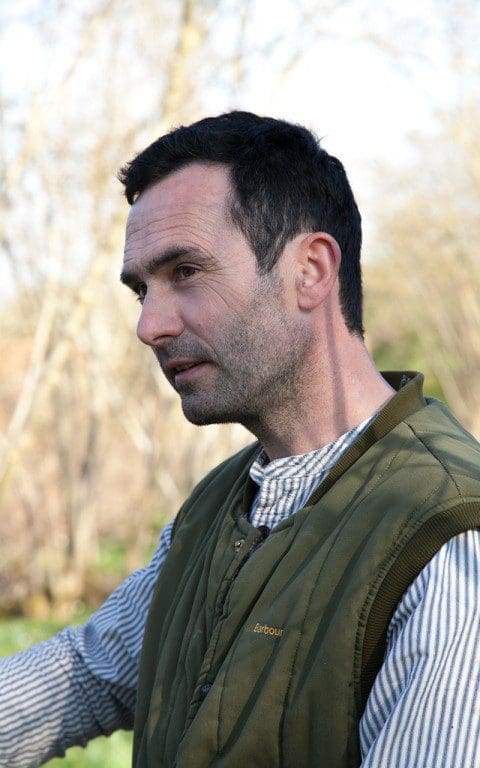 Head Gardener, Troy Scott-Smith
Head Gardener, Troy Scott-Smith
By way of introduction Troy had sent me his manifesto before my first visit. When he applied for the role as Head Gardener he talked openly of the need for change and, to the credit of the National Trust, they employed him to implement this vision. He absolutely did not see this as change for change’s sake, but a means of recapturing the potent sense of place that Vita Sackville-West celebrated in her writing about the garden that she and Harold Nicolson had made at Sissinghurst Castle; a garden inextricably linked to the buildings it surrounded and, in turn, the Kentish farmland and countryside that swept up to its walls.
Troy saw the need for the place to be unlocked again from the rigour that had become the way that people came to know the garden after the death of Vita and Harold in the 1960’s. A challenge perhaps for the most famous garden in the country but, for one with such good bones, a new era of excitement.
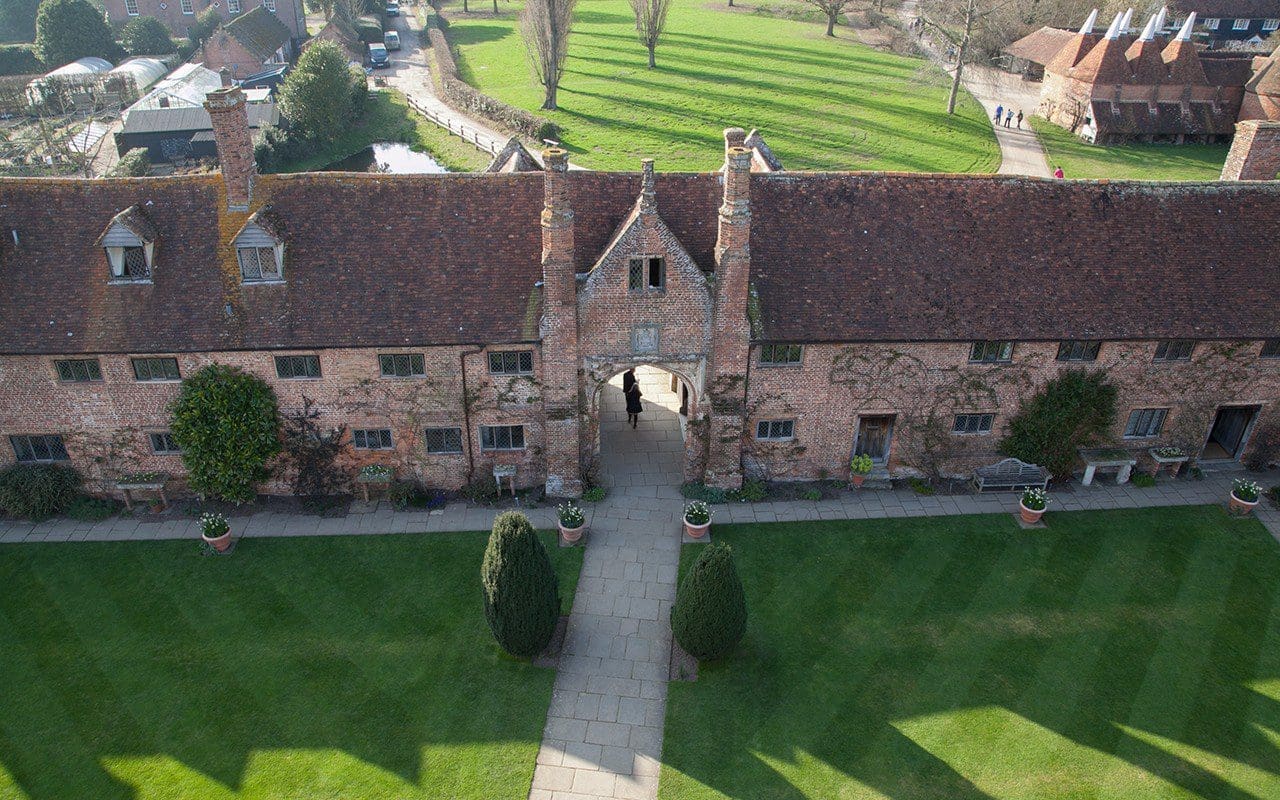 The Top Courtyard
The Top Courtyard
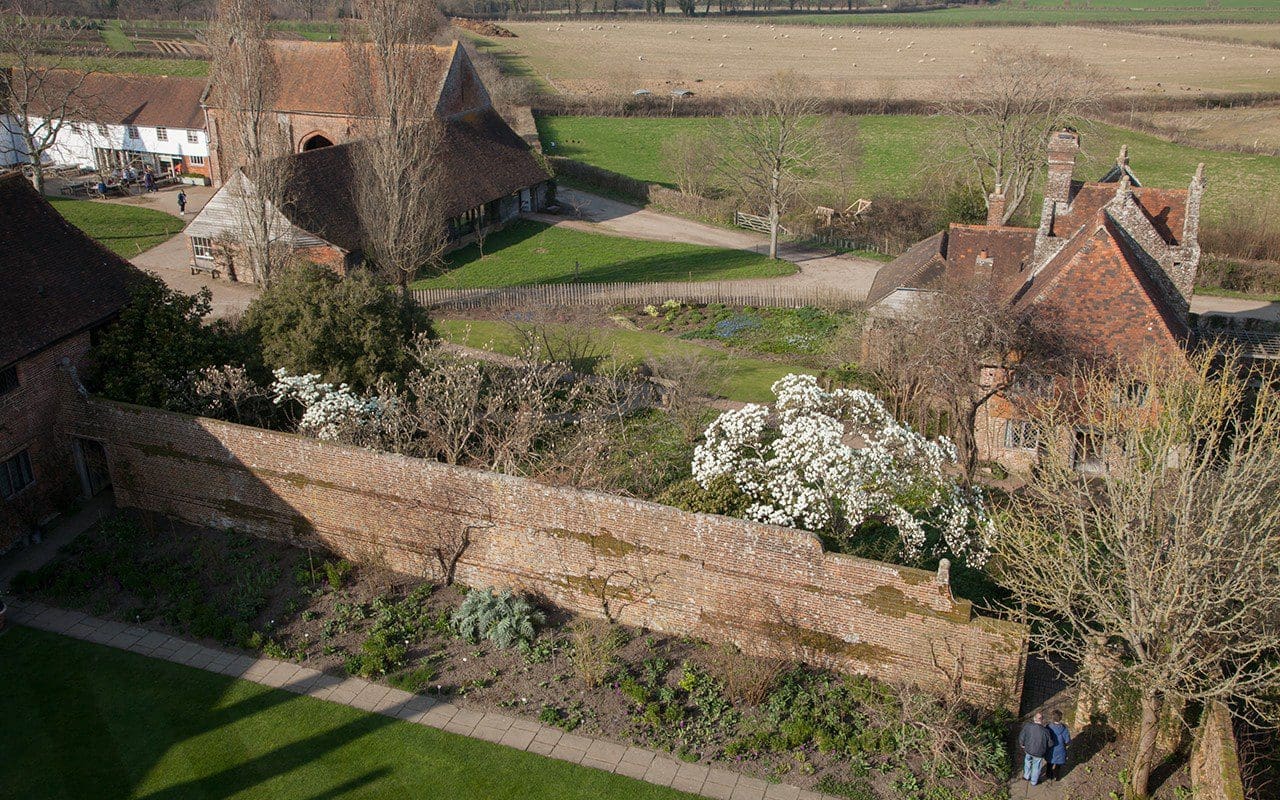 Beyond the wall of the Top Courtyard is Delos
Beyond the wall of the Top Courtyard is Delos
 The White Garden
The White Garden
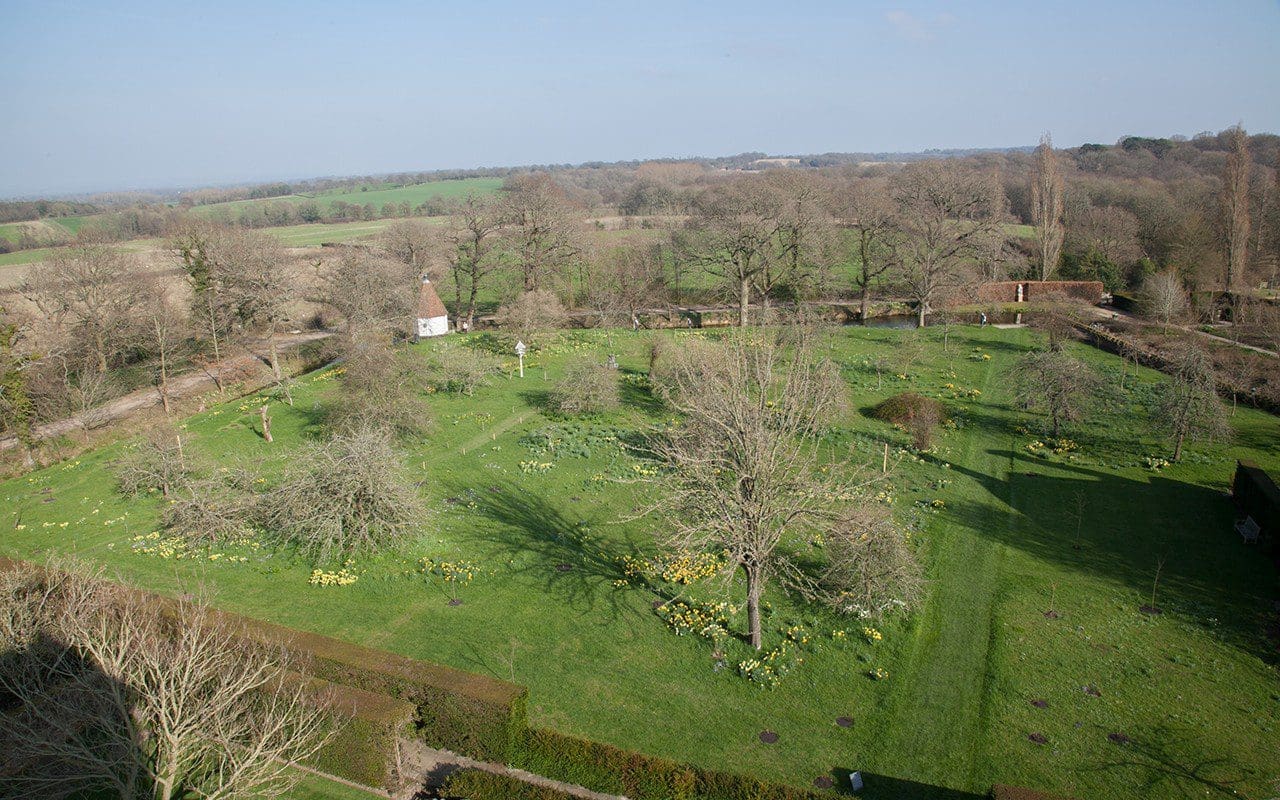 The Orchard
The Orchard
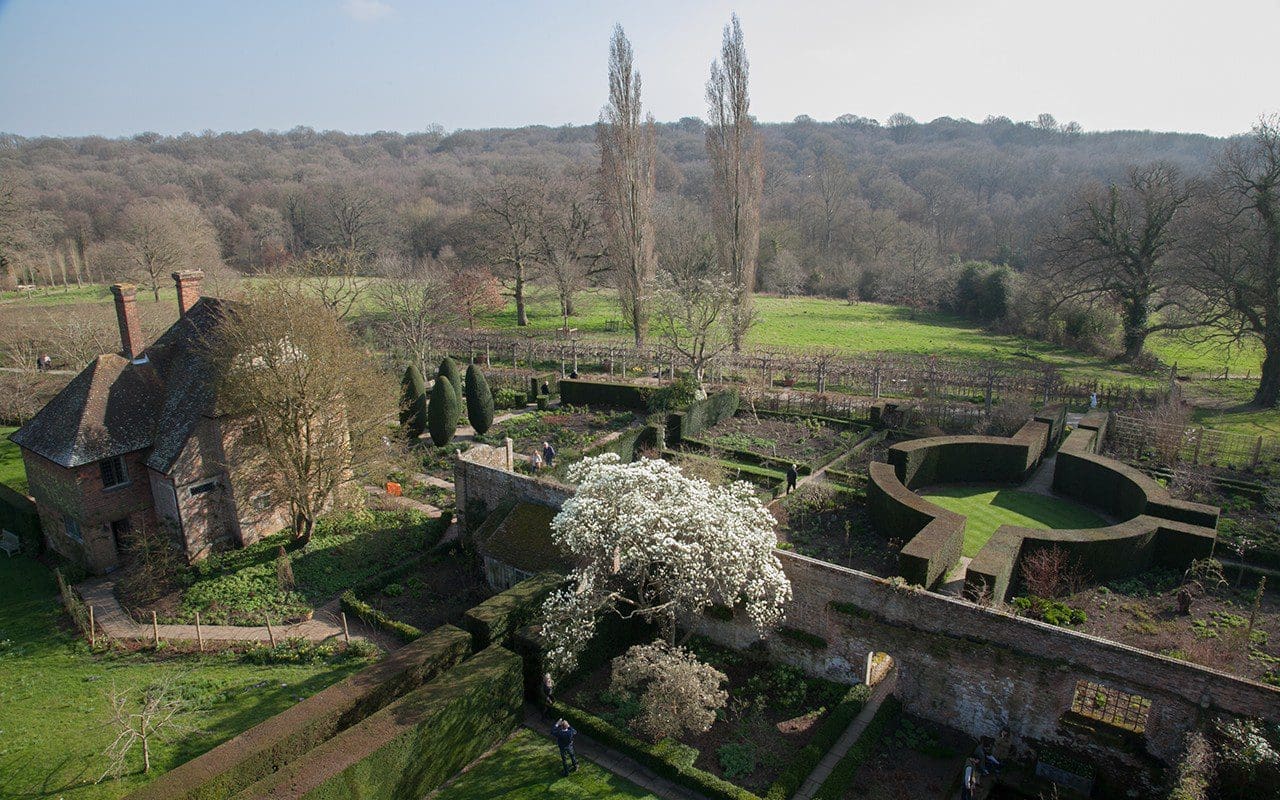 The Cottage Garden with topiary yews (left) and the Rondel (right) with the Rose Garden to the right. The Lime Walk can be seen running to the left of the exit at the top of the Rondel.
The Cottage Garden with topiary yews (left) and the Rondel (right) with the Rose Garden to the right. The Lime Walk can be seen running to the left of the exit at the top of the Rondel.
I expect that there are very few good gardens that are the product of one vision. Gardens are places where skills come together and, indeed, where they work in combination to make the whole altogether stronger. Vita and Harold’s relationship was a perfect example. He with his architectural mind providing the structure and she, the romantic, the counterpoint of informality. Her writings talk of a place that was, first and foremost, lived in by its owners and where ideas and experiments did not demand year-round perfection. However, the garden then did not have the pressures it has now with up to 200,000 visitors a year. Mulleins breaking into the paths could be negotiated and roses reaching beyond their allocated space were free to reign.
Vita wrote well about her gardening experiences and possessed a powerful vision, but she was not a professional gardener. She was learning as she evolved the garden and, like all of us, her mistakes and failures were probably as numerous as her successes. Clambering roses overwhelmed the apple trees to bring them down where their vigour wasn’t matched, and some areas of the garden were simply allowed to recede into the background when out of season. There were bold and visionary moves, such as the tapestry of polyanthus in the Nuttery that would ultimately fail to disease and need rethinking.
When the National Trust took over in 1967, five year’s after Vita’s death, an inevitable tightening up eventually saw the garden reach extraordinary horticultural heights in the hands of Pam Schwerdt and Sibylle Kreutzberger who worked with Vita from 1959 until she died, but went on to make the garden their own during their 30 year tenure as joint head gardeners. Pam and Sibylle’s prowess with plants was a large part of what brought visitors to Sissinghurst in their droves in the 1970’s and ’80’s, securing its place as one of the most influential gardens in the world. The way the garden became was ultimately driven by the need to provide for increasing numbers of visitors and, in so doing, the intimate sense of place was slowly and gradually altered.
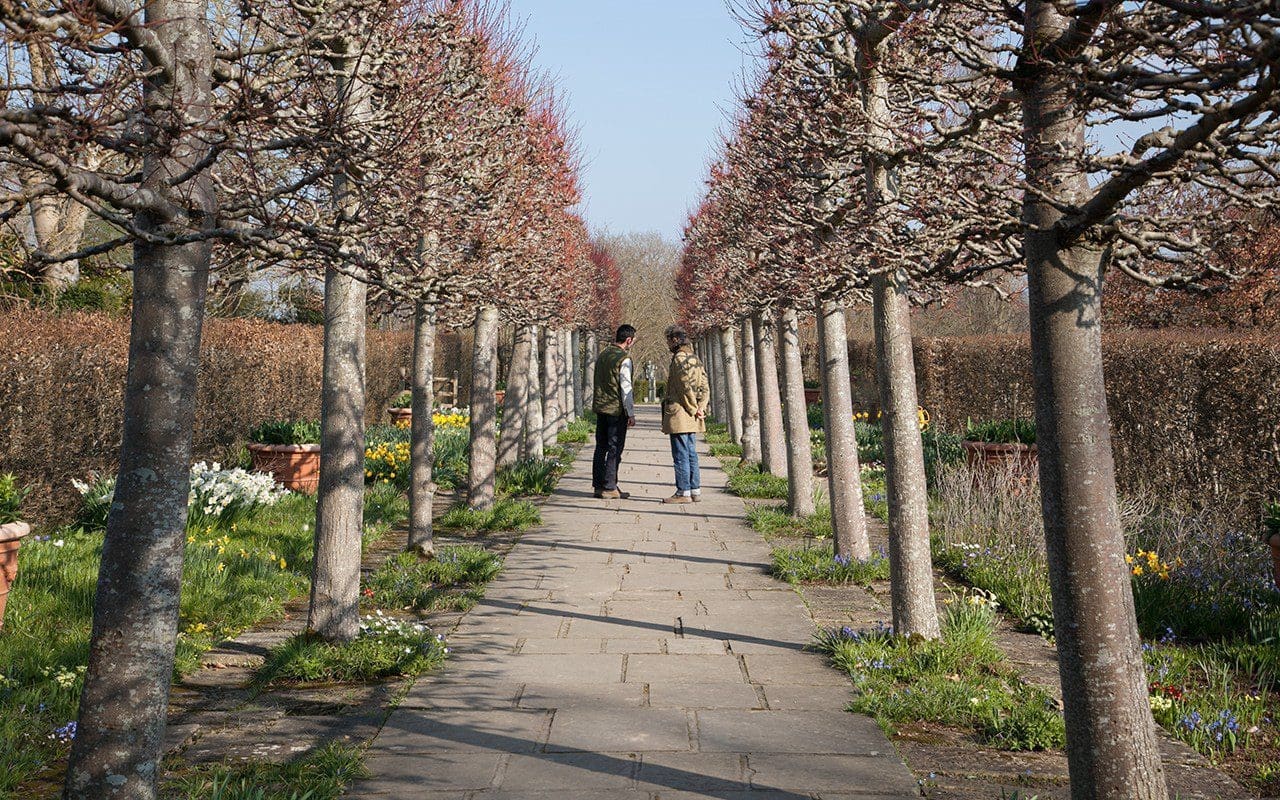 Troy and Dan in the Lime Walk
Troy and Dan in the Lime Walk
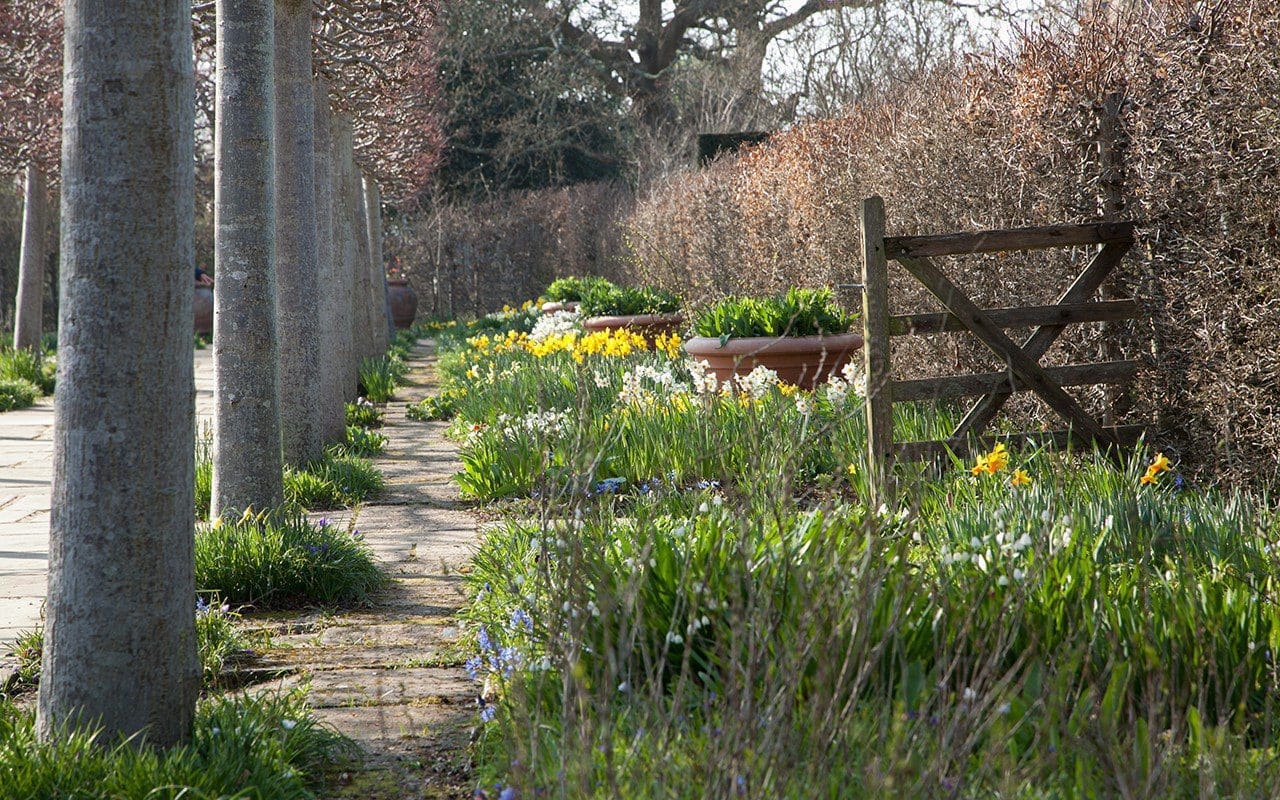 The Lime Walk
The Lime Walk
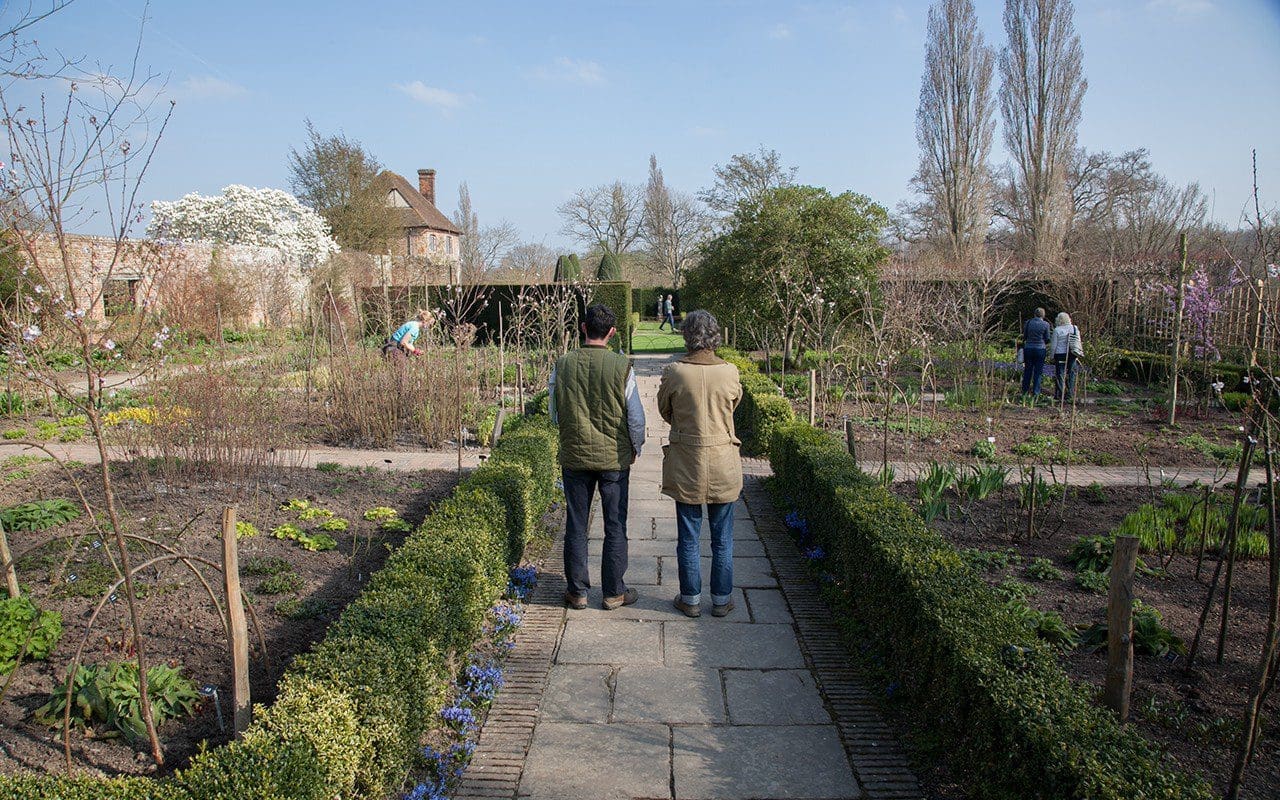 In the Rose Garden
In the Rose Garden
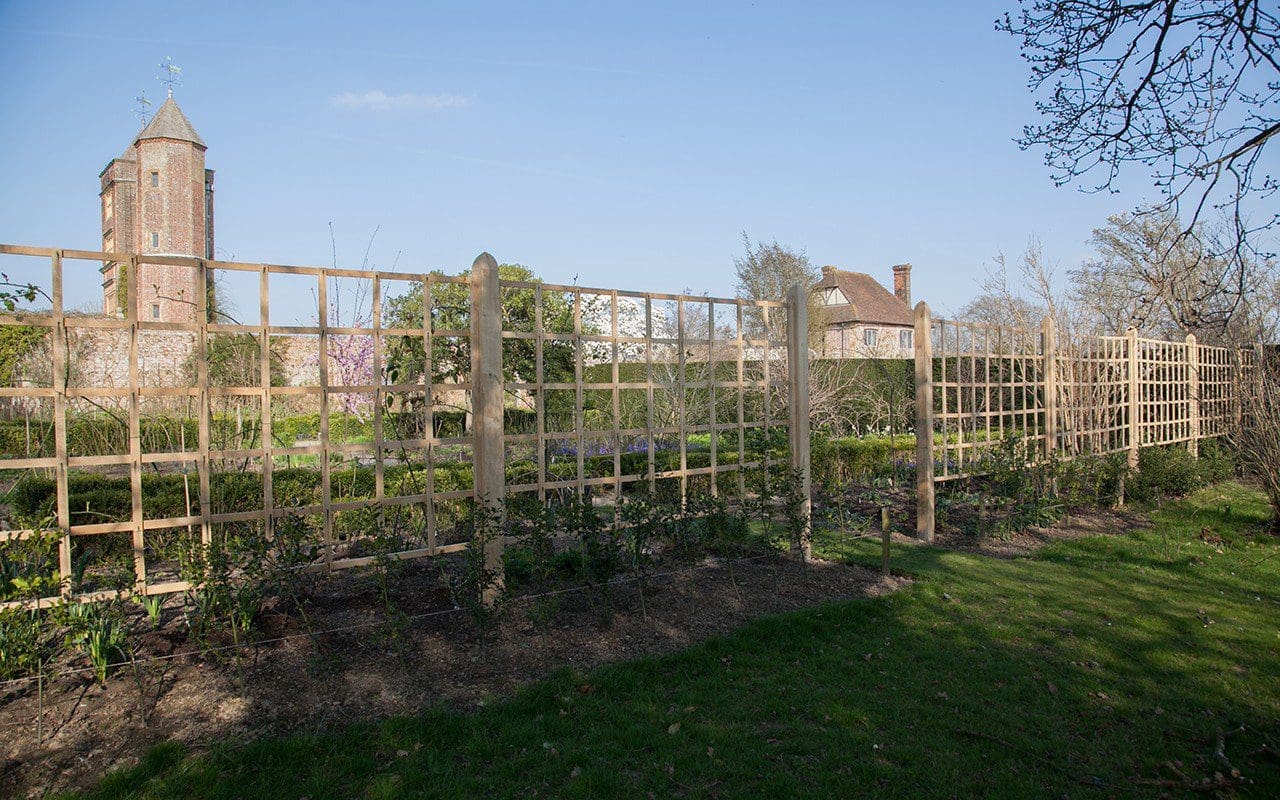 New oak trellis in the Rose Garden
New oak trellis in the Rose Garden

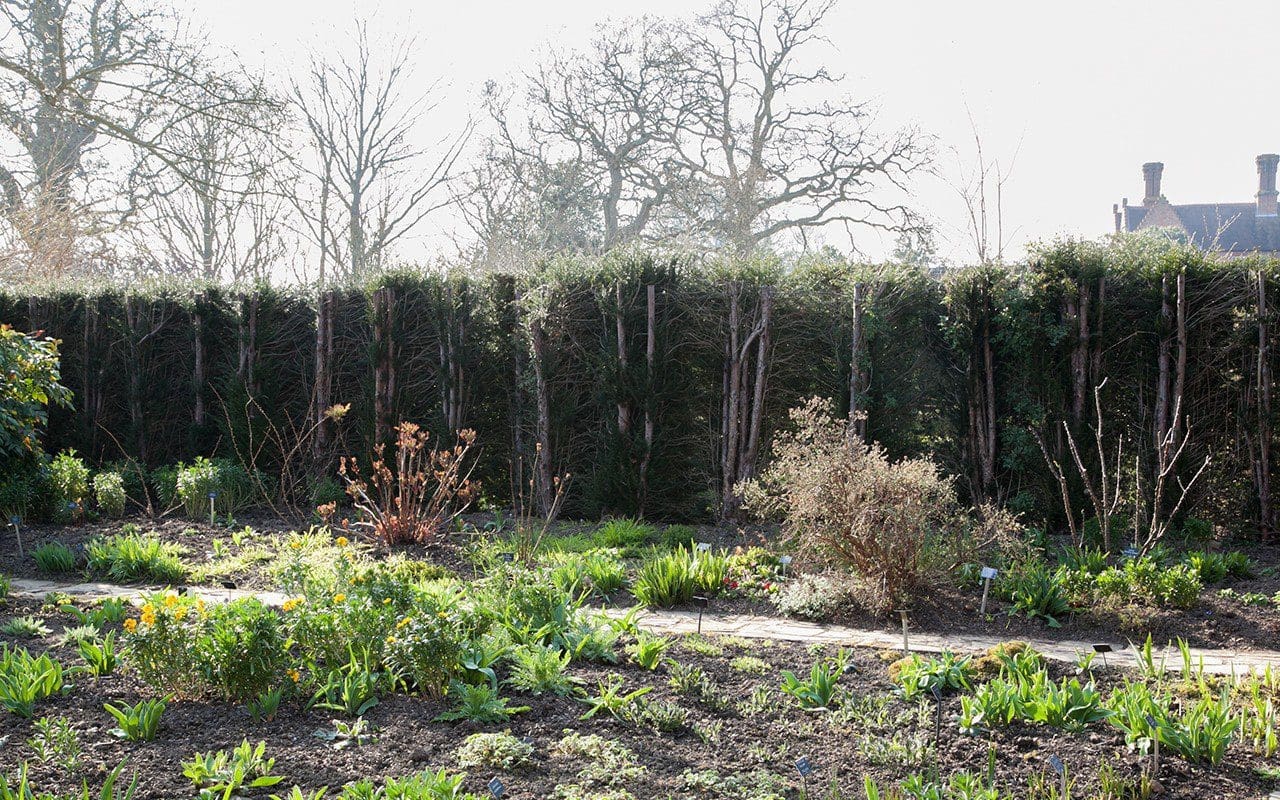 Yew hedges are gradually being reconditioned with hard pruning
Yew hedges are gradually being reconditioned with hard pruning
I have known Sissinghurst since I was a child. My father and I would visit every summer and walk its enclosures with notebooks in hand. I remember very distinctly the feeling of awe and then panic fused with disappointment that we would simply never be able to garden to this level of perfection. So we would drive on determinedly to Great Dixter to take the antidote of a garden living and breathing its owner and not attempting to garden with belt and braces. Even when the blueprint is strong gardens can easily assume a different character, for a garden is really the gardener.
And now Troy is slowly and gently making changes. He has turned the lawns at the approach into meadow and reinstated an old cart pond. There is a new hoggin entrance and there is talk of returning some of the brick and stone paths in the gardens to grass. If they wear, people will be redirected until the grass recovers, to preserve the calm and intimacy of the softer surface.
Roses that were tightly trained against the walls were given a couple of years off to reach away from their constraints. New apple trees have replaced old and the cigar-shaped yews in the Top Courtyard are being allowed to grow out into a looser shape, as they were in Vita’s day. The Little North Garden (formerly the Phlox Garden) was for years made inaccessible from the White Garden after the steps were removed in 1969. It has been reconnected with new steps which will provide another way out when the White Garden is at its peak and crowded. And Troy is planning on re-instating the phlox that once grew there in Vita’s time and after which she named it.
 The yews in the Top Courtyard are being allowed to grow out into a looser shape as they were in Vita’s day
The yews in the Top Courtyard are being allowed to grow out into a looser shape as they were in Vita’s day
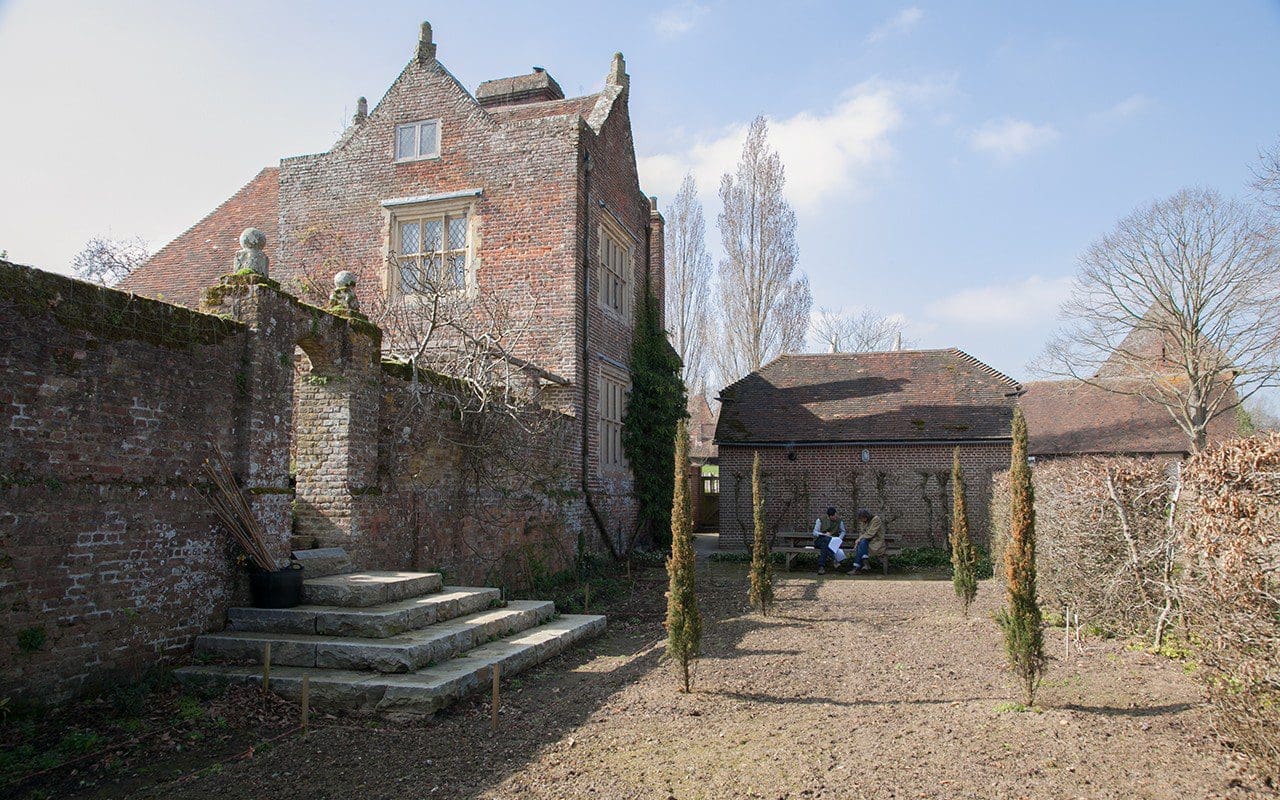 Discussing Troy’s planting plans for the Little North Garden. The new stone steps lead up to the White Garden.
Discussing Troy’s planting plans for the Little North Garden. The new stone steps lead up to the White Garden.
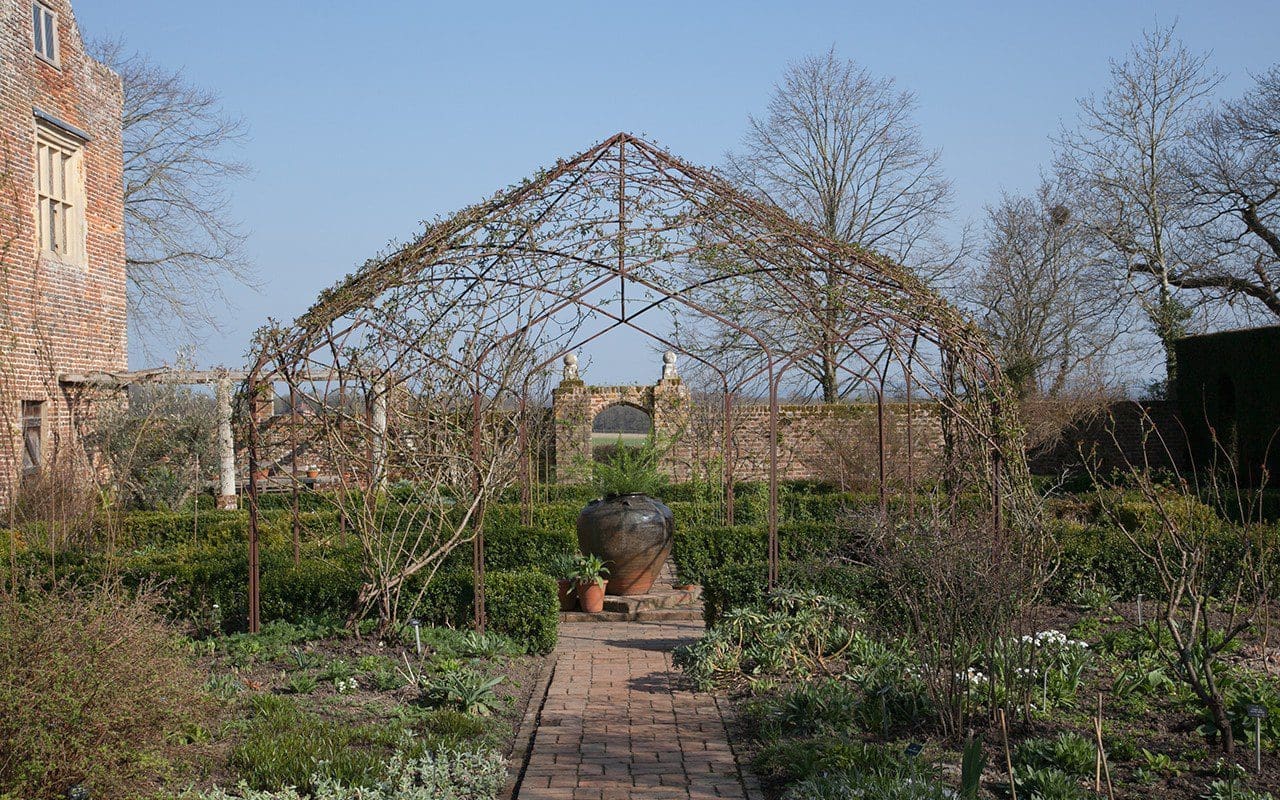
The White Garden. The Little North Garden is reached through the arch in the boundary wall.
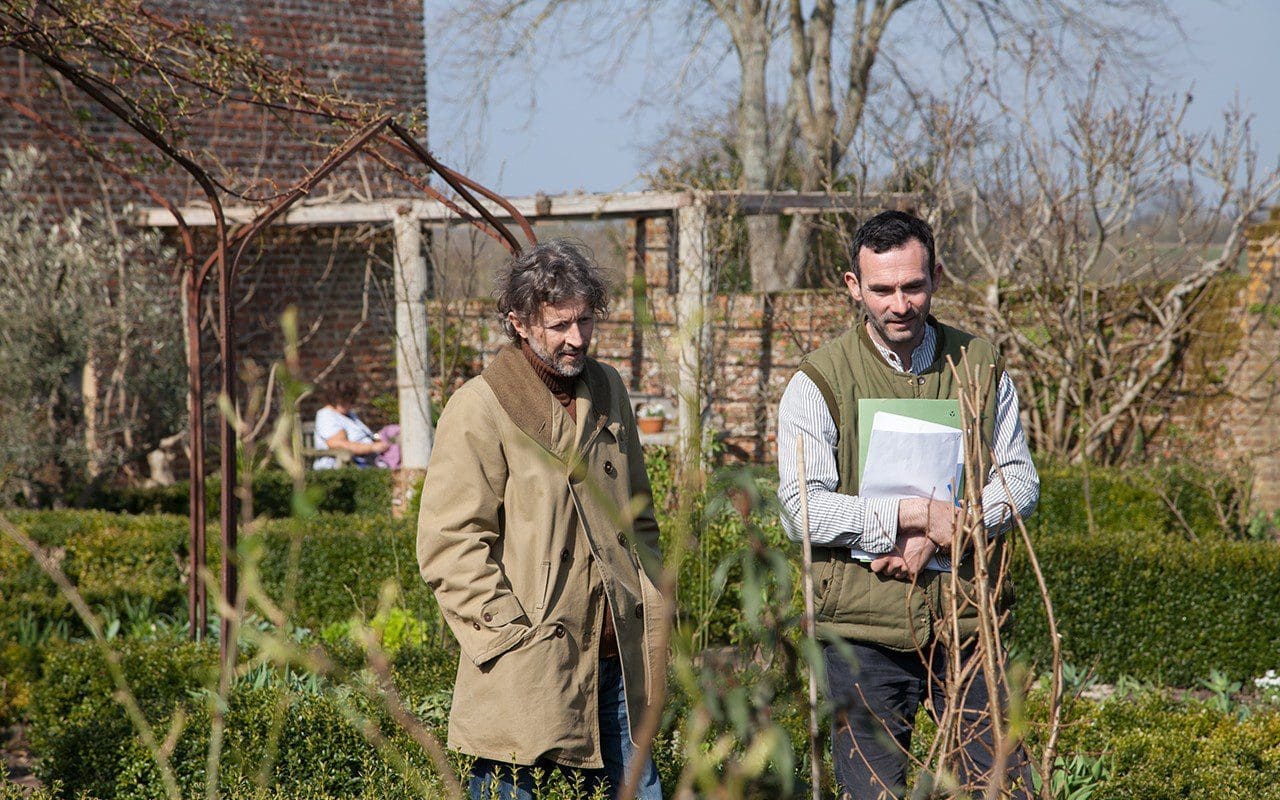 Dan and Troy discuss recent new additions to the White Garden
Dan and Troy discuss recent new additions to the White Garden
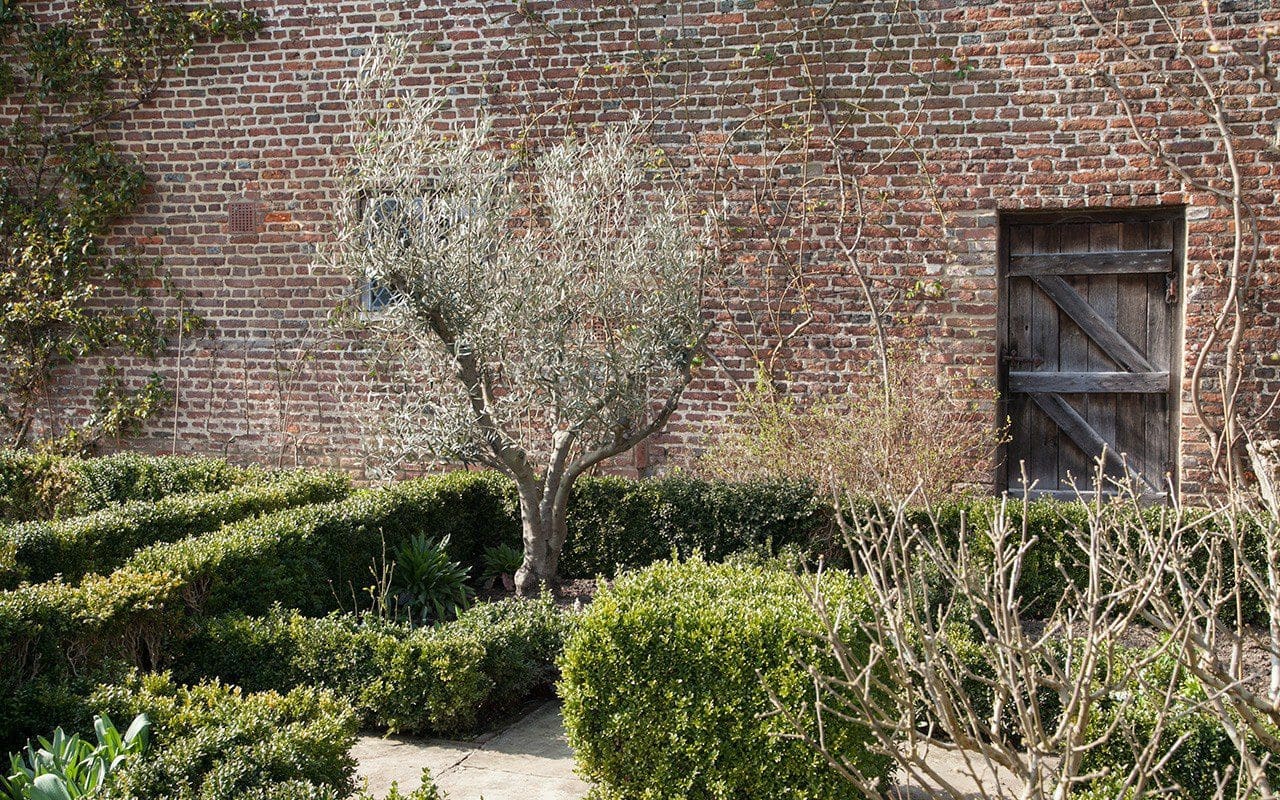 A newly planted olive in the White Garden
A newly planted olive in the White Garden
For years the Kentish Weald was the driving force and counterpoint to the formality of the garden and its enclosures, so we have talked of taking pressure off the garden and of making it less introverted, opening it up again to the land around it. The Nuttery has been enlarged, with new coppice hazels, a softer secondary path and a permeable fence boundary to the fields beyond. By removing the later addition of the hedge along the Nuttery, the field and the lake it flanks instantly provide a visual decompression. There is now talk of allowing people into the meadow and down to the lake so that, when the garden is busy, it provides an overspill area. After many years without them, Troy is also planning to reinstate Vita’s massed plantings of polyanthus in some areas.
 The Nuttery
The Nuttery
 Original stone path in the Nuttery
Original stone path in the Nuttery
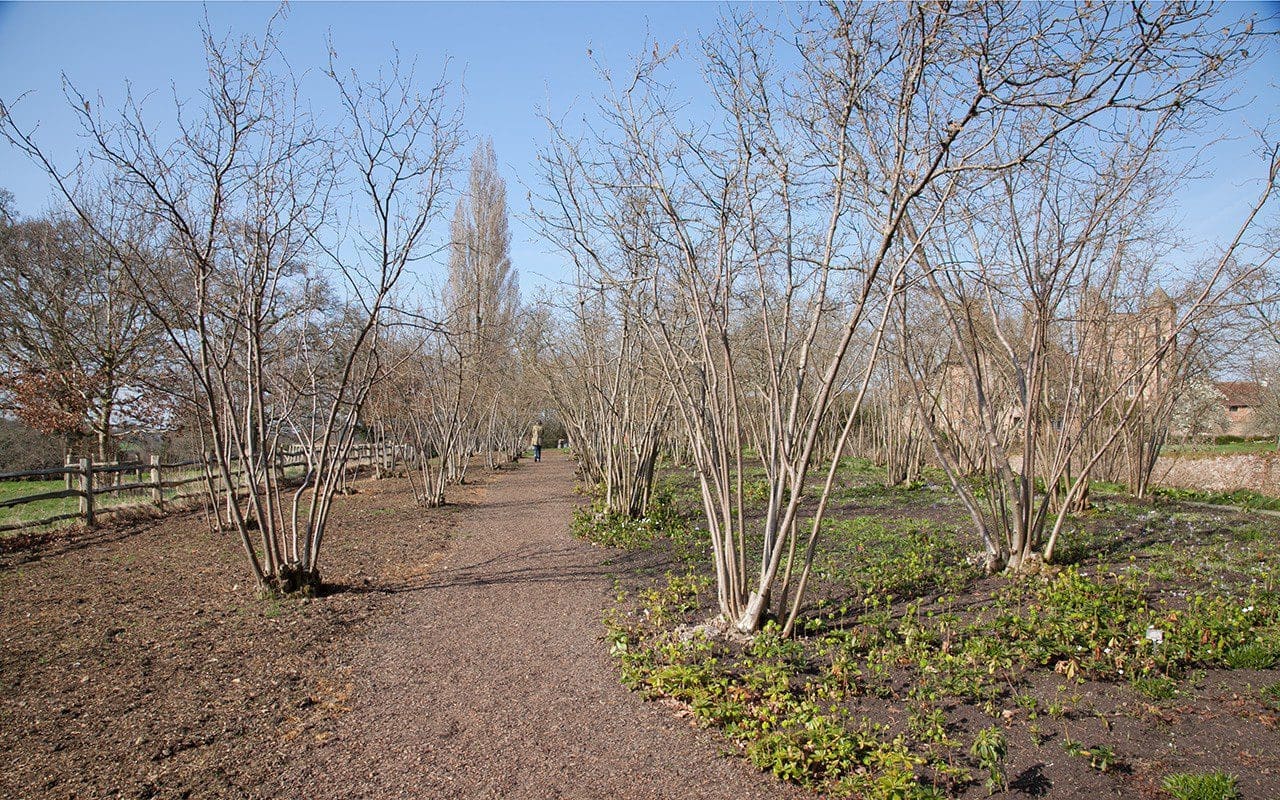 New soft path in the Nuttery, with additional coppice hazel and visually permeable split chestnut fencing
New soft path in the Nuttery, with additional coppice hazel and visually permeable split chestnut fencing
Last year, Joshua Sparkes, one of the enthusiastic young gardeners working with Troy, won a scholarship to visit Delos, the inspiration for one of the garden areas that has lost its way. Vita and Harold had been inspired by the Greek island and had strewn the area beyond the Top Courtyard with a small number of artefacts and stone walls to conjure a Greek hillside. Facing north and with exposure to the winds from across the fields, the site was not the ideal place to try such an experiment.
Later incarnations saw the garden protected on the windward side with a hedge of Pemberton roses and a canopy of magnolias took over to provide more shade, which subsequently saw the garden become home to primarily woodland plants. However, Troy has a little grove of cork oaks waiting in the nursery and Joshua’s research has identified a number of Greek natives to bring out the spirit of the place again. It may not be exactly as Vita and Harold had intended, but they wouldn’t have stood still either. As gardeners I have the feeling they would have embraced change and all the excitement and energy that comes with it.
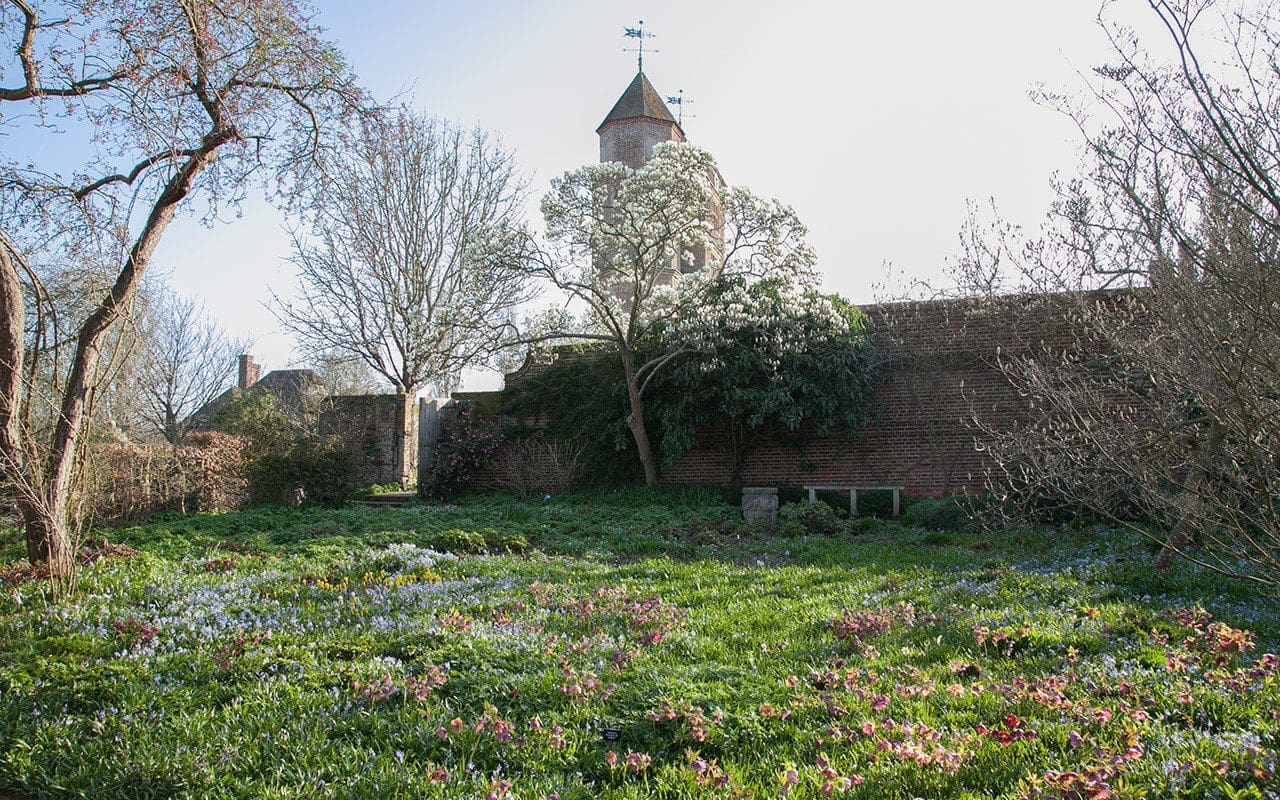 Delos
Delos
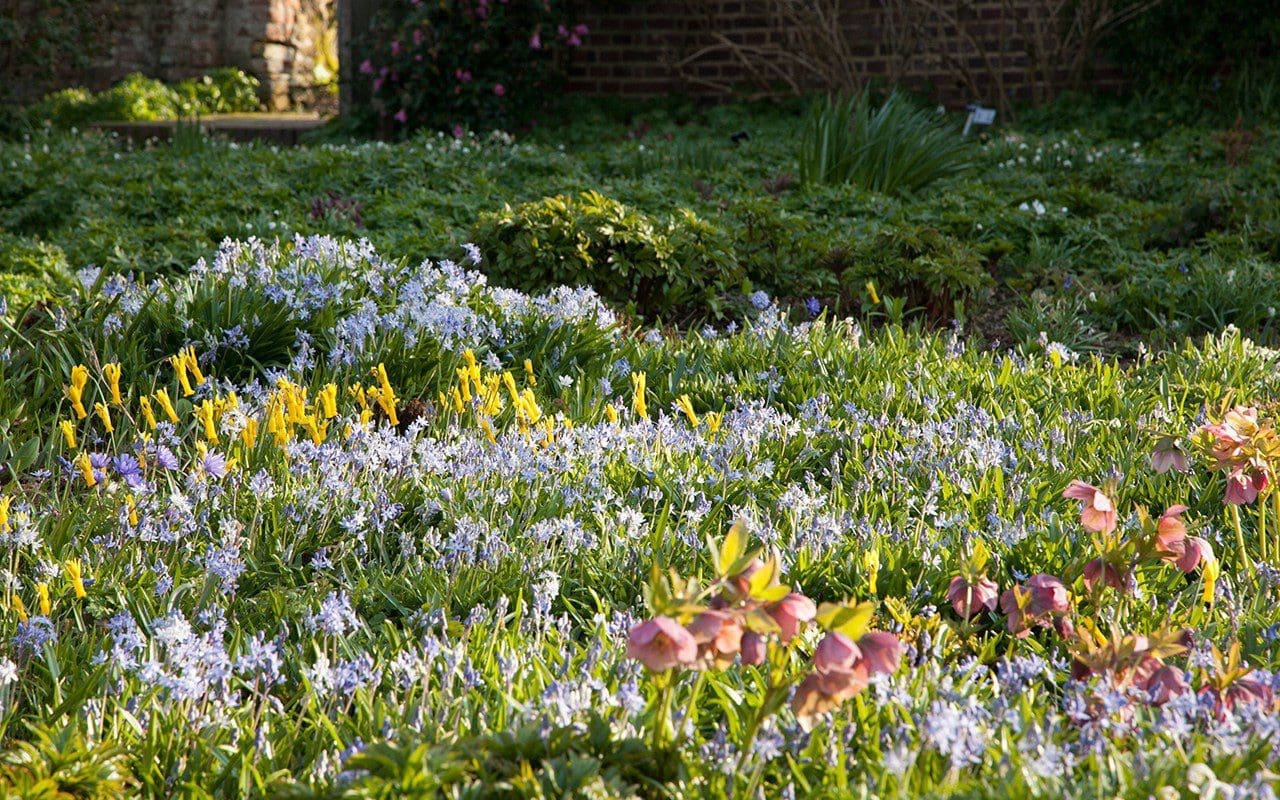 Spring planting in Delos
Spring planting in Delos
Words: Dan Pearson / Photographs: Huw Morgan
I have just returned from my annual visit to the Millennium Forest in Hokkaido. I have been making the journey back to Japan since the Meadow Garden was completed nine years ago and it is a privilege to be able to return to tune and evolve the planting. Each year my visits are timed to a slightly different week in the growing season. This year in the autumn to concentrate on a new layer of planting designed to extend the season to its limit. On my last day there a sharp wind from Siberia whipped over the mountains to toss the asters and the miscanthus and gave the mountain peaks their first showing of snow. The beginning of a winter that very soon will work its way into the garden to envelop it in a five-month eiderdown of whiteness. My visits have allowed me to build a bond with Midori Shintani, the more than capable head gardener. Without her the garden would not be possible and we are very lucky to be able to communicate and to discuss the nuances of the planting so easily. Through the garden we have become friends and, for the past few years, we have taken a few days after our annual workshops to visit other parts of Japan. Last year it was to see the studio and garden of my great hero Isamu Noguchi on the island of Shikoku, but this year we stayed in Hokkaido, driving west to the capital, Sapporo, to see Moerenuma Park the sculptor’s last, and posthumous, work. The construction of the site started in 1982 as a greenbelt initiative to convert a waste treatment plant into a place that people could use. Nestled into a bend in the river on the outskirts of the city, the park now extends to 183 hectares and the completed landscape took a total of 23 years to build. In 1988 Noguchi was approached by the city to design and masterplan the park. He first visited the site in July and presented his masterplan concept in the form of a three dimensional model in November. He died, aged 84, the same December.
It is a testament to the city and to the Noguchi Foundation that the masterplan was followed so rigorously, for it is a hugely ambitious project. I first saw it – only two years after it’s soft opening – in the winter of 2000 under a thick blanket of snow, which completely abstracted the landscape through its unification. The genius of the place is that the landscape is considered to be one complete sculpture and, under snow, you could see it as such, like one of his tabletop maquettes or a piece of origami, the scale without the reference of detail, the boundaries apparently limitless.
Returning to see it not only completed, but also green and still clothed in autumn, was no less surreal. It is a place that makes you feel very small and insignificant. It has a monumental quality as if Noguchi had catalysed a life’s work into something that is bigger than man. Bigger than he ever was when he was living, like an exploded ego. And he is everywhere.
The construction of the site started in 1982 as a greenbelt initiative to convert a waste treatment plant into a place that people could use. Nestled into a bend in the river on the outskirts of the city, the park now extends to 183 hectares and the completed landscape took a total of 23 years to build. In 1988 Noguchi was approached by the city to design and masterplan the park. He first visited the site in July and presented his masterplan concept in the form of a three dimensional model in November. He died, aged 84, the same December.
It is a testament to the city and to the Noguchi Foundation that the masterplan was followed so rigorously, for it is a hugely ambitious project. I first saw it – only two years after it’s soft opening – in the winter of 2000 under a thick blanket of snow, which completely abstracted the landscape through its unification. The genius of the place is that the landscape is considered to be one complete sculpture and, under snow, you could see it as such, like one of his tabletop maquettes or a piece of origami, the scale without the reference of detail, the boundaries apparently limitless.
Returning to see it not only completed, but also green and still clothed in autumn, was no less surreal. It is a place that makes you feel very small and insignificant. It has a monumental quality as if Noguchi had catalysed a life’s work into something that is bigger than man. Bigger than he ever was when he was living, like an exploded ego. And he is everywhere.
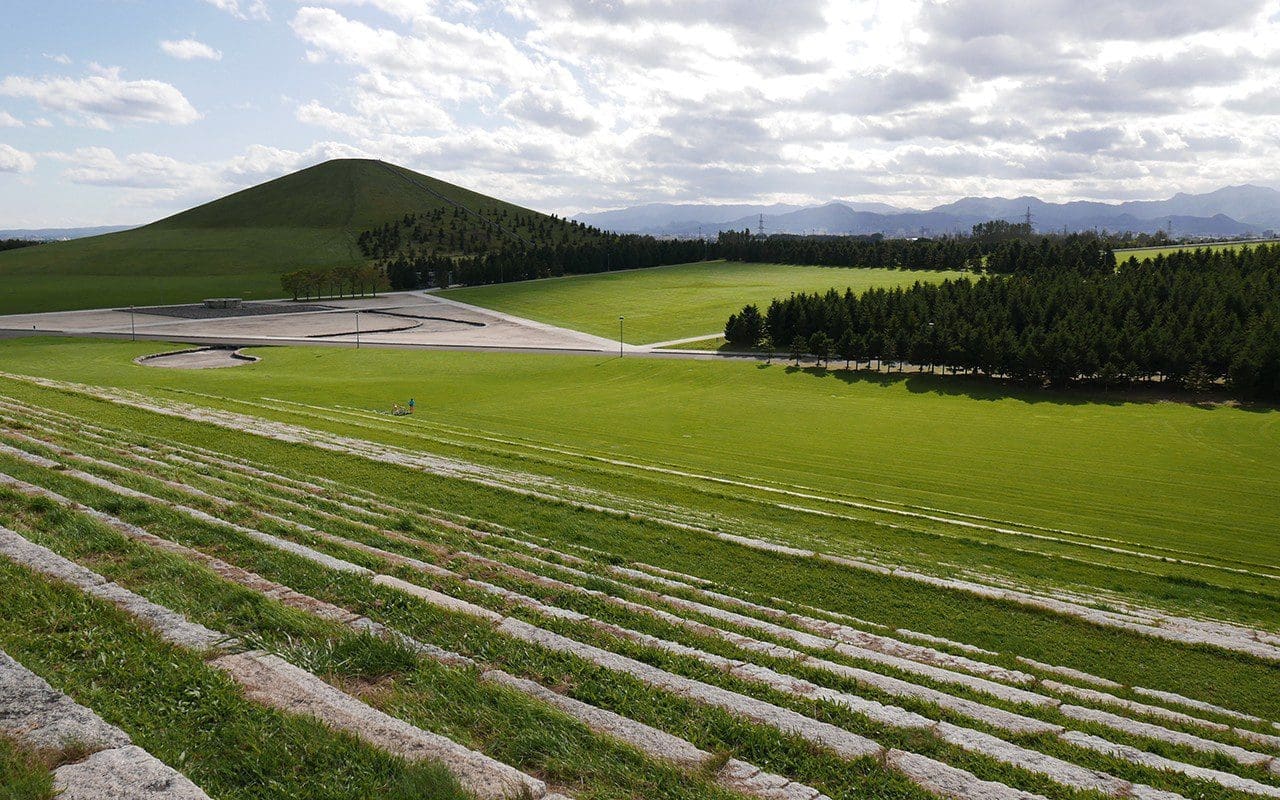 As we walked the site (and not yet knowing that he had died in the year he had visualised this landscape) and it being autumn and empty of people, the mood was already melancholy. We talked about feelings of death, infinity and the beyond as we tried to grapple with the sheer scale of it. We found ourselves pining for the activity of people and the laughter of children that had always been seen as an essential part of Moere Beach, which was unfortunately drained of water for repairs. Noguchi had wanted to bring the sea to Sapporo and this shallow pond paved with coral represents a beautiful seashore which sits on the edge of The Forest of Cherry Trees. The great wrap of cherries would be the scene of parties spread out under the blossoming at hanami. In the newly planted woods that wrap this extent of the site there are seven play areas which were designed so that, as the children lost interest in one game, they could move on to find another in the next clearing, animating the park as they went. Noguchi designed the play equipment to stand alone as brightly coloured sculptures, so that it did not matter that we were there in silence. It was good to feel the scale of things amplified by the emptiness.
As we walked the site (and not yet knowing that he had died in the year he had visualised this landscape) and it being autumn and empty of people, the mood was already melancholy. We talked about feelings of death, infinity and the beyond as we tried to grapple with the sheer scale of it. We found ourselves pining for the activity of people and the laughter of children that had always been seen as an essential part of Moere Beach, which was unfortunately drained of water for repairs. Noguchi had wanted to bring the sea to Sapporo and this shallow pond paved with coral represents a beautiful seashore which sits on the edge of The Forest of Cherry Trees. The great wrap of cherries would be the scene of parties spread out under the blossoming at hanami. In the newly planted woods that wrap this extent of the site there are seven play areas which were designed so that, as the children lost interest in one game, they could move on to find another in the next clearing, animating the park as they went. Noguchi designed the play equipment to stand alone as brightly coloured sculptures, so that it did not matter that we were there in silence. It was good to feel the scale of things amplified by the emptiness.
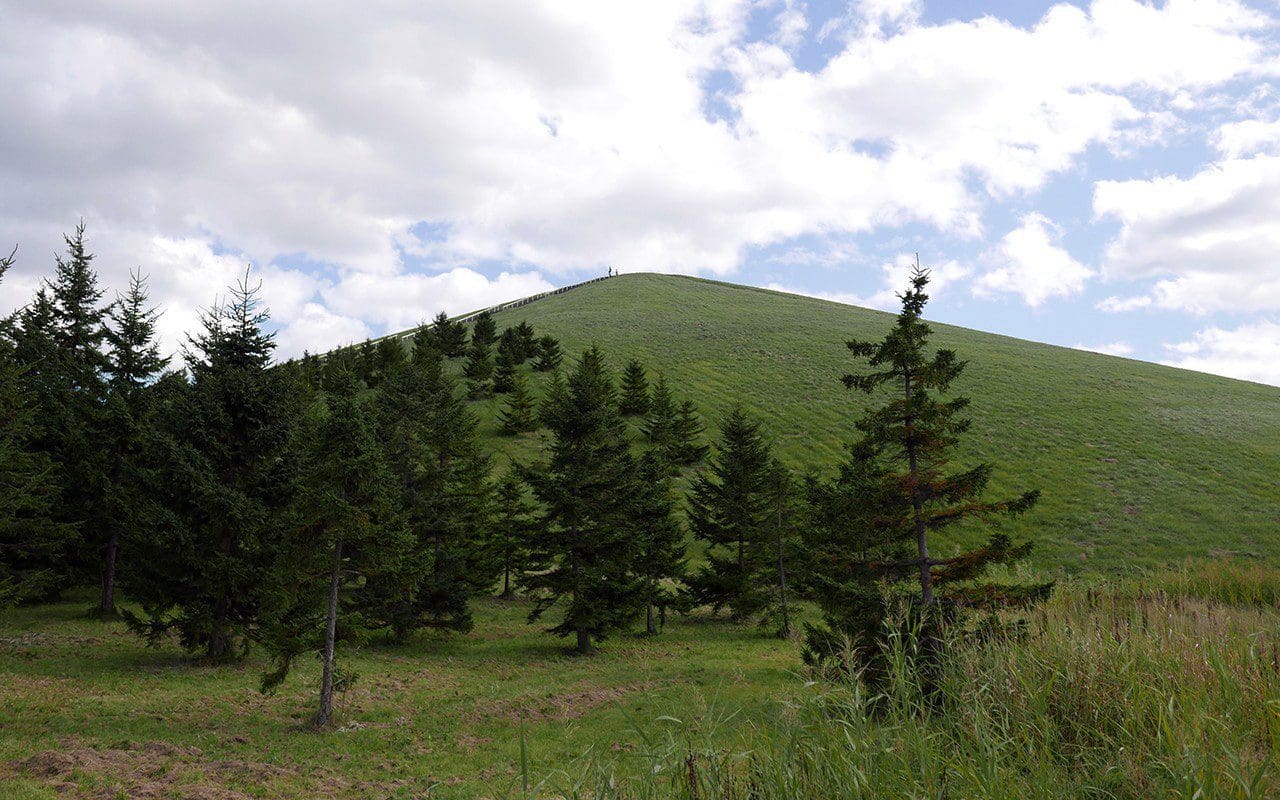

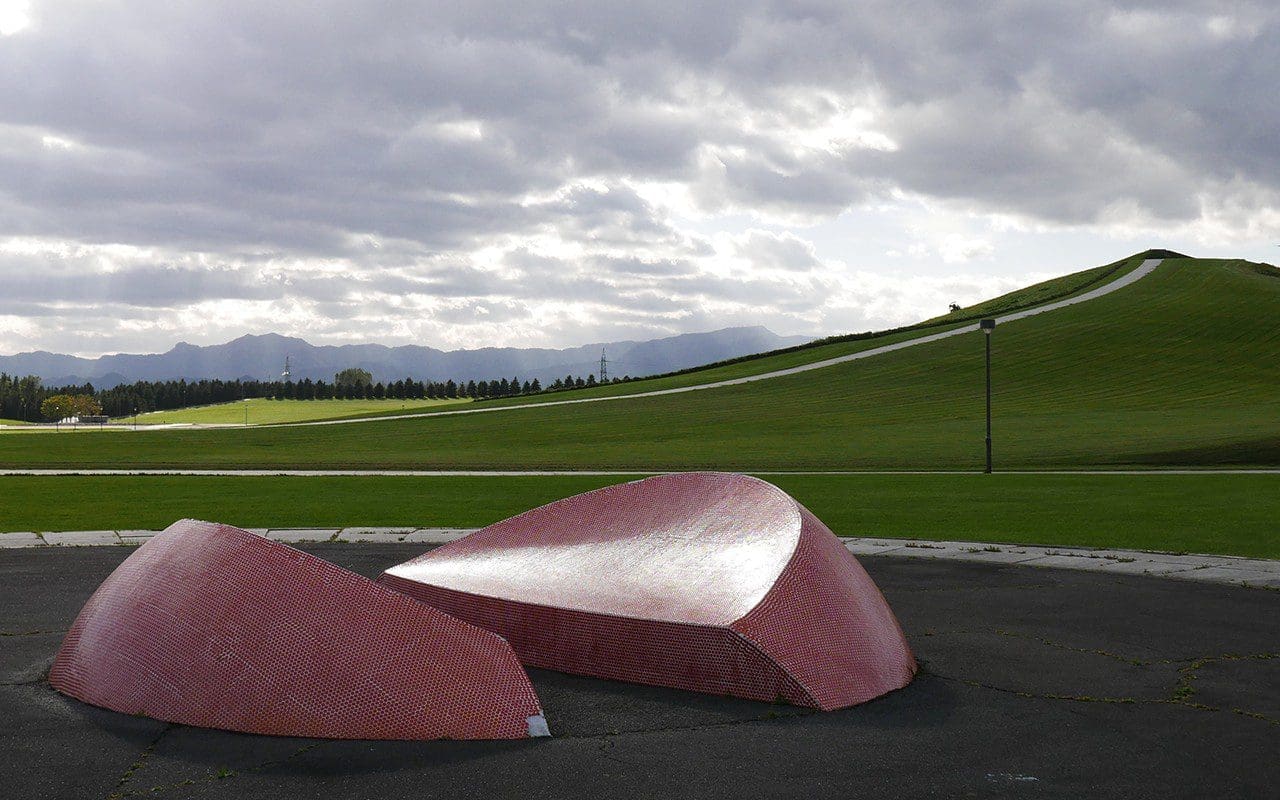

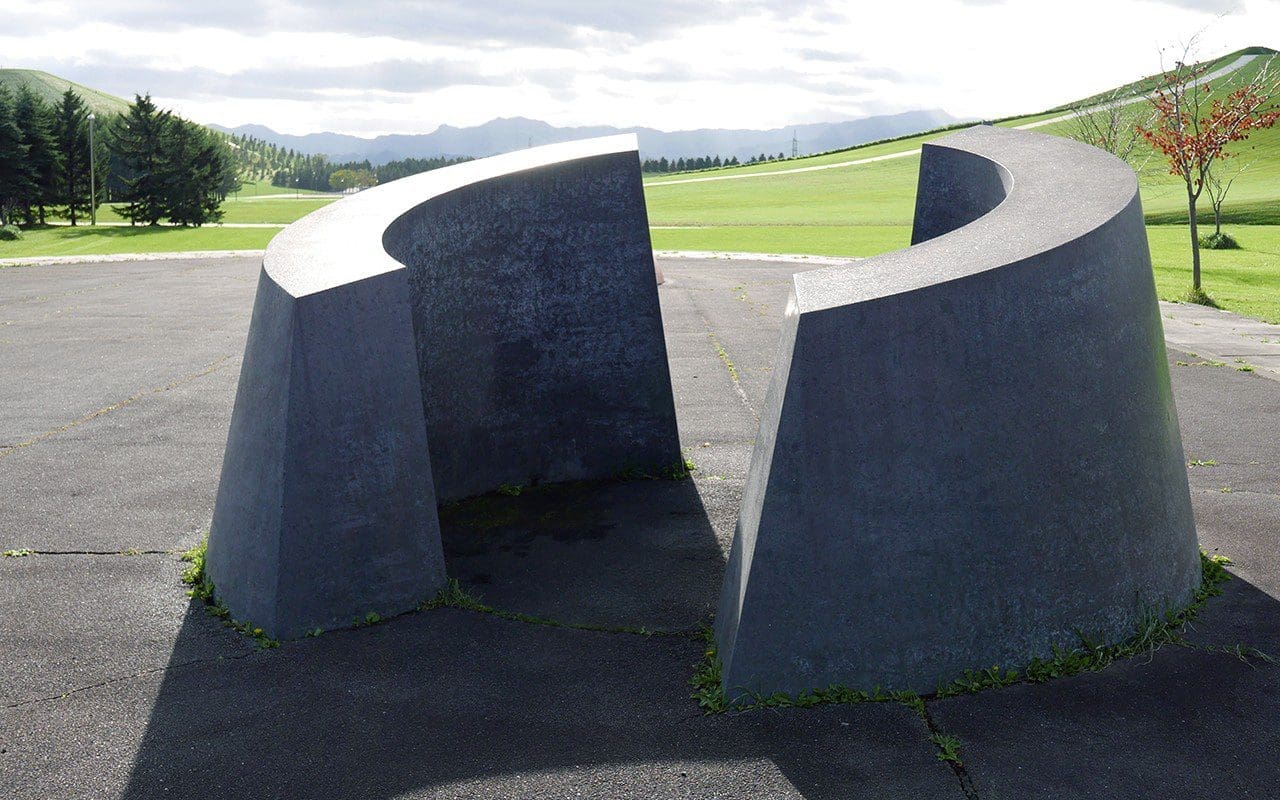
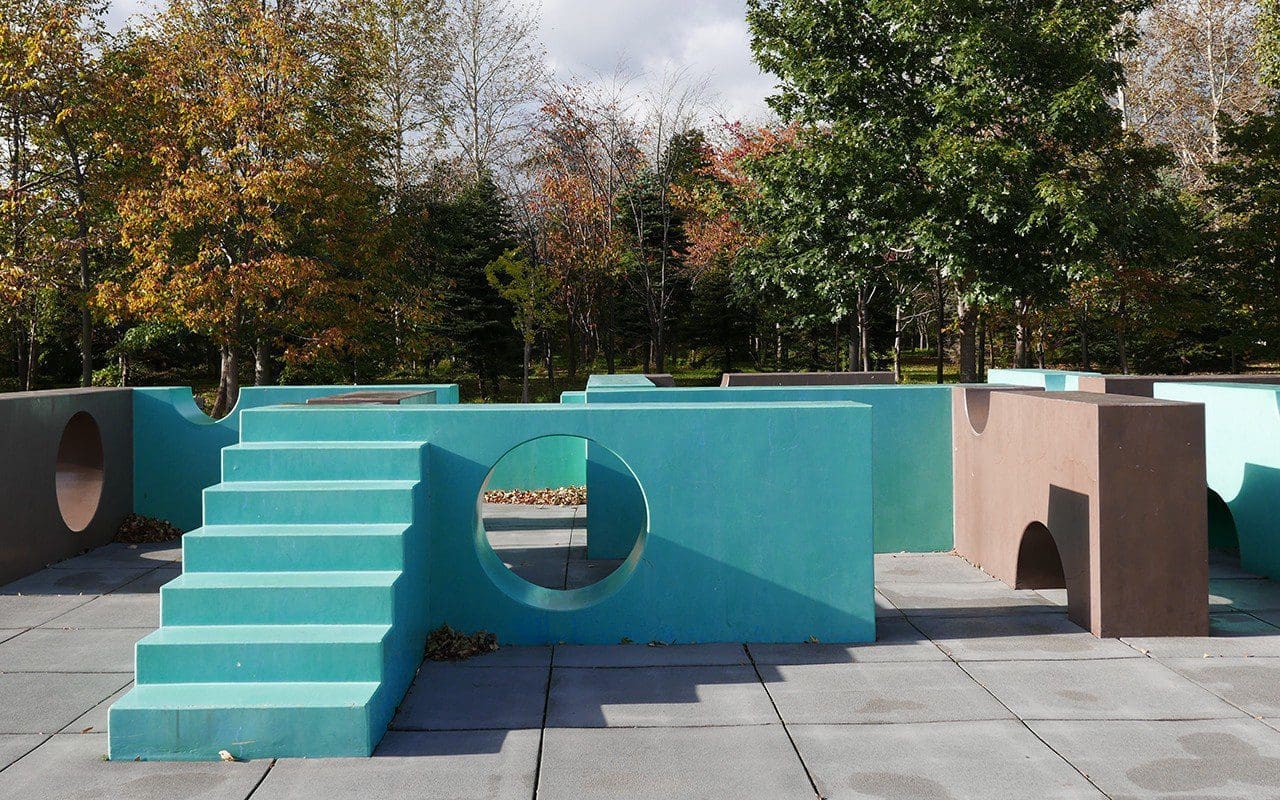 The park is dominated by two giant landforms. Mount Moere, a grass pyramid which rises to 62 metres, and the curiously named Play Mountain rising to 30 metres. Mount Moere brings a mountain into the city of Sapporo in another boldly elemental move. There is a direct route that stretches up in a perfect line to the summit and a beautifully drawn curve that allows you to traverse more gently, down a set of concrete steps on the other side. Though smaller, Play Mountain, which Noguchi first conceived in 1933 and contemplated over a long period, has a gravity and an ancient quality. At its base, the whiteness of Music Shell has a back-drop of a bank of dark conifers, so that you naturally stand on the stage of the performance space and look up. In front of you the mountain rises, one complete side stepped with granite sleepers. We joked as we ascended that it felt like we were on the way to a sacrifice. At the top (and only in Japan) a windswept bride and her groom were braving the elements for photographs.
The park is dominated by two giant landforms. Mount Moere, a grass pyramid which rises to 62 metres, and the curiously named Play Mountain rising to 30 metres. Mount Moere brings a mountain into the city of Sapporo in another boldly elemental move. There is a direct route that stretches up in a perfect line to the summit and a beautifully drawn curve that allows you to traverse more gently, down a set of concrete steps on the other side. Though smaller, Play Mountain, which Noguchi first conceived in 1933 and contemplated over a long period, has a gravity and an ancient quality. At its base, the whiteness of Music Shell has a back-drop of a bank of dark conifers, so that you naturally stand on the stage of the performance space and look up. In front of you the mountain rises, one complete side stepped with granite sleepers. We joked as we ascended that it felt like we were on the way to a sacrifice. At the top (and only in Japan) a windswept bride and her groom were braving the elements for photographs.
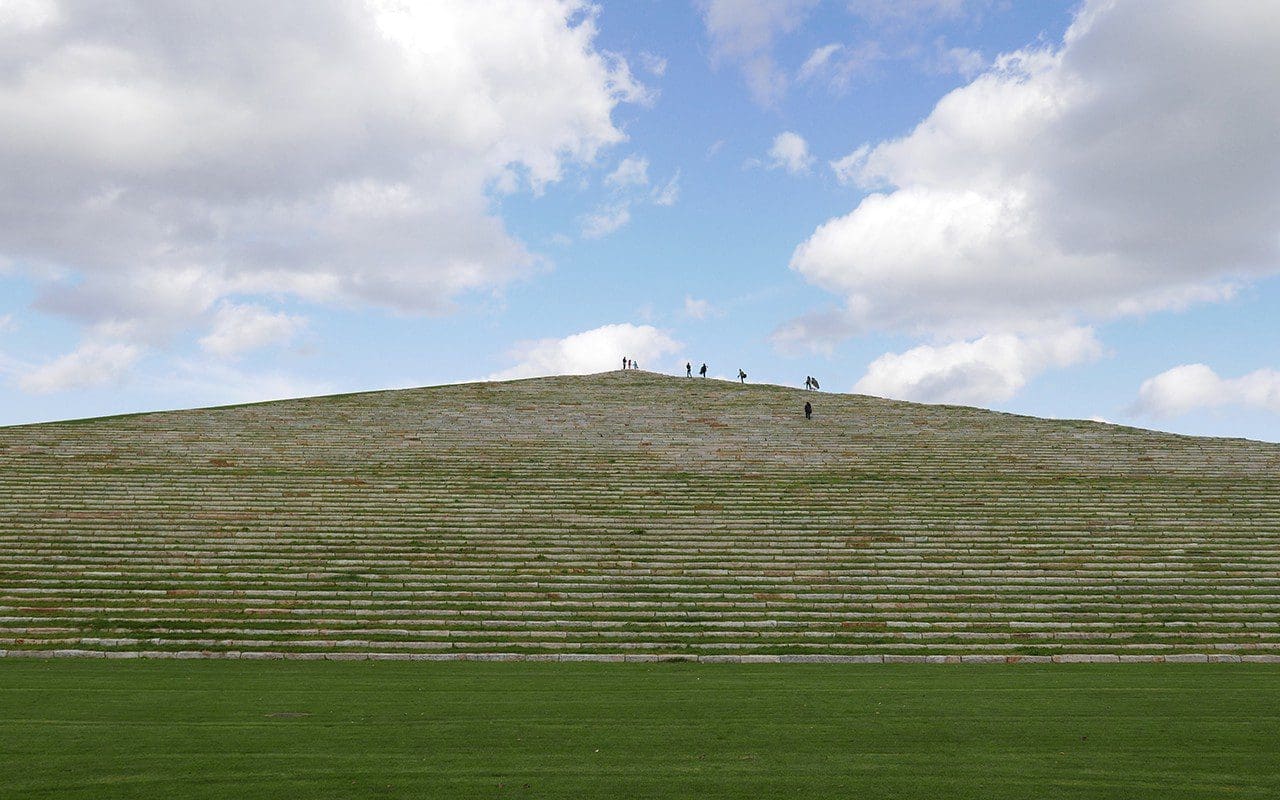
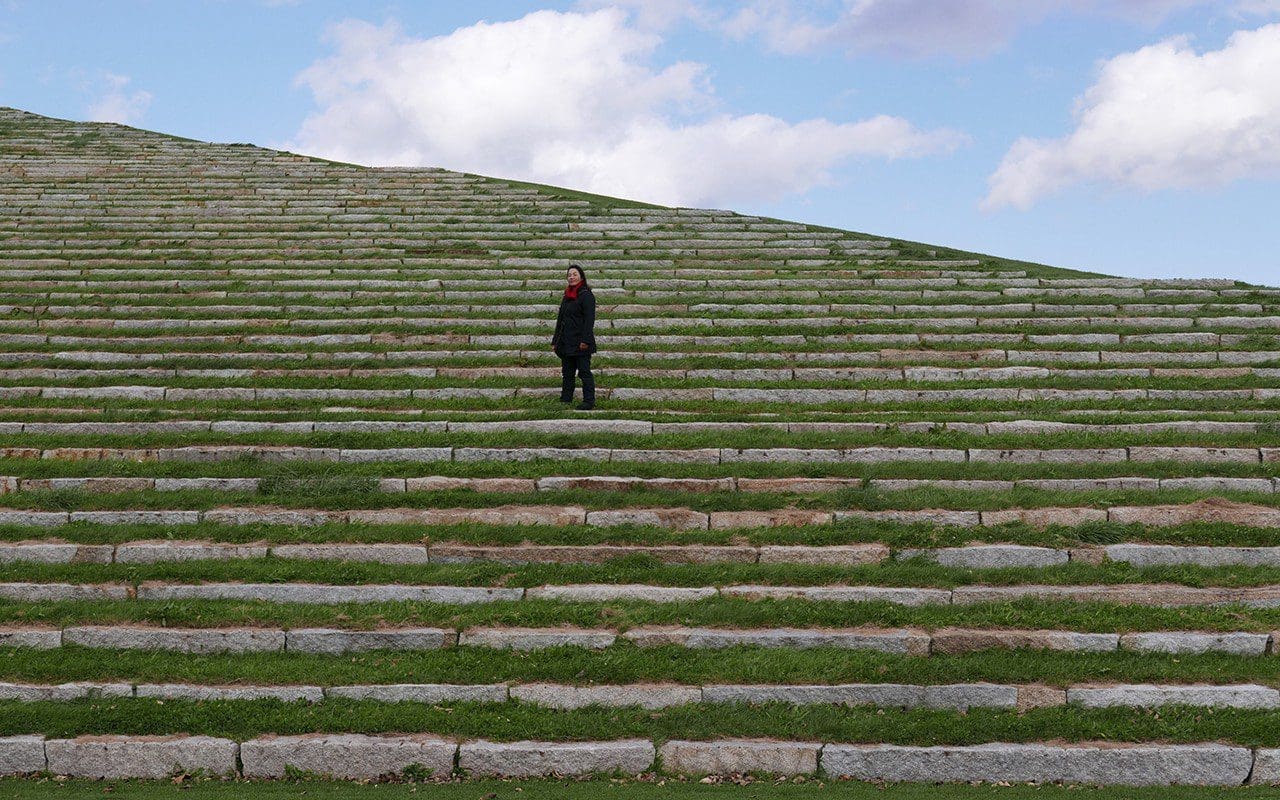
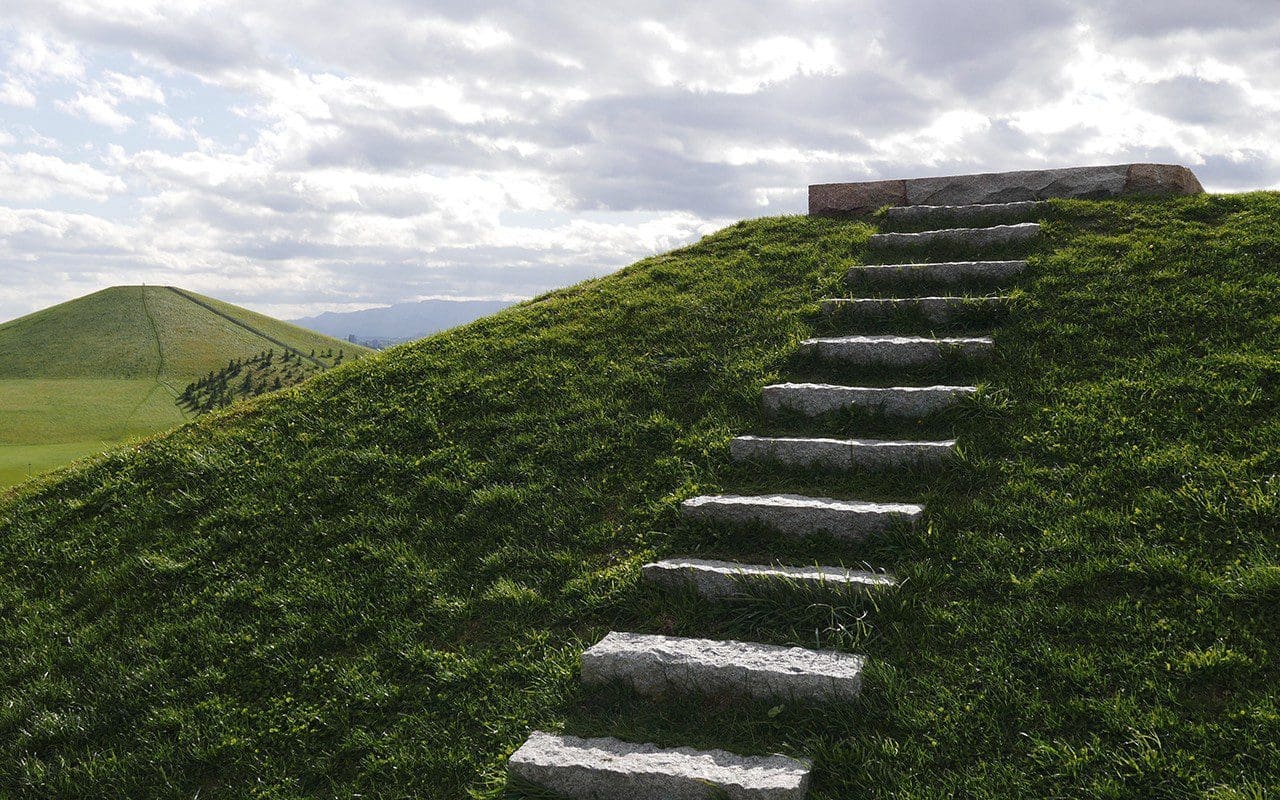
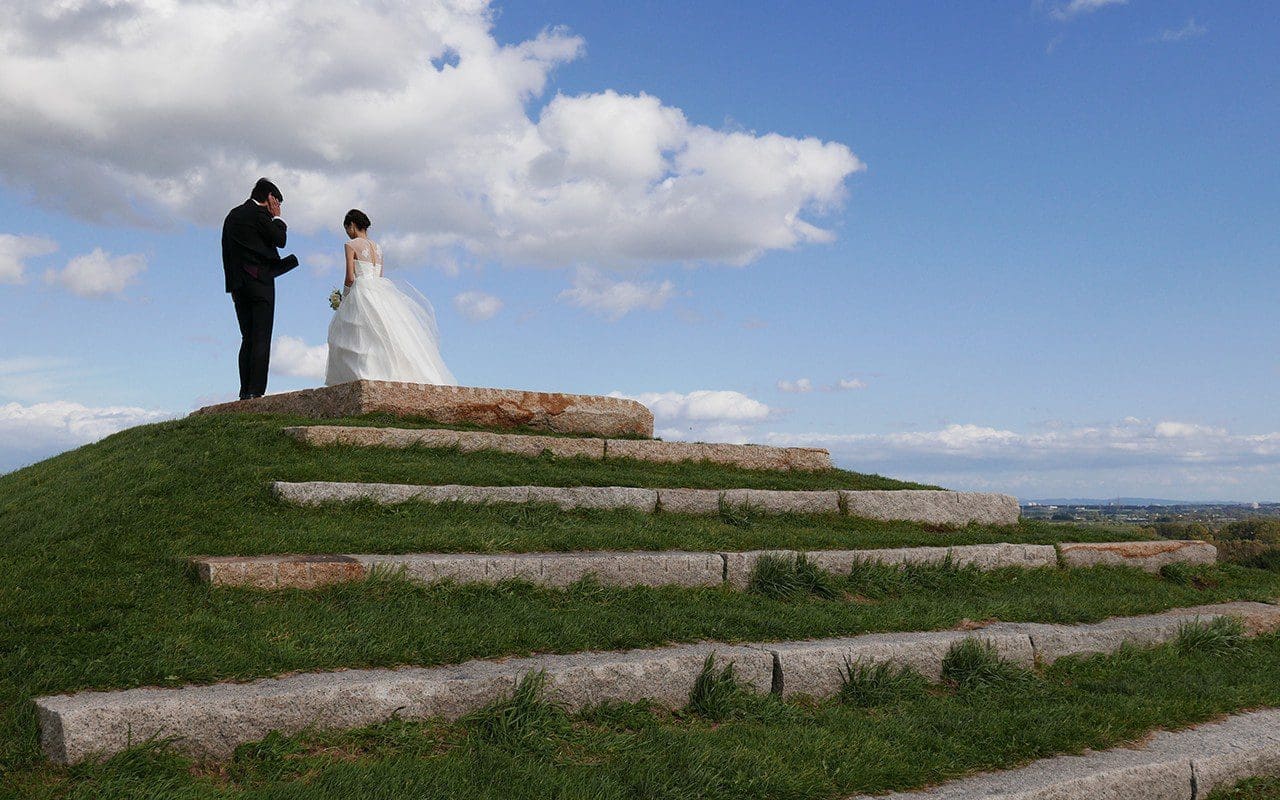 From the summit you look back to the conifer plantation which, it becomes clear, is helping the shakkei, (the borrowed view) by exactly echoing an outcrop in the mountain line in the distance. You then see the plantation is raised up on a great fold in the land with the angle of the crease retained by a wall the size of a castle rampart, also the same shape as the distant mountain. Below in the sunshine Tetra Mound glistens. Composed of a triangular steel pyramid and grassy mound designed to capture different expressions with the changing light, it too is vast when you descend and cross the endless lawn to see it.
From the summit you look back to the conifer plantation which, it becomes clear, is helping the shakkei, (the borrowed view) by exactly echoing an outcrop in the mountain line in the distance. You then see the plantation is raised up on a great fold in the land with the angle of the crease retained by a wall the size of a castle rampart, also the same shape as the distant mountain. Below in the sunshine Tetra Mound glistens. Composed of a triangular steel pyramid and grassy mound designed to capture different expressions with the changing light, it too is vast when you descend and cross the endless lawn to see it.
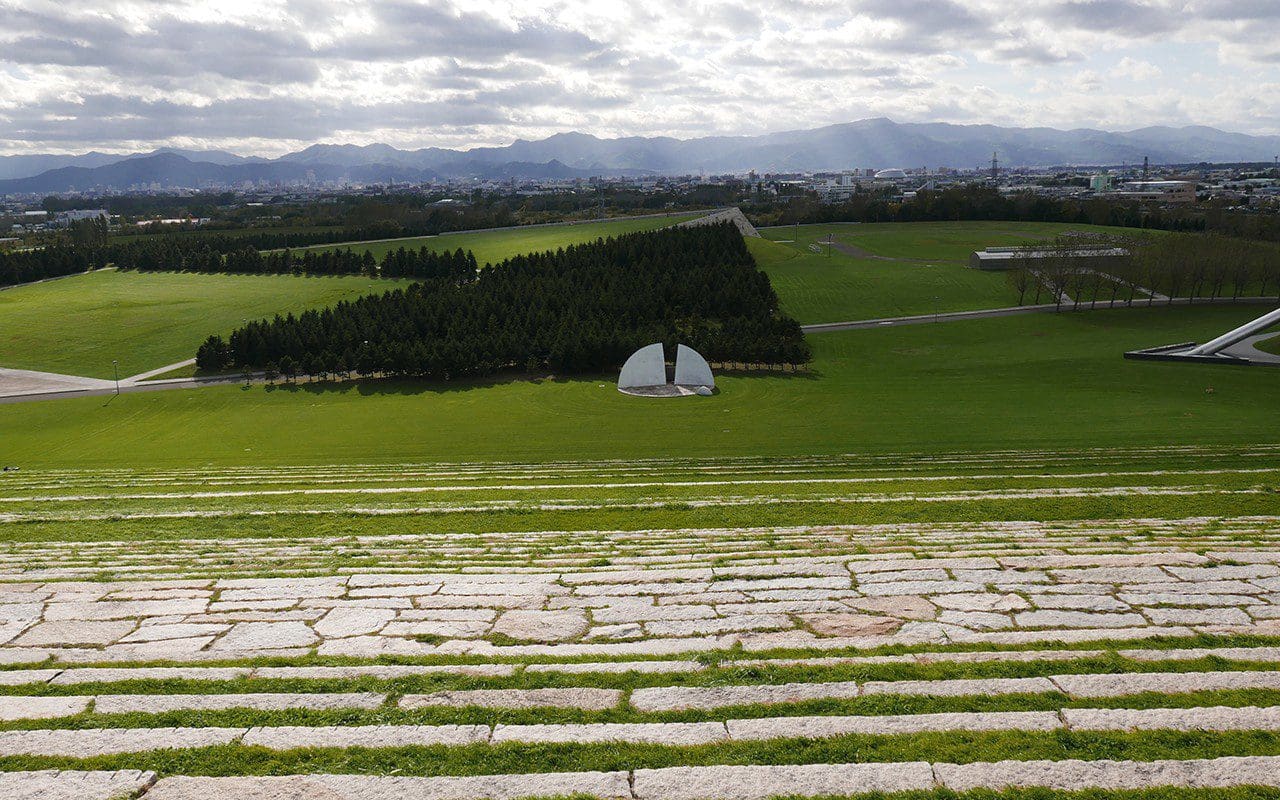

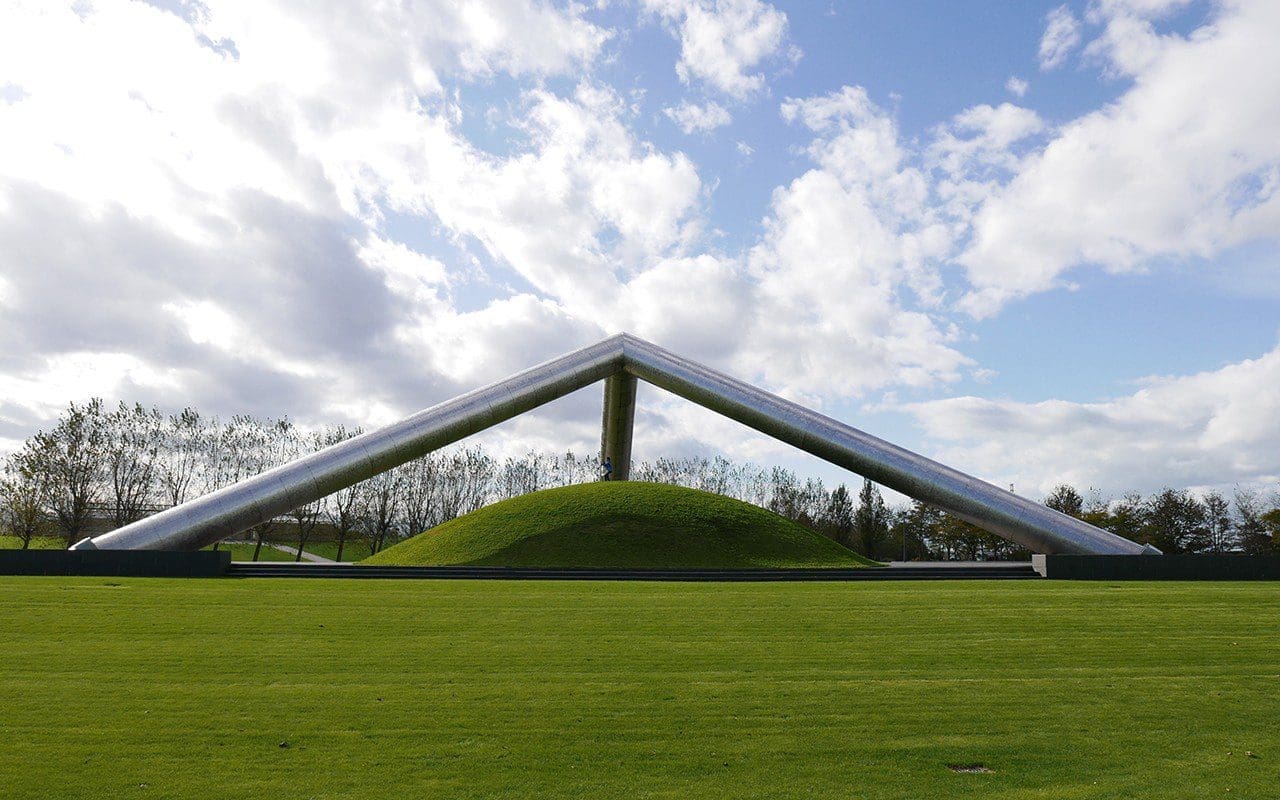
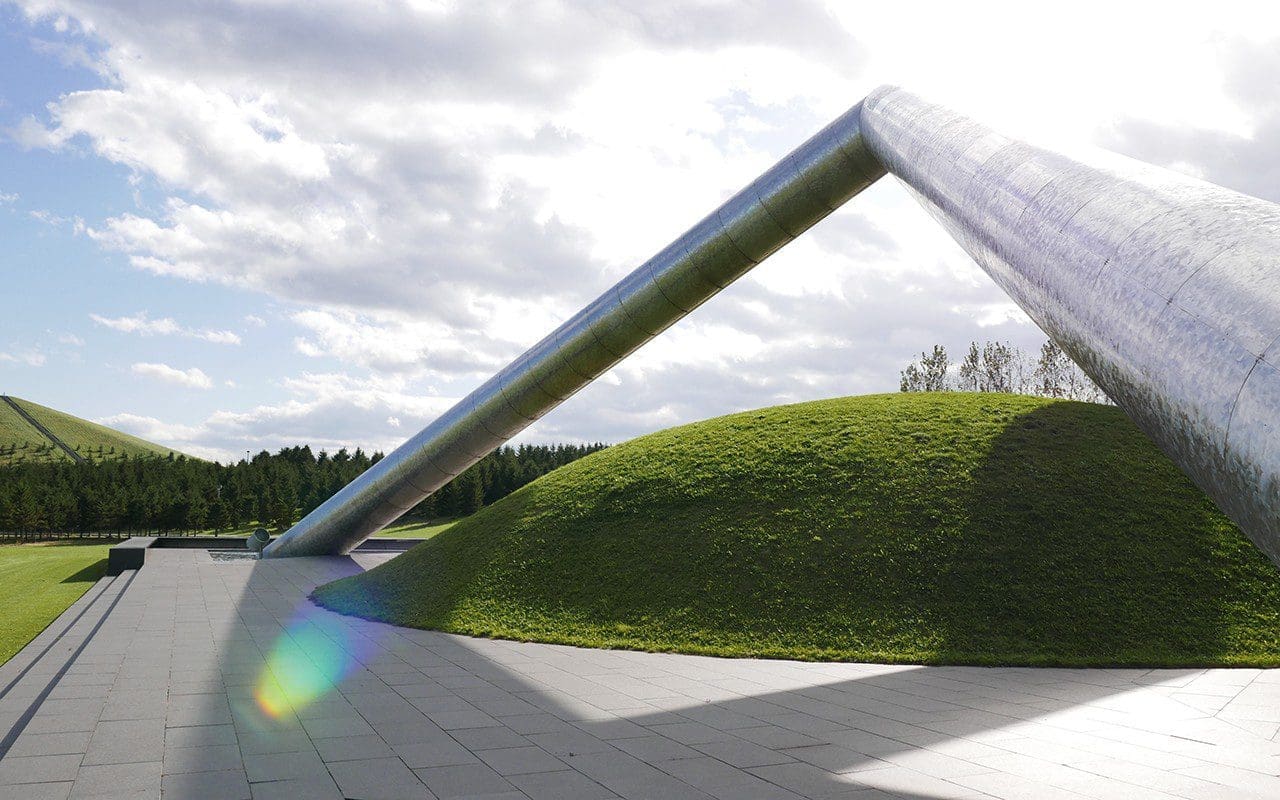
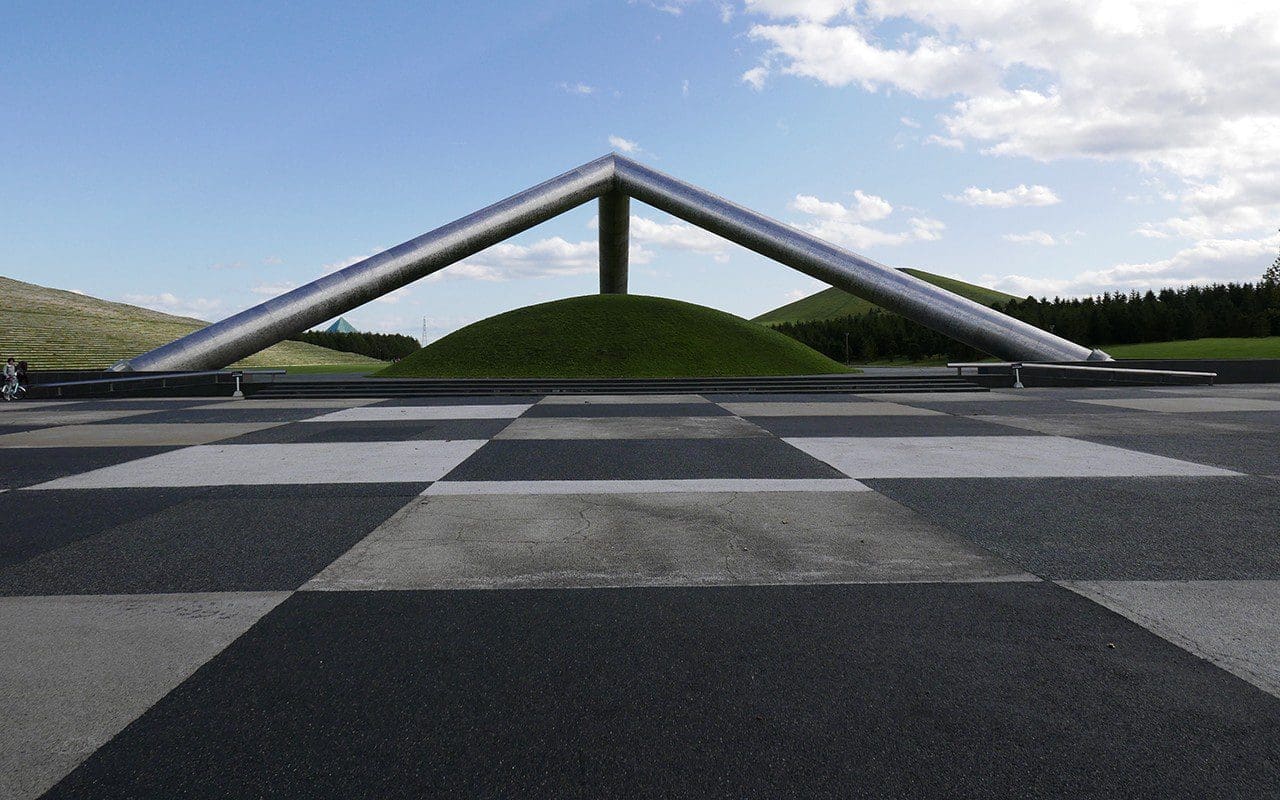
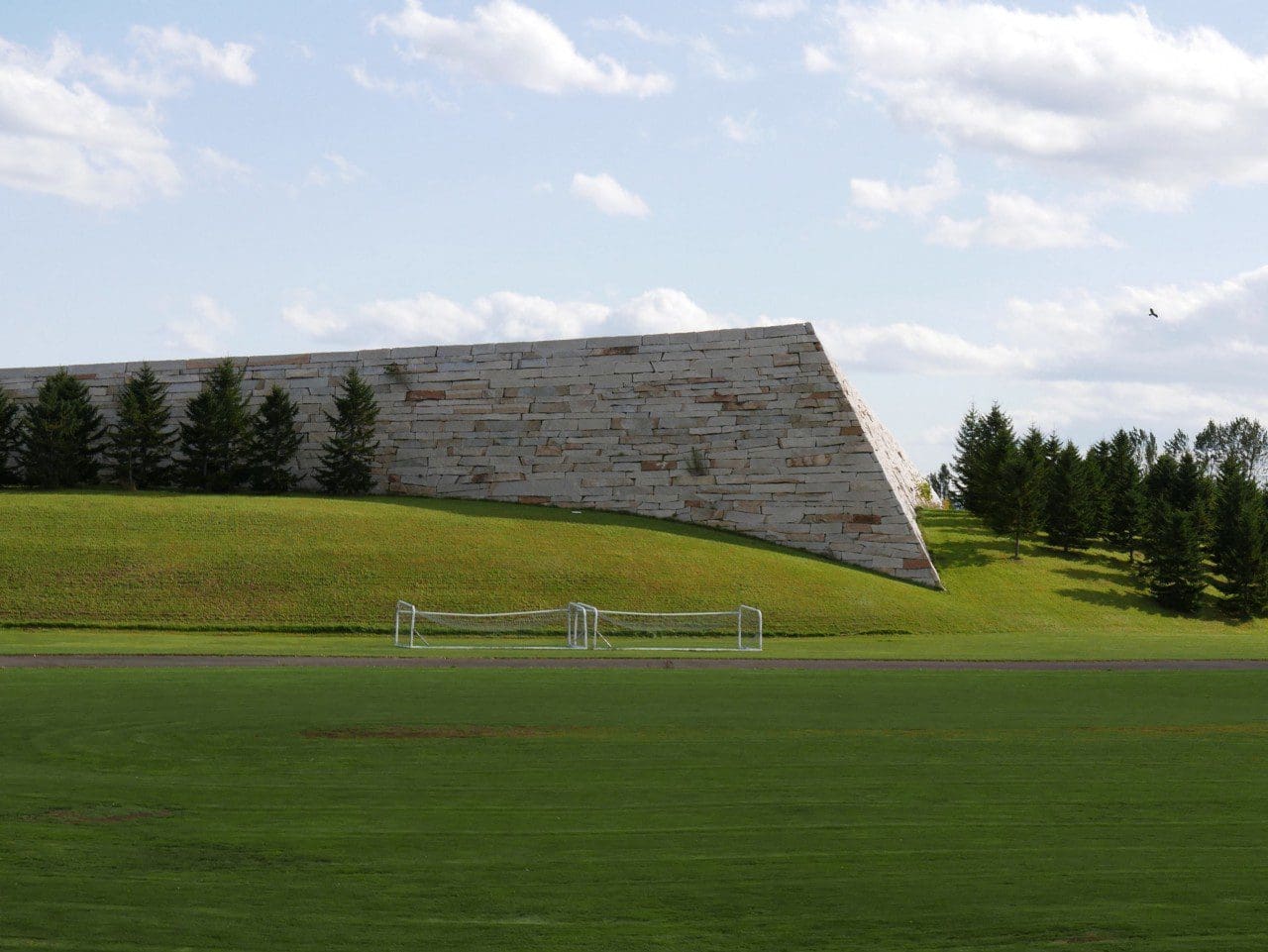 We moved on to the Glass Pyramid for tea and retreat. The pyramid, designed as Noguchi often did to contrast two materials, juxtaposes one opaque, the other transparent. It was conceived as a hidamari, a word that describes the spot where sunlight gathers. Sure enough the sun streamed in through the glass and the enclosure of the place gave respite from the relentlessness of scale outside. Our feeling of being overwhelmed was charged as much with excitement as it was with awe, but I have rarely felt so uncomfortable or challenged in a man-made landscape.
We moved on to the Glass Pyramid for tea and retreat. The pyramid, designed as Noguchi often did to contrast two materials, juxtaposes one opaque, the other transparent. It was conceived as a hidamari, a word that describes the spot where sunlight gathers. Sure enough the sun streamed in through the glass and the enclosure of the place gave respite from the relentlessness of scale outside. Our feeling of being overwhelmed was charged as much with excitement as it was with awe, but I have rarely felt so uncomfortable or challenged in a man-made landscape.

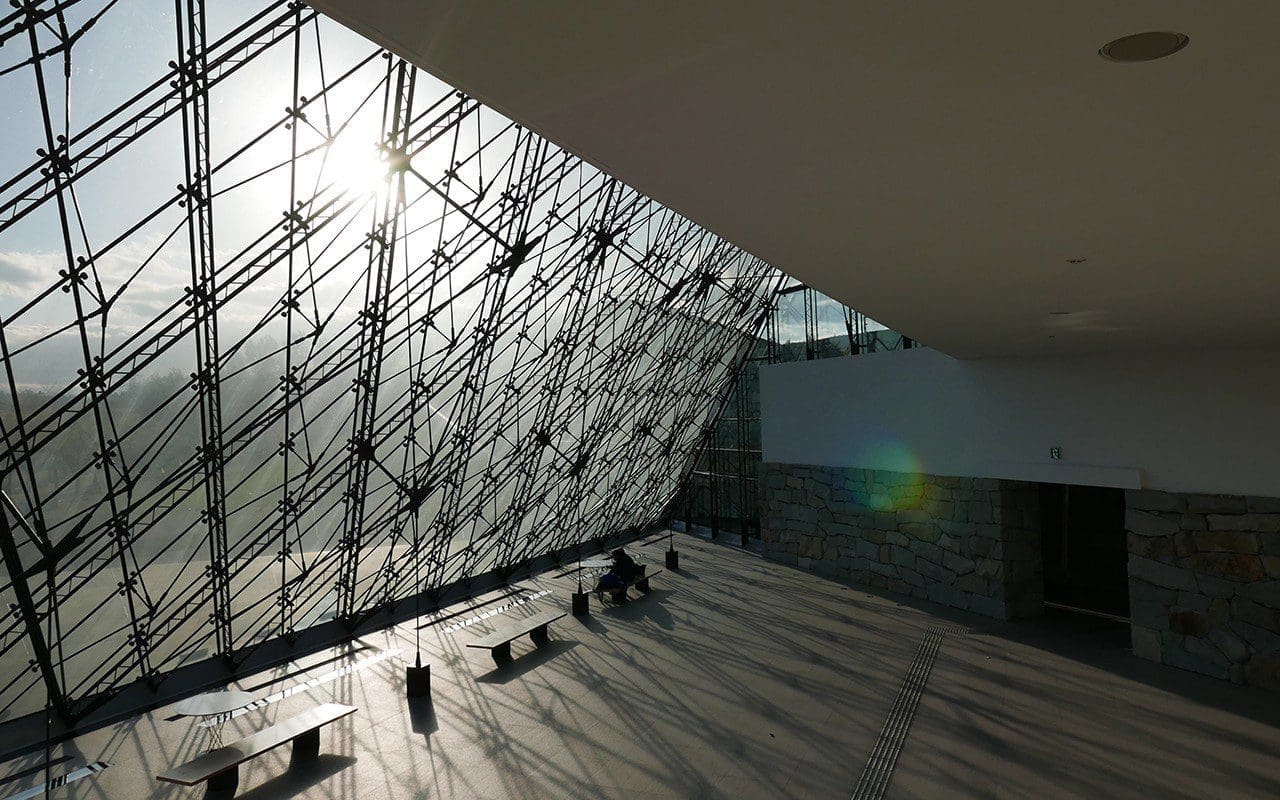 We finished the afternoon at the Sea Fountain. Held within a deep dark ring of conifers, the circular plaza centred on the last of Noguchi’s pieces to be completed at the park. He had long been fascinated by water as sculpture and birth, life and the heavens as inspiration. We arrived to find the vast cauldron boiling and churning like deep sea water when it is pushed into a ragged cliff. It was truly moving, the life we had been looking for and, then, joy as a halo of mist wrapped the crucible and then sent a geyser reaching way into the light to apparently connect with the clouds.
We finished the afternoon at the Sea Fountain. Held within a deep dark ring of conifers, the circular plaza centred on the last of Noguchi’s pieces to be completed at the park. He had long been fascinated by water as sculpture and birth, life and the heavens as inspiration. We arrived to find the vast cauldron boiling and churning like deep sea water when it is pushed into a ragged cliff. It was truly moving, the life we had been looking for and, then, joy as a halo of mist wrapped the crucible and then sent a geyser reaching way into the light to apparently connect with the clouds.
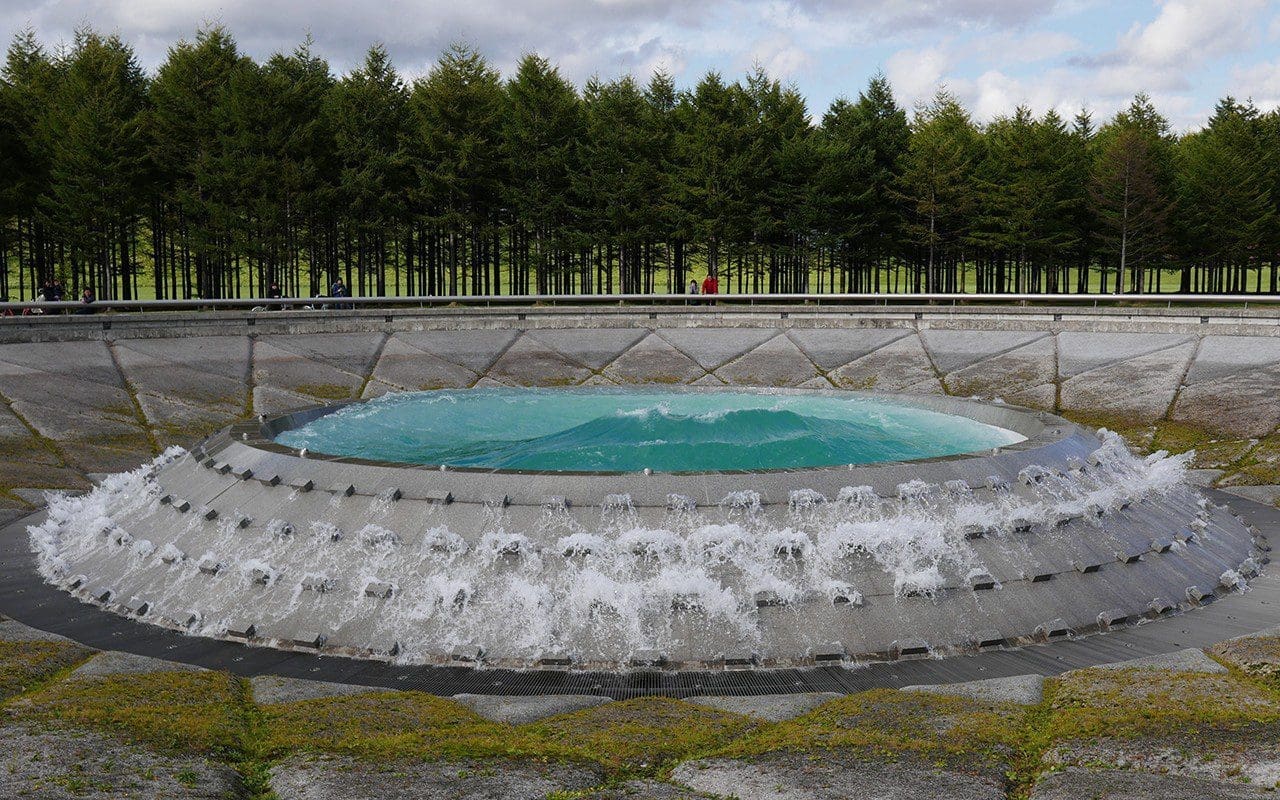
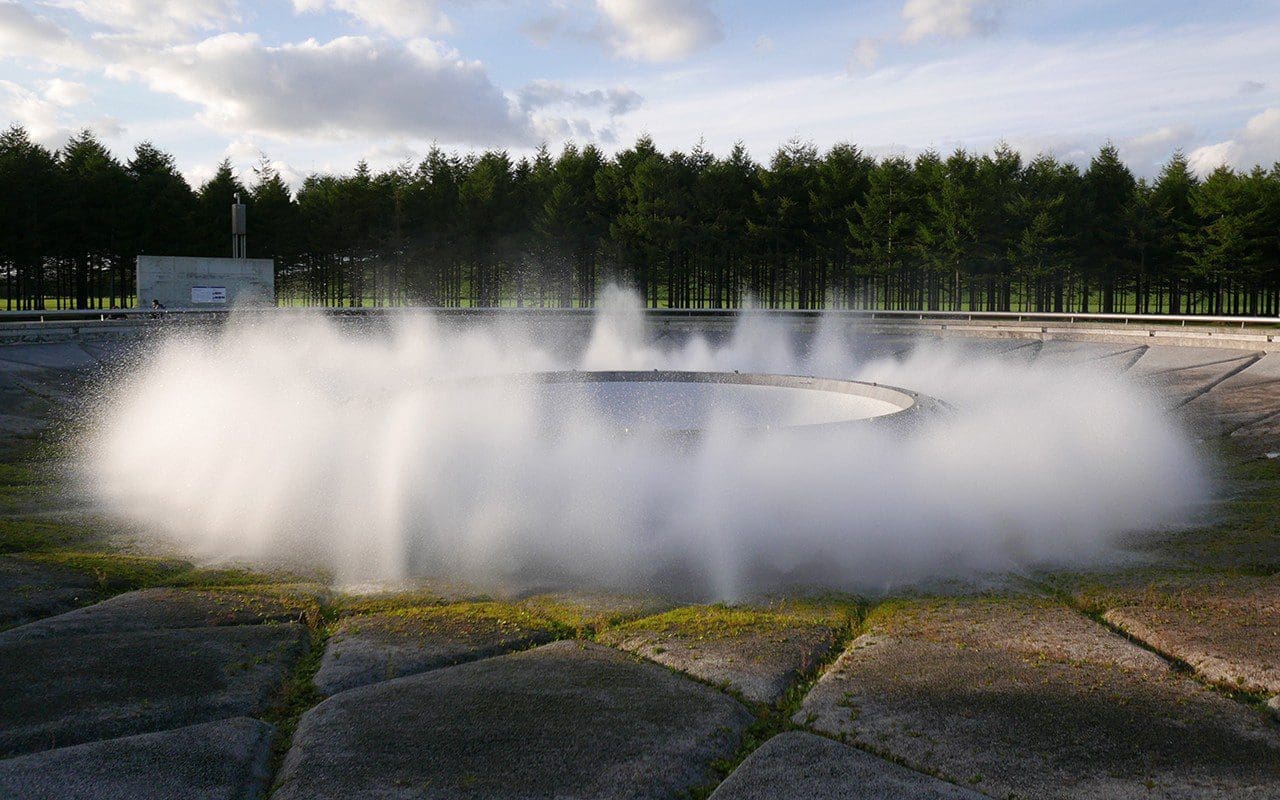
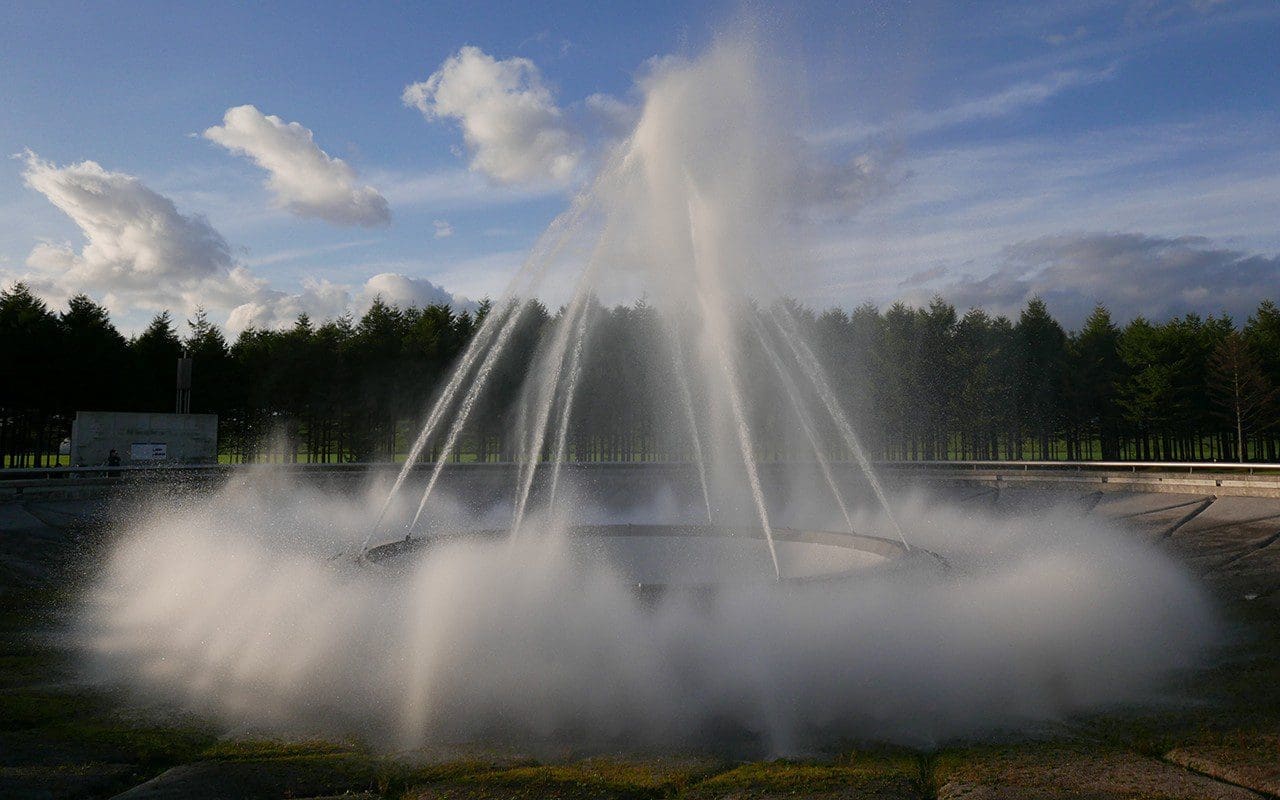
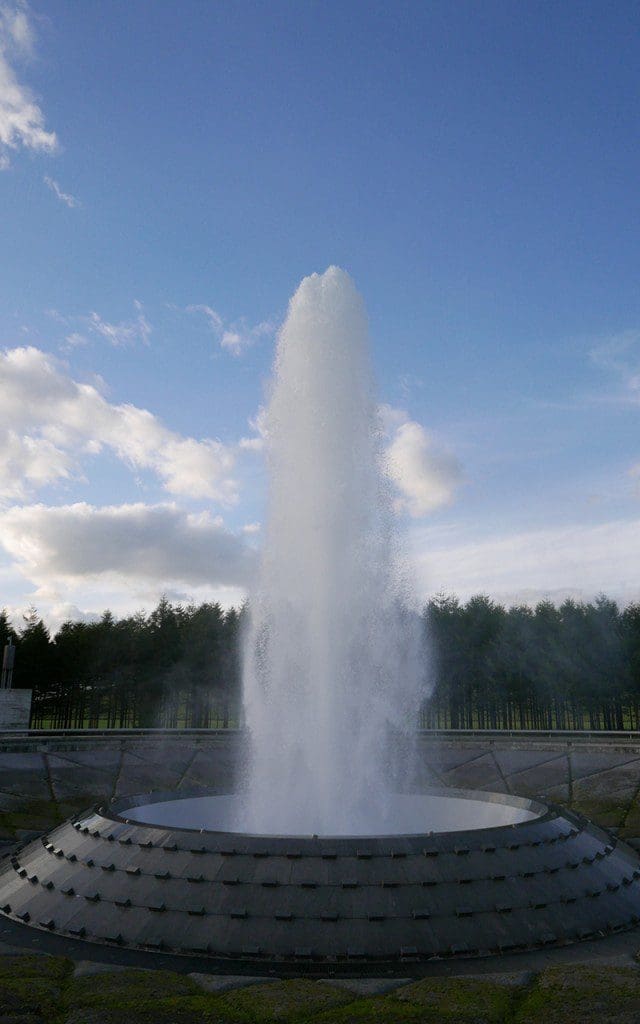 Words & photographs: Dan Pearson
Words & photographs: Dan Pearson This time last week we were down in Cornwall at the Port Eliot Festival. It was the second time I have been asked to speak there and to be one of the judges for the Flower Show. I have a particular fondness for the festival, which takes over the grounds of the estate, wraps around the house, runs alongside the banks of the River Tamar and nestles in a series of old walled gardens. The events and the tents and the happenings are carefully choreographed in a low-key fashion so that, as you roam the grounds, you discover as you go.
The landscape gardens were set out in the 18th century by Humphrey Repton, who made a grand move to push the river away from the house and in its place sweep a rolling lawn that connected a ha-ha in front of the house to the hills and woods beyond. I was lucky enough to stay in the house last autumn at Halloween with Perry and Cathy St. Germans, the Festival Director, and had the opportunity of looking over Repton’s Red Book. His books became one of his signatures as a designer and featured images of the existing landscape with a reveal that you could pull back to see the proposed vision. It is wonderful to walk in this vision today and for this festival to be so easily integrated into the historic setting.
 Mudlarking in the Tamar estuary
Mudlarking in the Tamar estuary
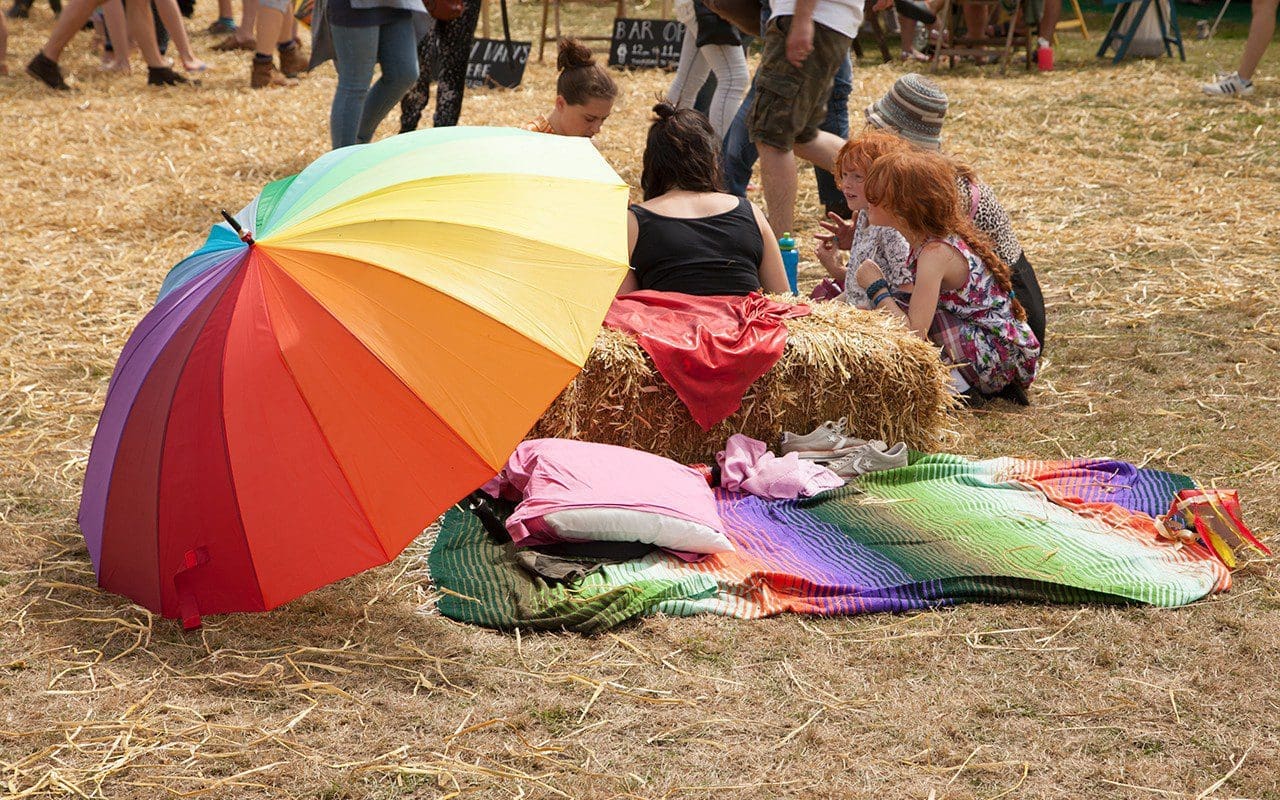 Picknicking on hay bales
Picknicking on hay bales
 Gyspy caravans and tents amongst the trees
Gyspy caravans and tents amongst the trees
The grounds are filled with delights. You will never see a hi-vis jacket and people are free to roam and picnic or swim wild in the estuary. The tents, which are scattered in clusters that each have their own atmosphere, hold talks, readings, conversations, cooking demonstrations and performances – anything from a discussion with an artist, musician or writer to a blindingly brilliant set by the Japanese band Bo Ningen. There are craft workshops in the Hole & Corner tent, where you can learn to forge a nail, dye with indigo, make a green oak stool or watch Britain’s last traditional clog maker at work. You can learn bushcraft skills or go foraging for food, plants and flowers to make your own botanical inks.
 Indigo dyeing workshop at Hole & Corner
Indigo dyeing workshop at Hole & Corner
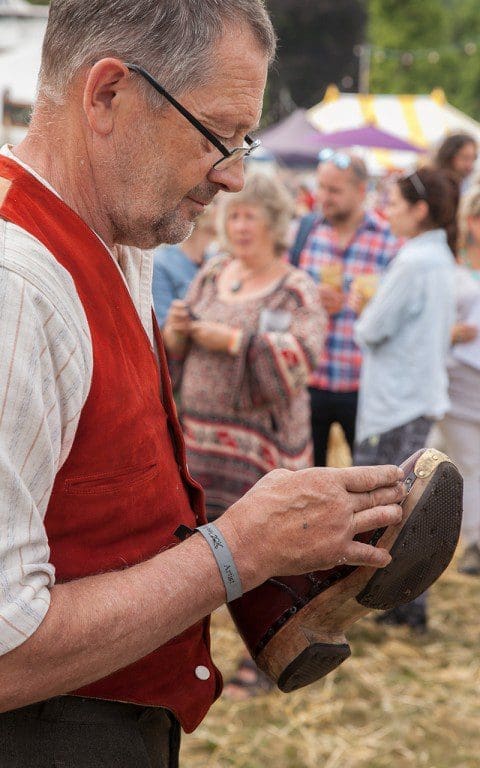 Traditional clog maker, Jeremy Atkinson
Traditional clog maker, Jeremy Atkinson
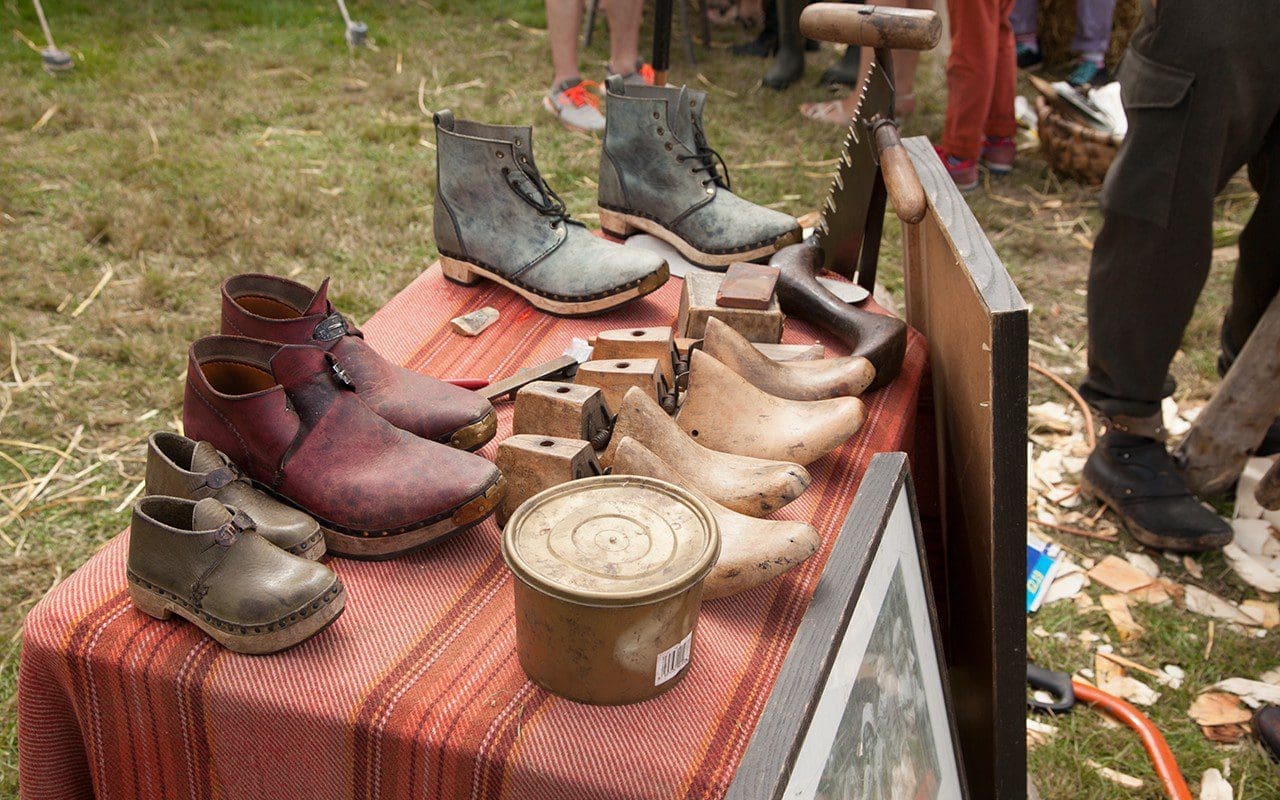
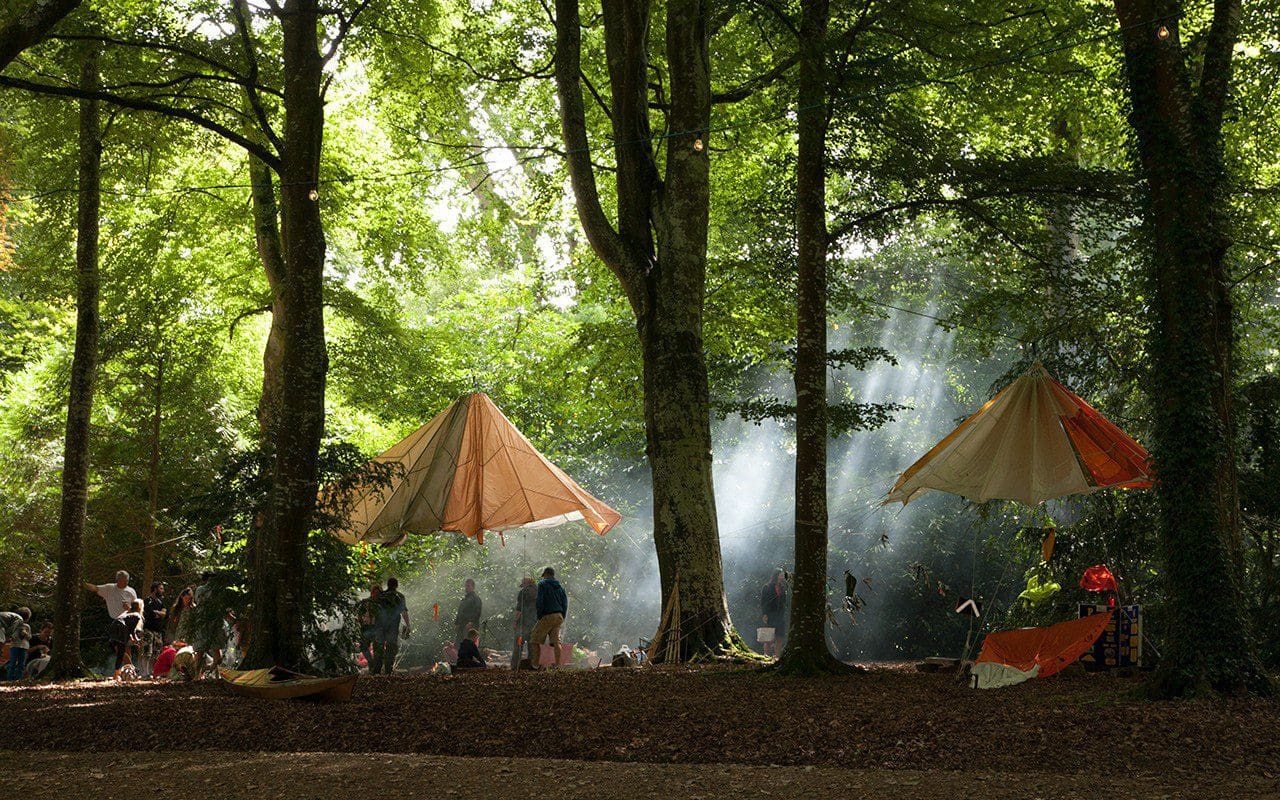 Bushcraft workshop
Bushcraft workshop
In the Wardrobe Department kids can take life drawing lessons from Barbara Hulanicki – with models including Oscar-winning Costume Designer, Sandy Powell – have a hat made by top milliner Stephen Jones, or take part in themed fashion shows – last year it was Game of Thrones, this year ’80’s Disco. The eateries are plentiful and always good and between events you can retire to the waterside gin bar and sit in a deck-chair people-watching with a backdrop of mudlarkers when the tide is out. There is a Wild West saloon with live music and real swing doors to make an entrance. You can take a hot tub on the banks of the river under the stars as we did, or boogie in the woods till dawn, or both if that is the way that the evening pans out.
Finding respite from the crowds in the house, the high ceilings and faded grandeur provide an elegant setting for magical installations and exhibitions of historic interest. In the Dining Room this year two articulated dolls made by Leonidas set an appropriately spooky tone, which put us in mind of The Turn of the Screw.
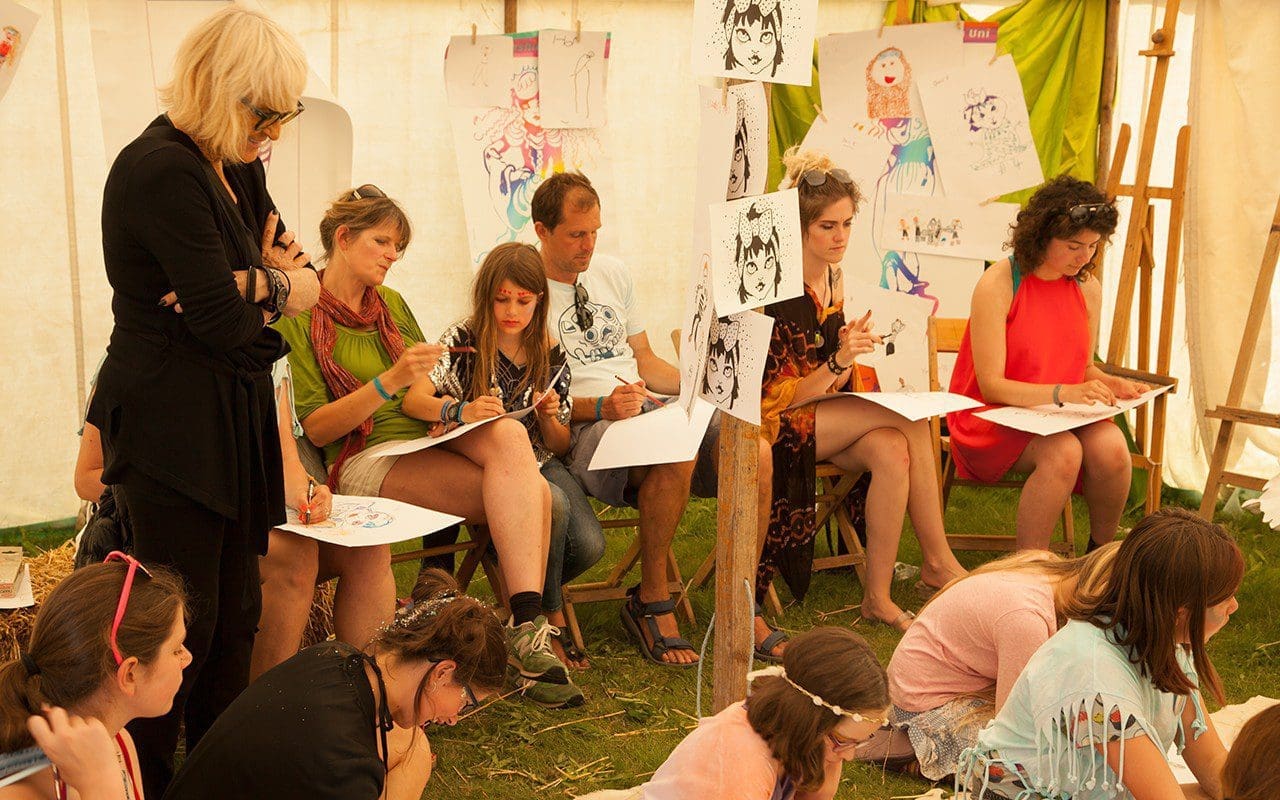 Life drawing with Barbara Hulanicki
Life drawing with Barbara Hulanicki
 Costume Designer, Sandy Powell (right), posing for the life drawing class
Costume Designer, Sandy Powell (right), posing for the life drawing class
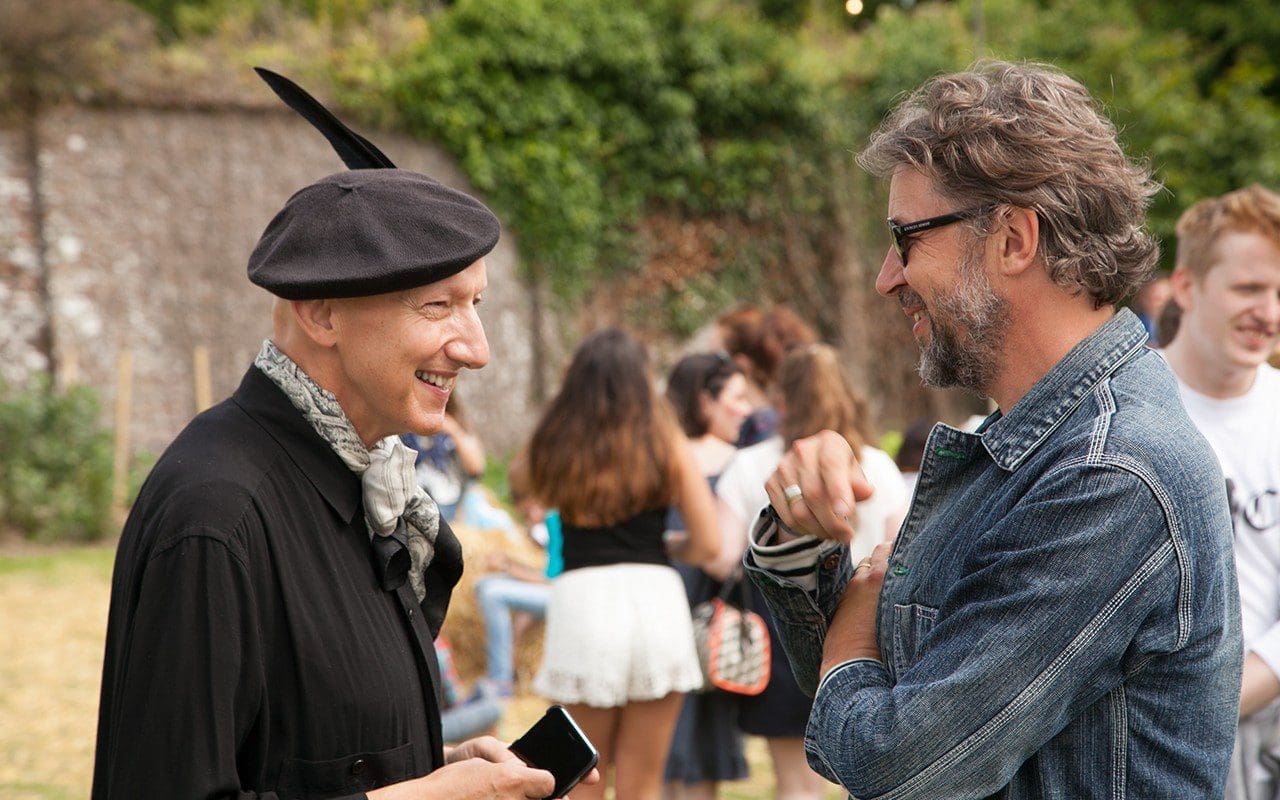 Dan chatting to milliner, Stephen Jones
Dan chatting to milliner, Stephen Jones
 Dolls by Leonidas of La Poupée Mécanique
Dolls by Leonidas of La Poupée Mécanique
The garden, which rolls over the undulating terrain in a series of copses and clearings boasts some magnificent trees and, wherever you go, there are surprises; a huge Magnolia delavayi, a camellia walk, a maze that took Perry years to plan. The Walled Garden, which is gardened lightly today, has runs of colourful Higgledy Garden annual seed mixes jostling against high, lichened walls. A huge Crinum powelli ‘Album’ makes an appearance next to the Orangery and hydrangeas burst from behind box hedges, as if from another age. As you swing down to the estuary, dramatically spanned by Brunel’s viaduct, you are greeted by a lawn punctuated with clumps of giant Pampas grass. This is the way to see them, marching confidently across the landscape.
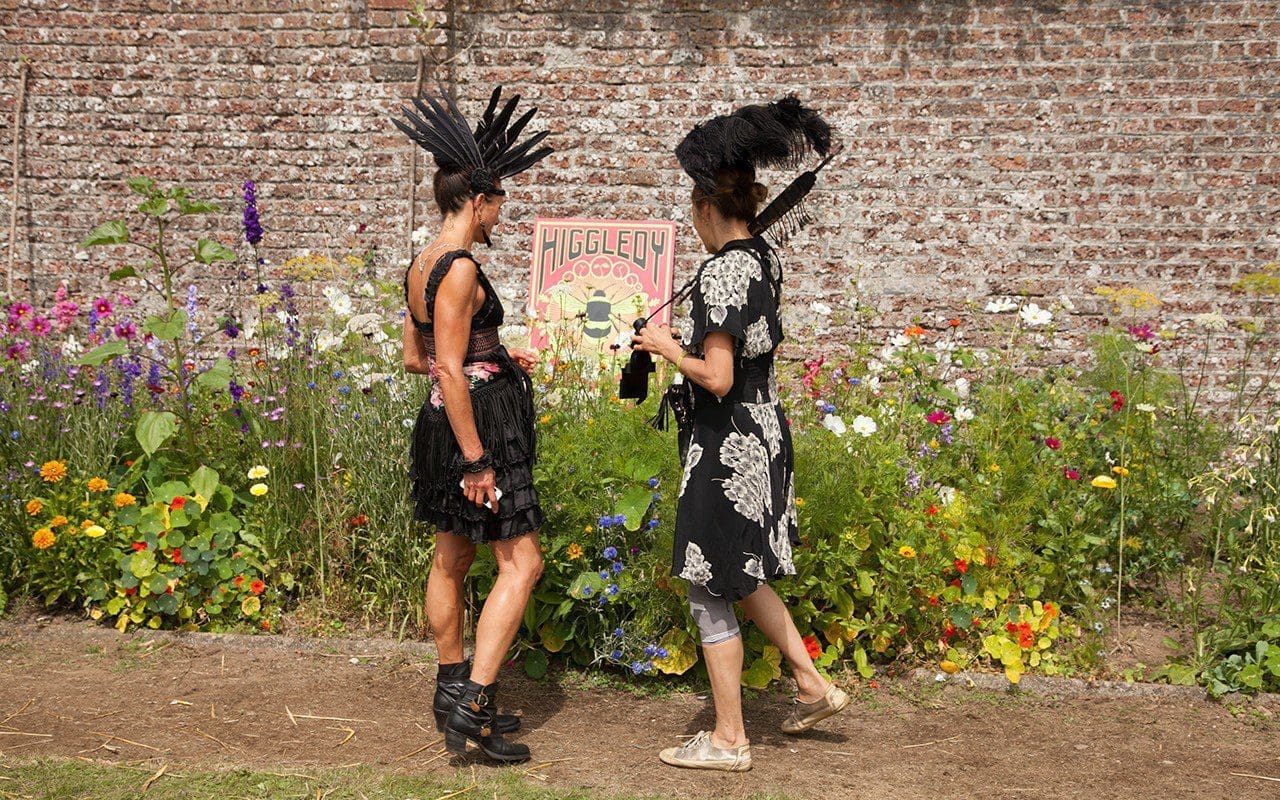
 Higgledy Garden borders in the Walled Garden
Higgledy Garden borders in the Walled Garden
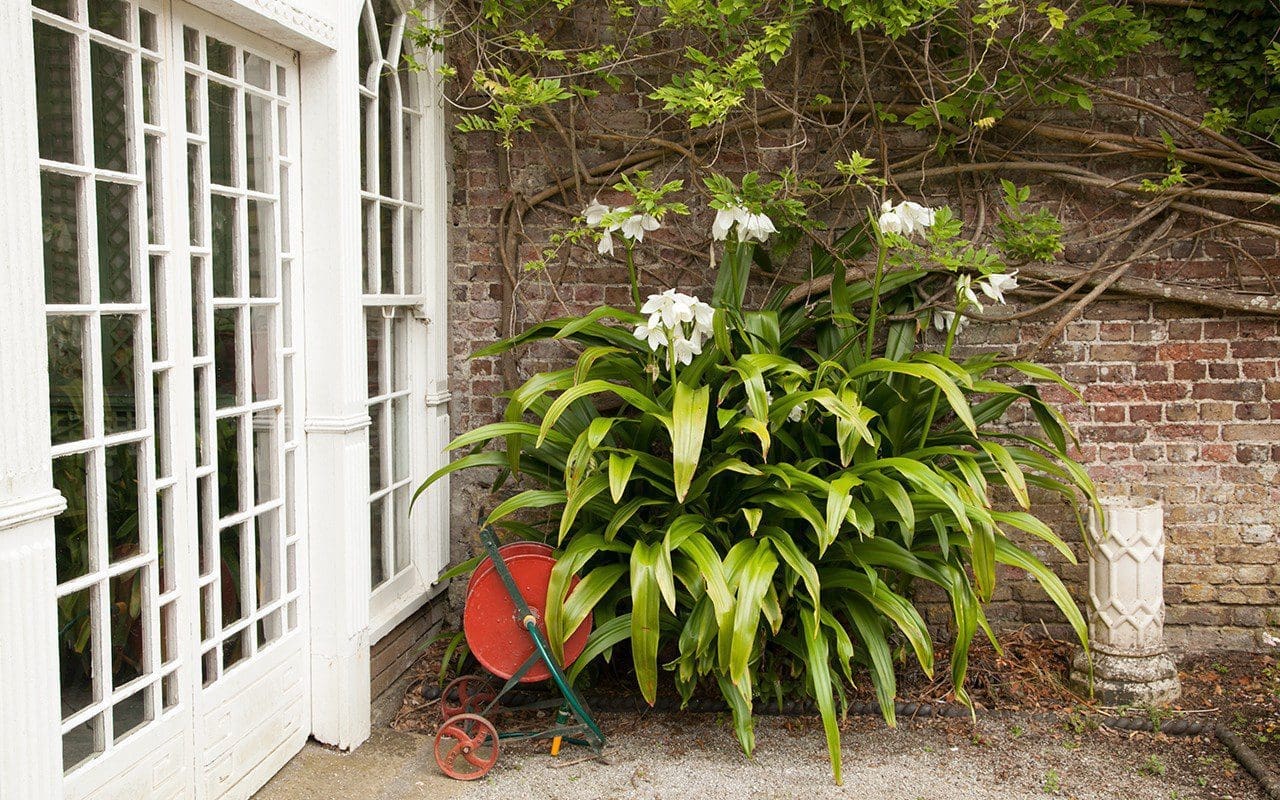 Crinum powelli ‘Album’ by The Orangery
Crinum powelli ‘Album’ by The Orangery
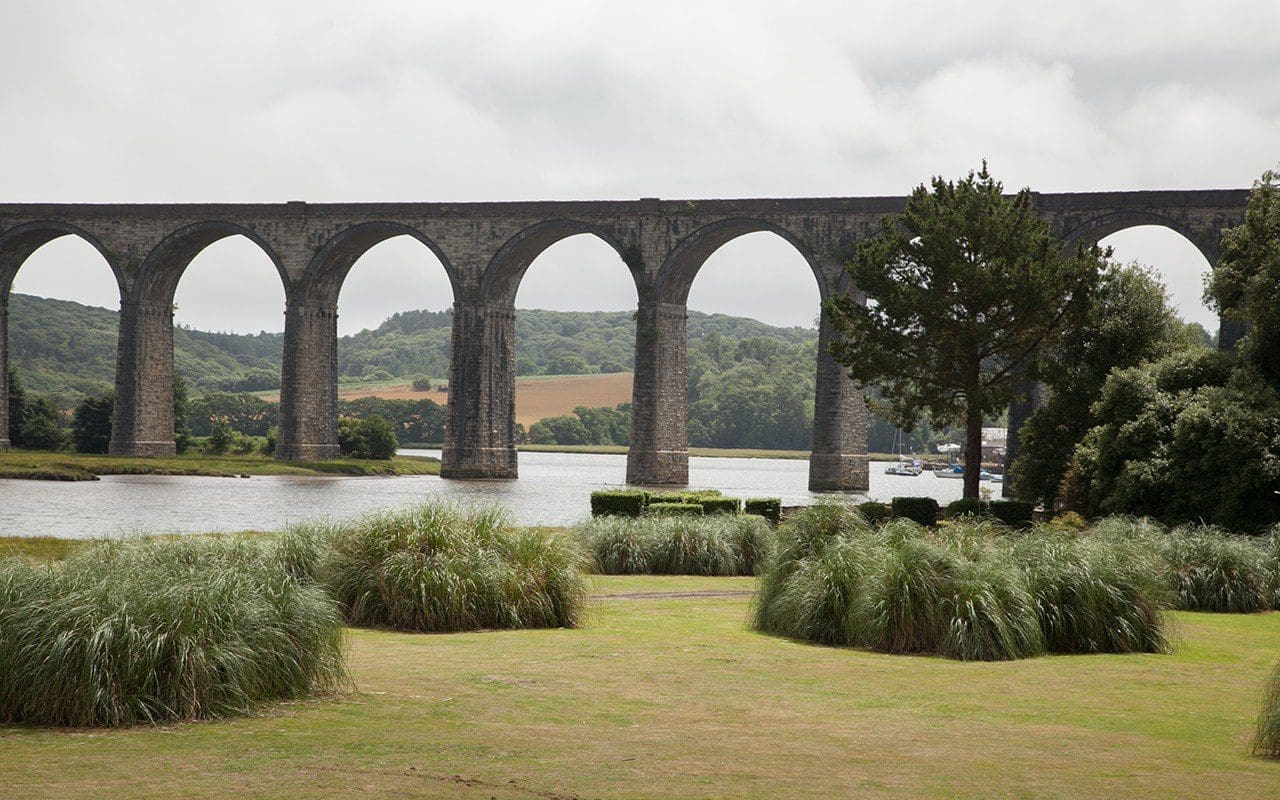 Brunel’s viaduct and Pampas grass
Brunel’s viaduct and Pampas grass
The serious matter of judging the Flower Show started on Friday afternoon as we took a sneak preview of the entries as they started to arrive into the below-stairs corridors beneath the house. Cool flag floors and no windows provided a perfect environment for the flowers, which were arranged on trestle tables according to the entry classes. A workbench at the end of the corridor was set up for last minute arranging and adjustments, and the judging started at 9:30 prompt the following morning.
Michael Howells, the festival’s Creative Director, adjudicated. The judges, Sarah Husband, Tony Howard, Huw and myself followed behind to make our selections. A pair of redoubtable local WI members ensured that the judging was rigorous and fair, recorded the names and entry numbers of the entrants and placed rosettes and cups. The themes of the Flower Show at the festival are always inspiring and spawn great leaps of imagination amongst the entrants. True to the best of English flower shows there are sections for both adults and children.
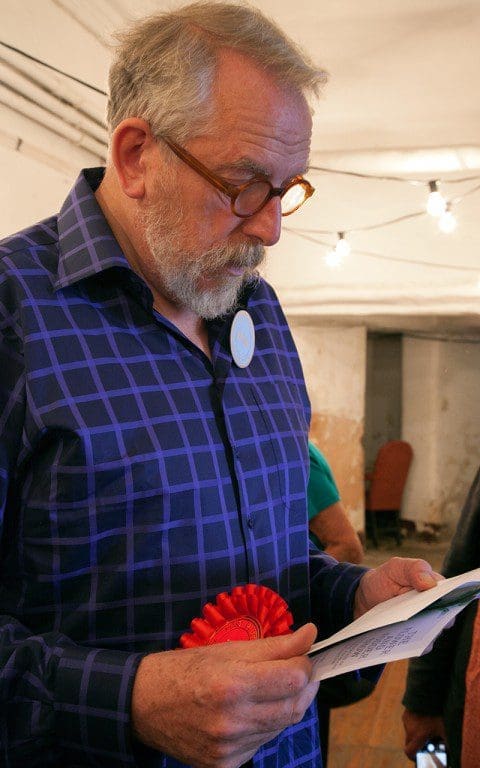 Creative Director, Michael Howells
Creative Director, Michael Howells
 Members of the local Women’s Institute record the judging
Members of the local Women’s Institute record the judging
The adult classes this year included a range of subjects marking a number of significant anniversaries. The 300th anniversary of the birth of Capability Brown was celebrated in a miniature landscape garden. I love a miniature garden and attribute my career to a rosette-winner I made when I was ten for the Liss Flower Show.
The class ‘Fire Fire !!’ marked the 350th anniversary of the Great Fire of London and entries used the best of high summer colour to paint this picture.
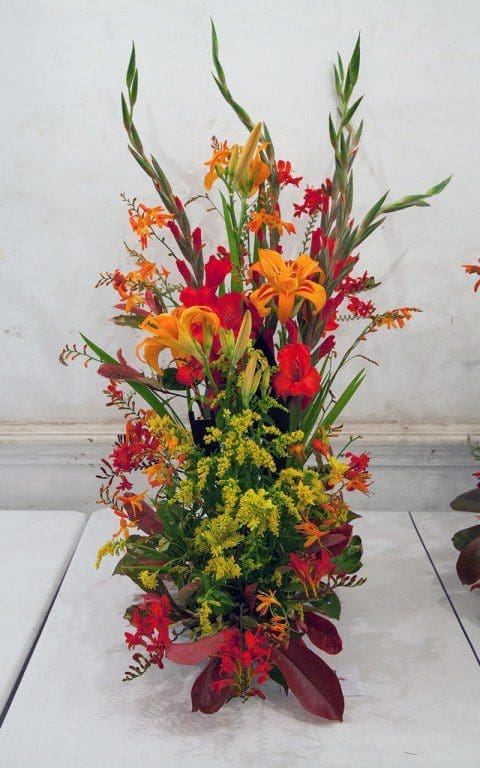
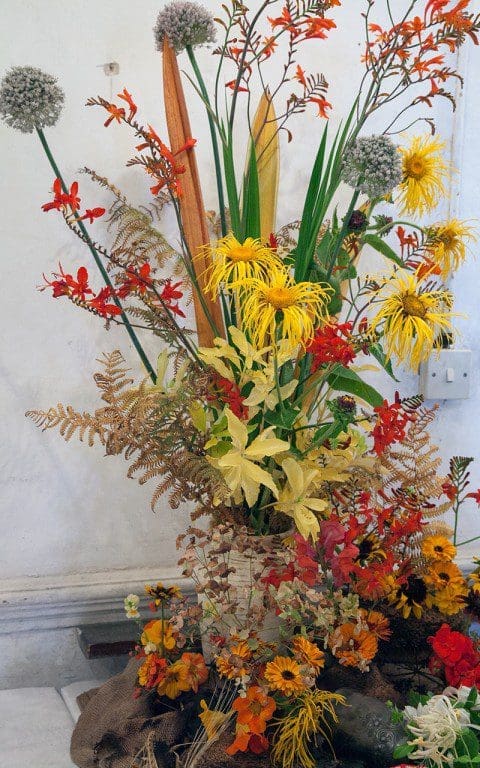 Entries in the ‘Fire Fire !!’ class
Entries in the ‘Fire Fire !!’ class
‘All the World’s a Stage’ celebrated the 400th anniversary of the death of William Shakespeare, whilst ‘A Sight for Sore Eyes’ (commemorating the 950th anniversary of the Battle of Hastings) generated the Best in Show award with a gory battlefield, set against a bloodied English flag. King Harold, made from torn paper, arms and legs akimbo, lay with an arrow in his eye and drops of glistening blood.
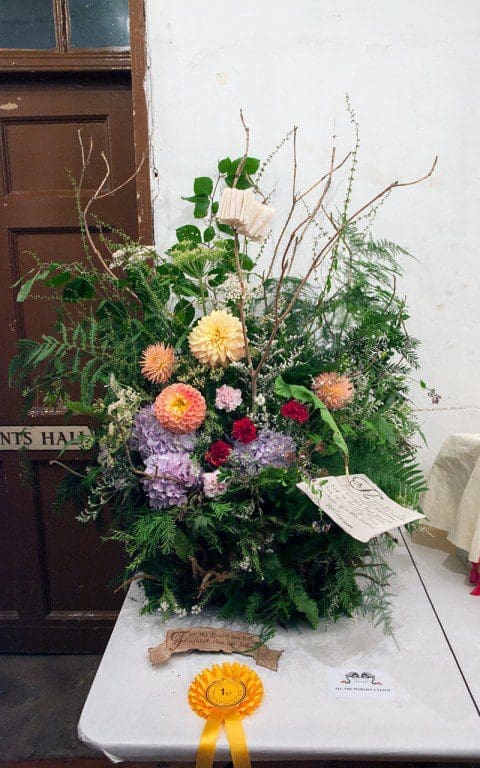
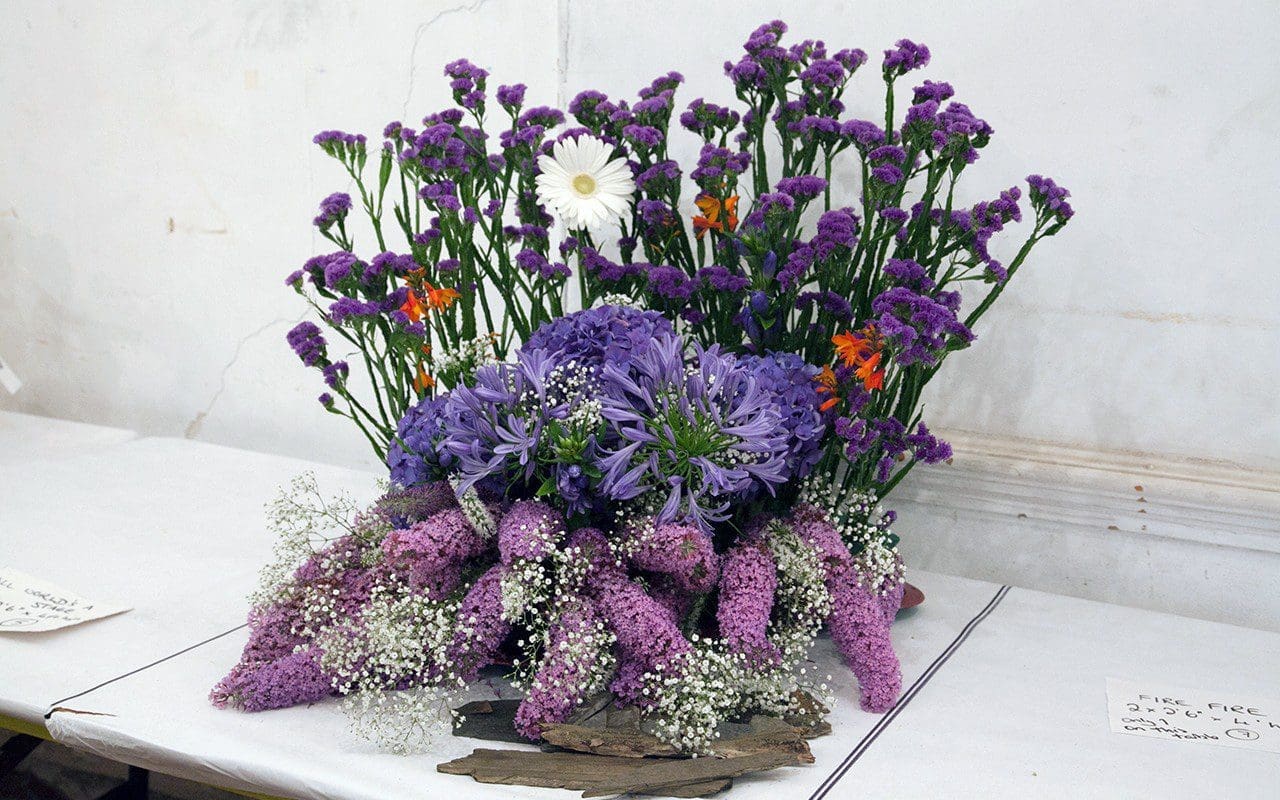 Entries in the ‘All the World’s a Stage’ class
Entries in the ‘All the World’s a Stage’ class

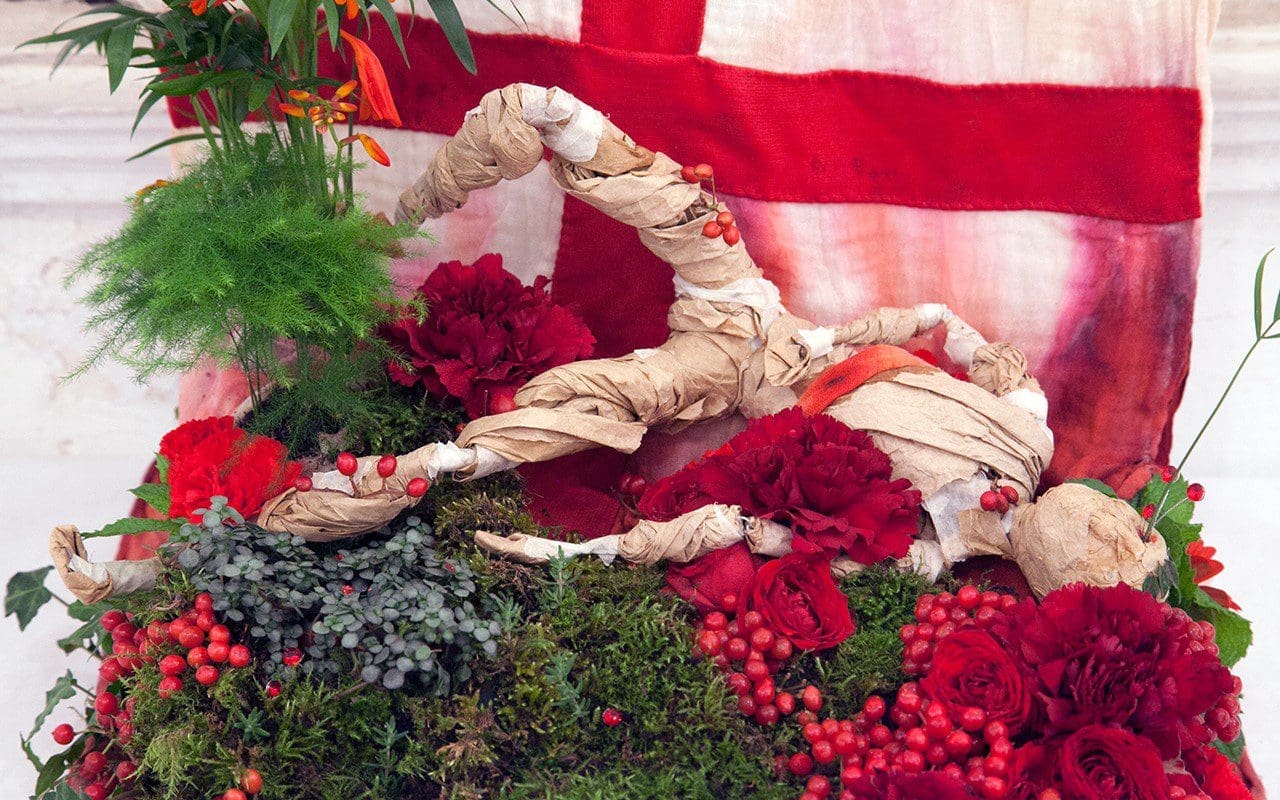 Winner of Best in Show and First Prize in the ‘A Sight for Sore Eyes’ class
Winner of Best in Show and First Prize in the ‘A Sight for Sore Eyes’ class
‘Down the Garden Path’, celebrating the 150th anniversary of the birth of Beatrix Potter was, not surprisingly, a delight and one exhibit stood out immediately for its attention to detail with miniature tools and even a tiny cross bearing Peter Rabbit’s blue coat. It was a world within a world and a unanimous First Prize winner.
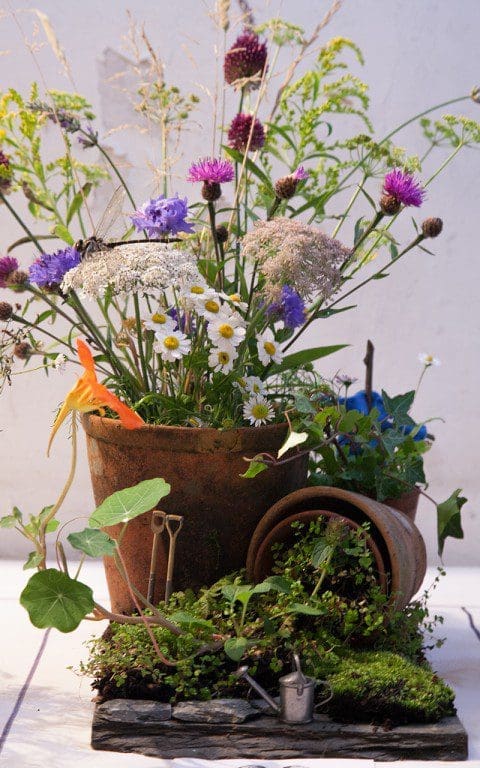
 Winner of the ‘Down the Garden Path’ class
Winner of the ‘Down the Garden Path’ class
The children’s section (“‘My Hero’ – a sculpture of your favourite Roald Dahl character made of fruits and vegetables”) is always fun and shows great inventiveness, and we struggled from wondering if one or two had had adult assistance, they were that clever. I loved the anthropomorphic transformation of fruit and veg into characters. They were pure unbridled fun.



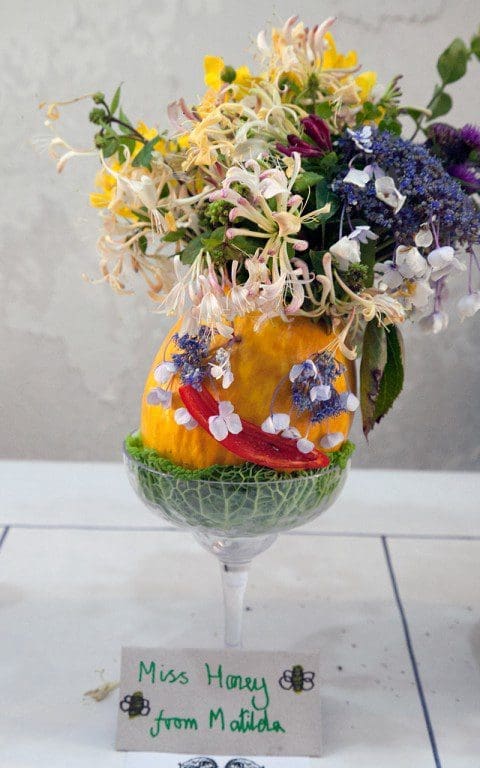

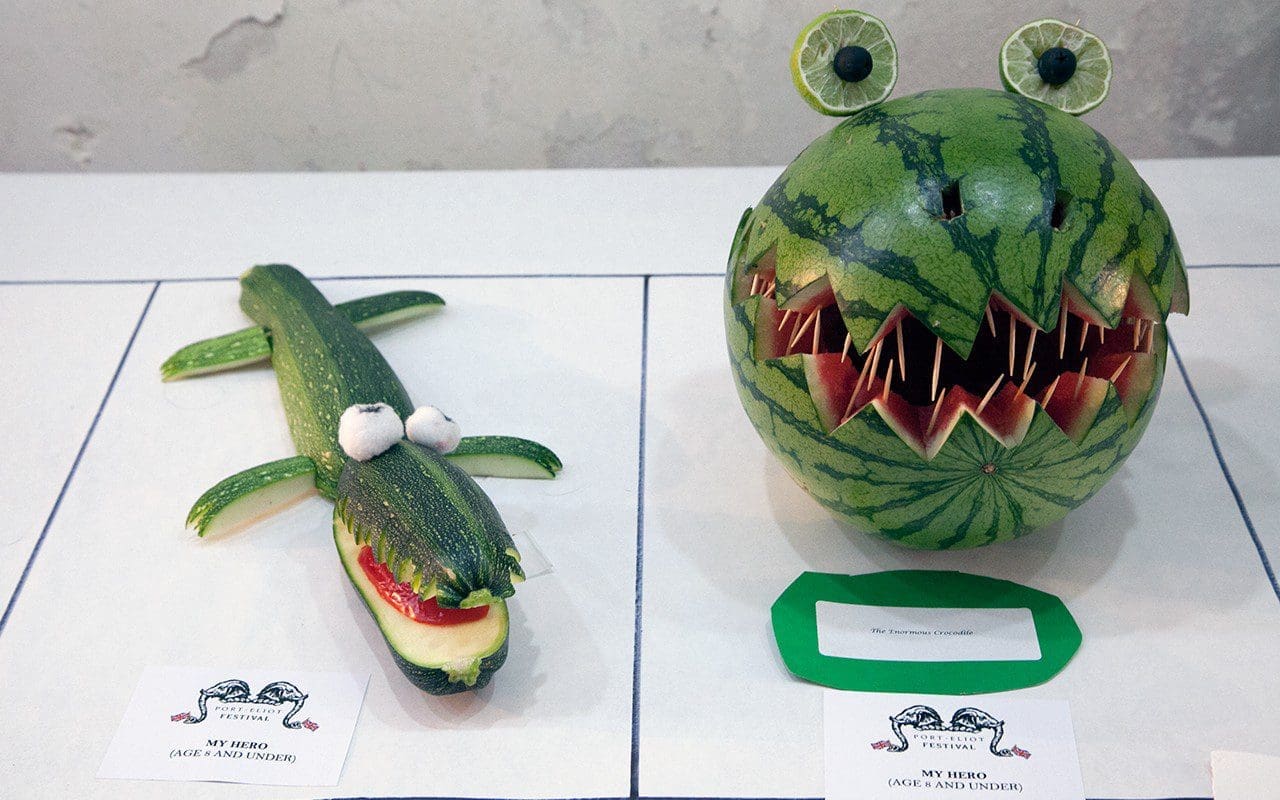
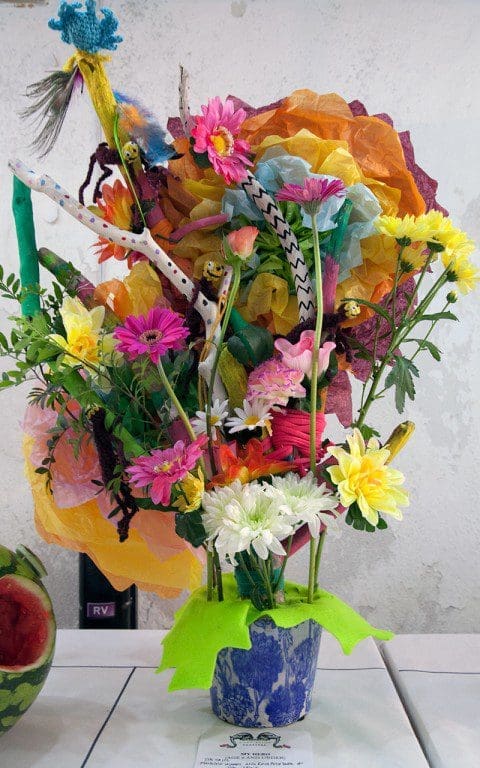 Entries in the ‘My Hero’ class
Entries in the ‘My Hero’ class
We finished by moving out into the light again to the banks by the house to judge the scarecrow competition. Ancient Magnolia grandiflora pressed themselves tight to the walls of the house and great billowing clouds furnished the sky above us. This year’s theme was Angels and Devils. My favourite scarecrow was of Boris Johnson, complete with mop of straw hair and a Brexit badge. It felt like he had found an appropriate and fitting home for himself.

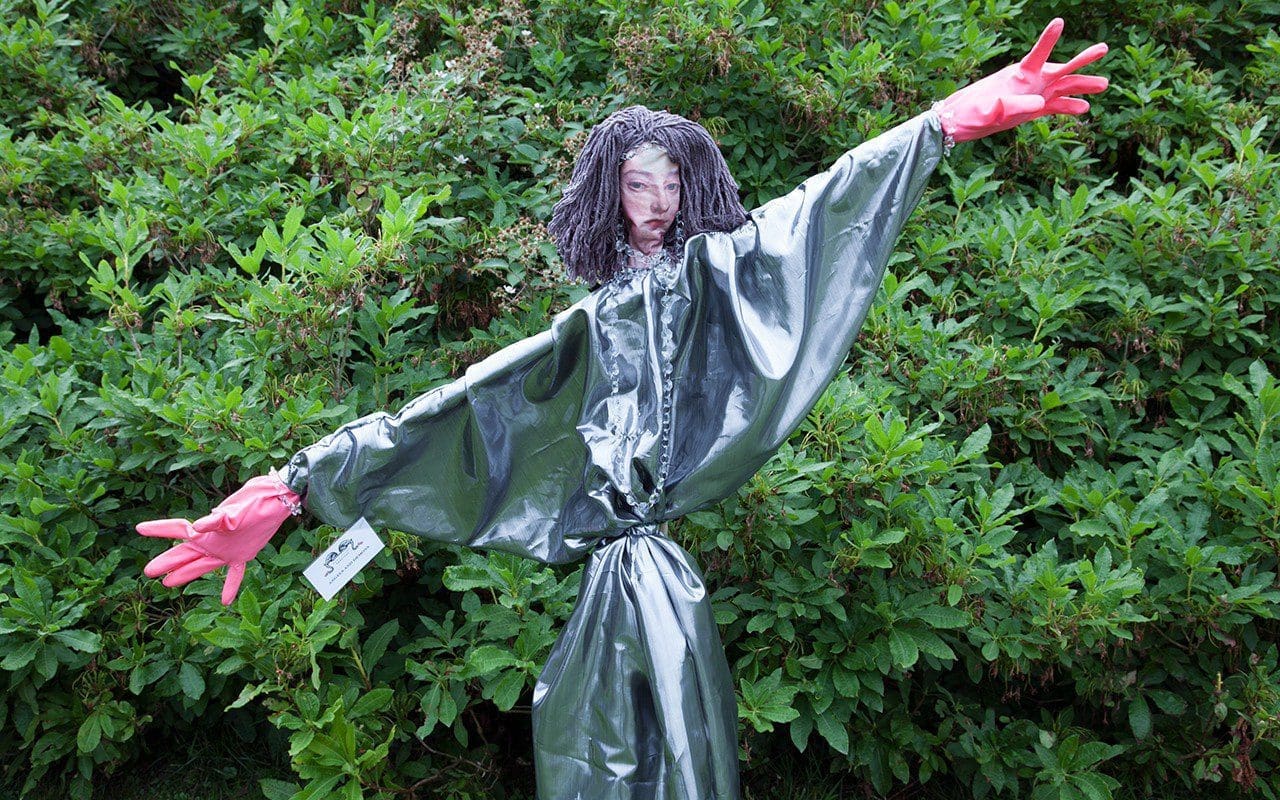
 Entries in the Scarecrow class
Entries in the Scarecrow class
This year’s was a particularly meaningful festival, because Perry (Peregrine Eliot, 10th Earl of St. Germans) was buried little more than a day before it opened. It was extraordinary timing on his part and, given that he and Cathy have always been the most generous of hosts, exceptionally fitting and true to his spirit that the party simply continued.
 Festival Director, Cathy St. Germans
Festival Director, Cathy St. Germans
Words: Dan Pearson / Photographs: Huw Morgan
It is 13 years since Michael and Angela Cronk approached me to come and look at the Georgian rectory they had recently bought in the Windrush Valley in the Cotswolds. Initially they only wanted me to advise them on replacing the plantings but, after some discussion, I suggested it should be a more involved exercise, which would mean taking apart the garden that was there before and starting again.
The existing garden had been laid out by Nicholas Ridley, the Conservative Party politician, and although a completely new garden was rather more than Michael and Angela had anticipated, they were confident that a clean sweep was the best approach. Ridley had harnessed water from the river, which was fed across the site through a series of pipes (some of which even passed along the top of a miniature aqueduct) and used in a series of water features. The original bog garden was completely silted up and had been colonised by thickety willows, and some of the pipes that carried water to the canal were broken and had filled the cellar a foot deep.

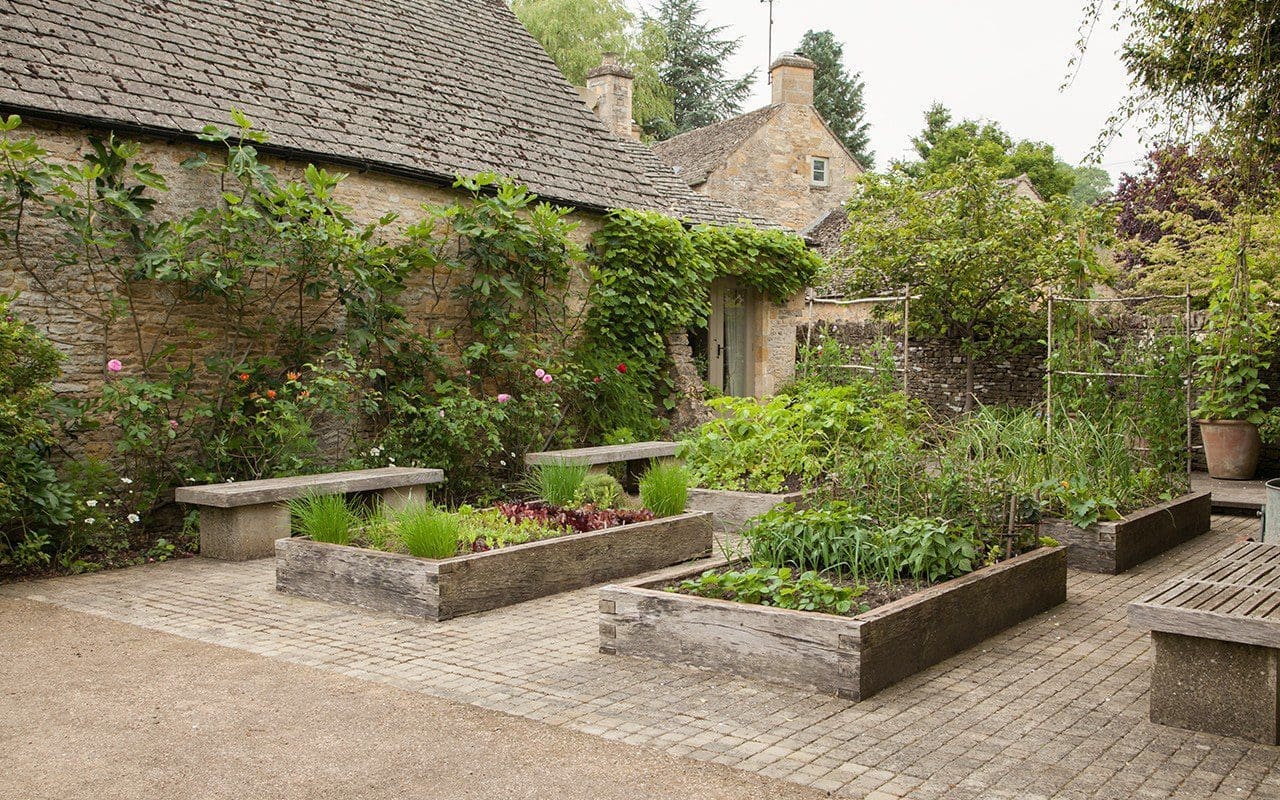
Steve Swatton, the landscape contractor who helped Cleve West win Best in Show for his garden at this year’s Chelsea Flower Show, and who was also responsible for creating all of Christopher Bradley-Hole’s Chelsea show gardens, was our impeccable contractor. With him we created a series of garden rooms that surround the house, which sits in the middle of a near perfect acre.
The original stone boundary wall was the inspiration for a series of new dry stone walls, which define each of the garden spaces. It was essential that these walls were beautifully built and, to that end, Steve employed some of the stonemasons who had worked with Andy Goldsworthy on his dry stone pieces. When they had finished the head stonemason told us that they had carved the initials of everyone involved in the garden’s making into stones in different parts of the garden and we spent several hours trying to track them all down. Arrow slots in the walls lined with green oak offer glimpses of the gardens beyond. These teasing views draw you through the space and make visual connections between the enclosures. Each garden’s planting is colour-themed to heighten the distinct mood of each.
Reached via a rose scented passage between two barns and the immaculate vegetable garden, the first garden area has a new pond at its heart made on the site of the original bog garden. It is open to the River Windrush on one side and was designed to elevate the contrast between fast running and still water by containing it within a clean stone elipse. There are shallow steps down to the river’s edge so that, on a hot day, you can dangle your feet in icy water. The pond is boldly planted with native and ornamental marginals including Osmunda regalis, Iris x robusta ‘Gerald Derby’, Darmera peltata, Rodgersia aesculifolia, Ligularia przewalskii ‘The Rocket’, Aruncus dioicus and white water lilies (Nymphaea alba). Ancient yews were our fortuitous legacy from a much earlier incarnation of the garden and they form a dark wrap around its perimeter.
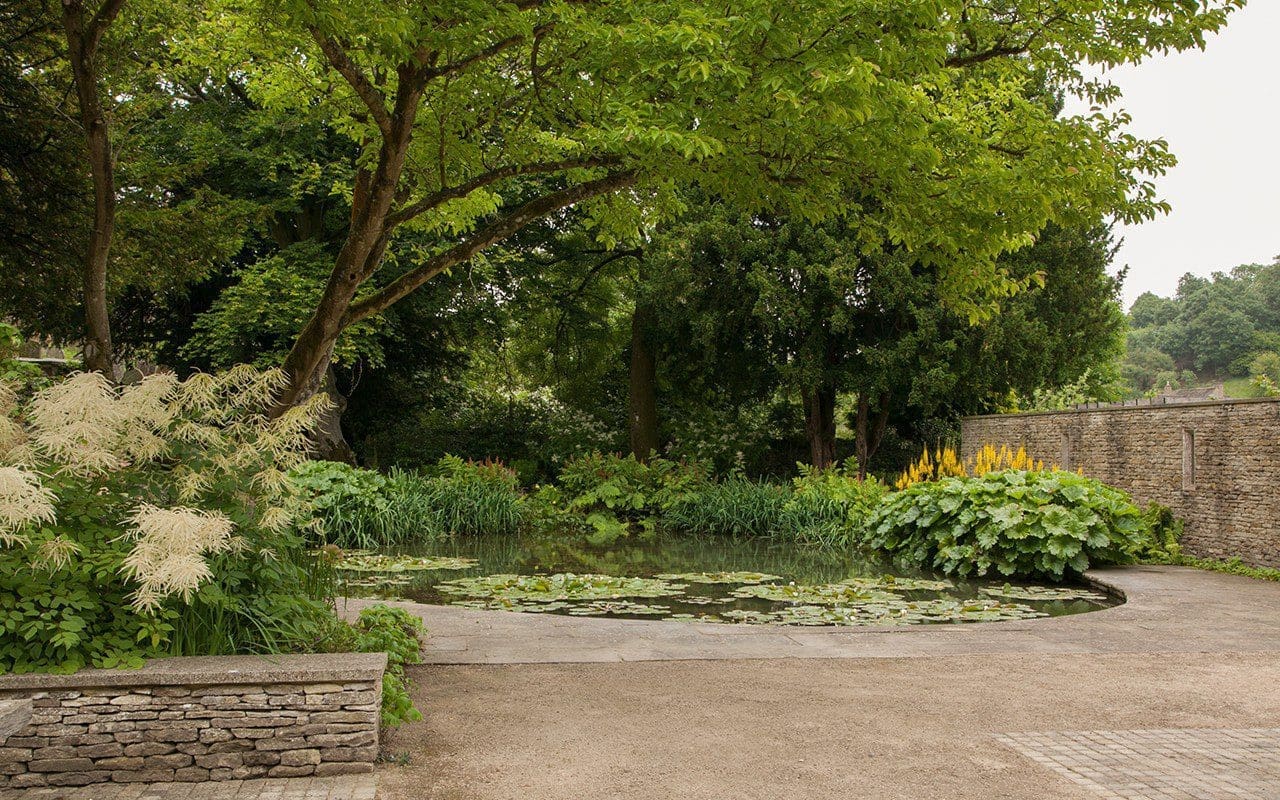
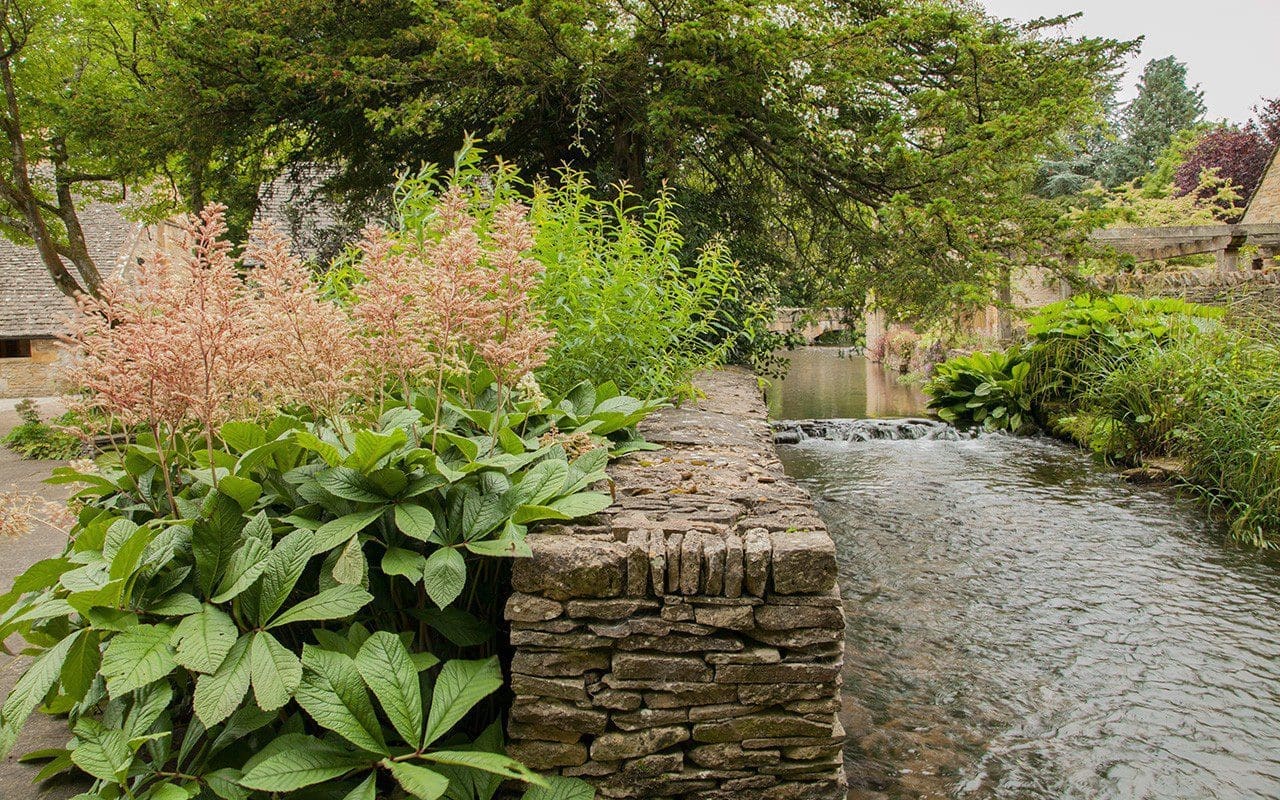
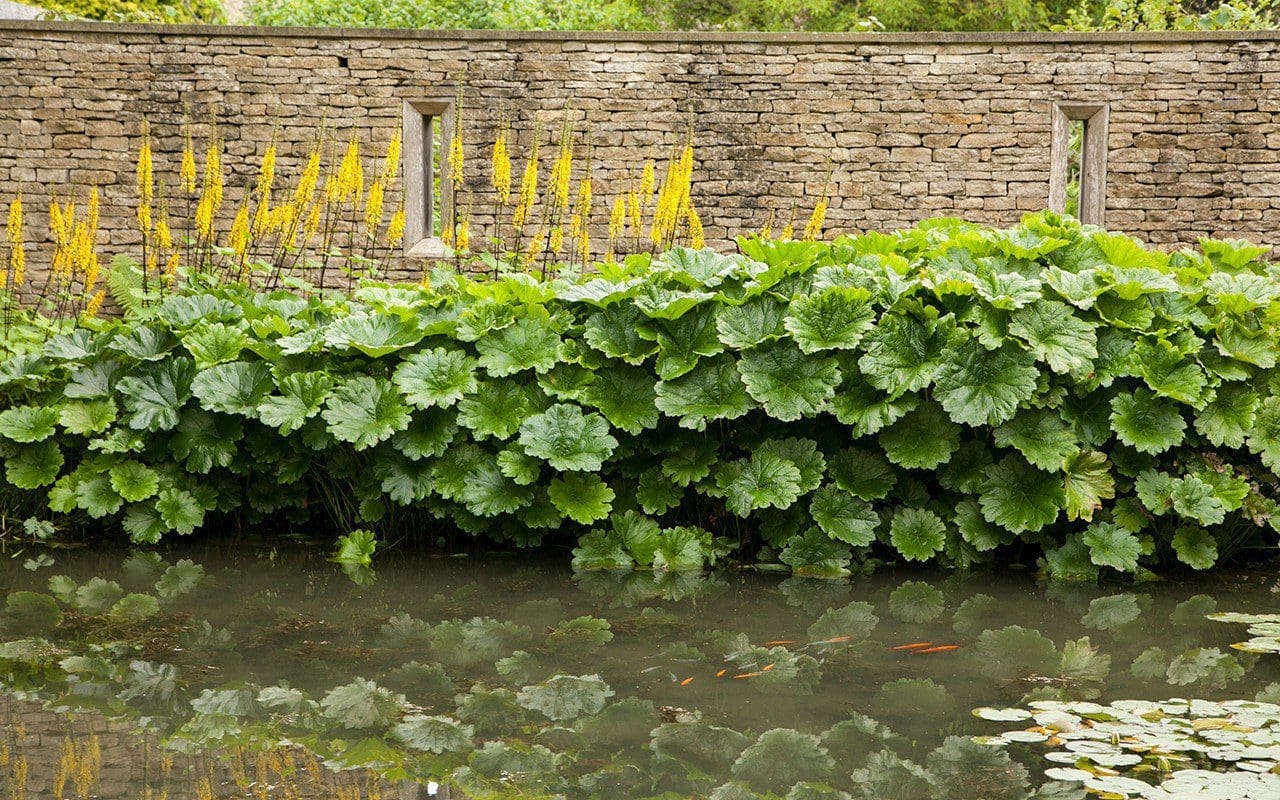
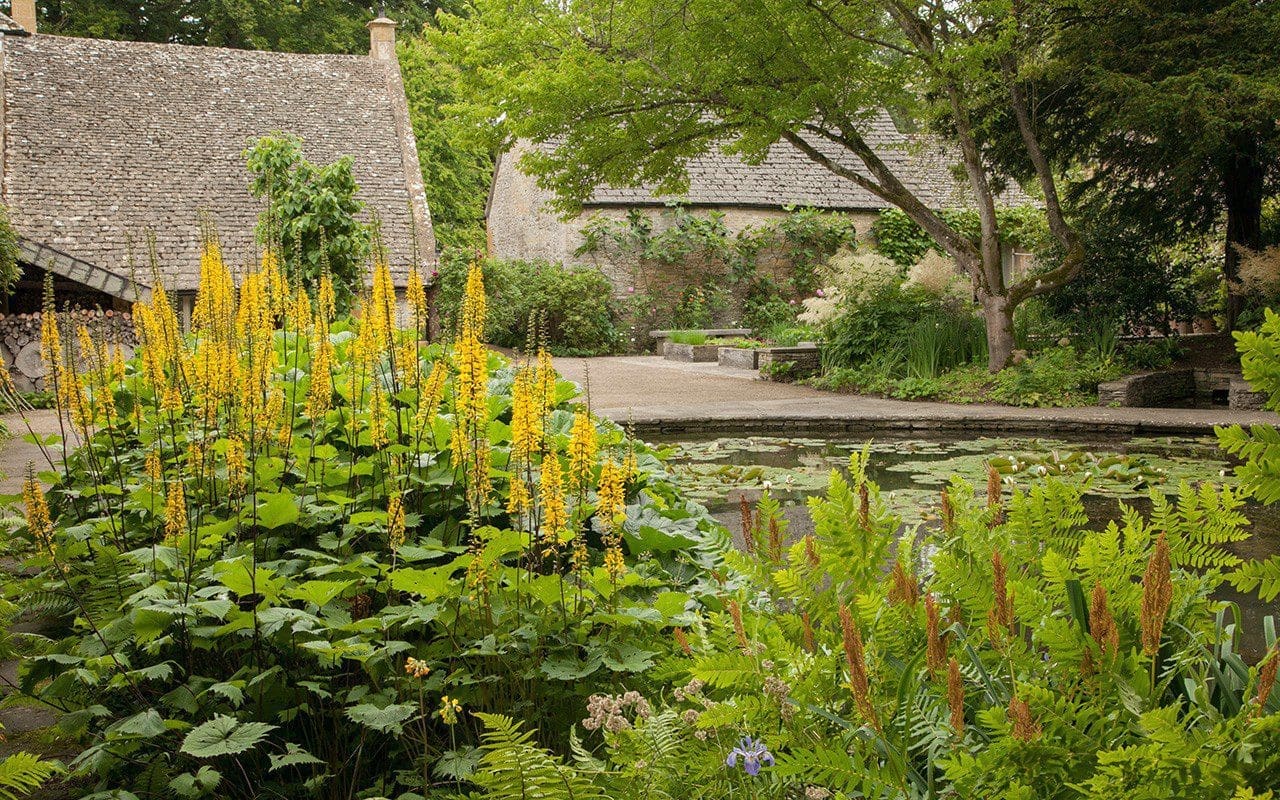
At the back of the pond a woodland walk planted with Sambucus nigra f. laciniata, Luzula nivea, Vinca minor ‘Gertrude Jekyll’ and Euphorbia amygdaloides var. robbiae leads you to the top of the Canal Garden, where the stone walls enclose a bench and support a pergola on which we are growing a white wisteria. The first one died mysteriously last year and so we are now trying with another. The bench faces the house and gives a view onto the upper half of the garden, which is planted in shades of white and yellow, including Hemerocallis ‘Hyperion’, Chamaenerion angustifolium ‘Album’, the white rosebay willow herb, Selinum wallichianum and white astrantia. Solid structure is supplied by twelve hefty pudding-shaped clipped box.
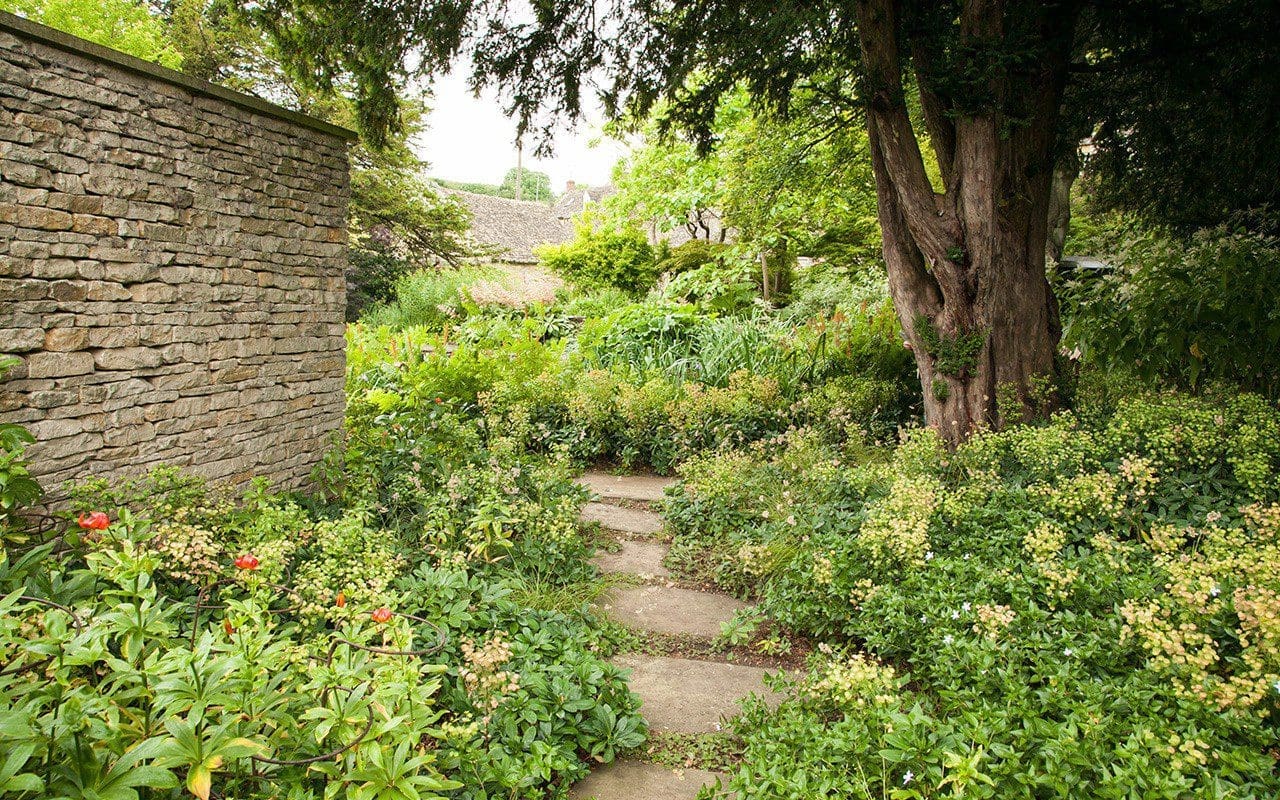
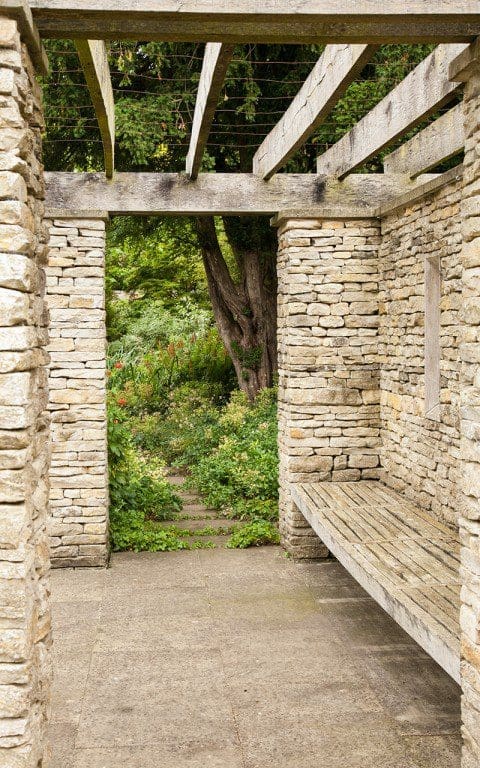

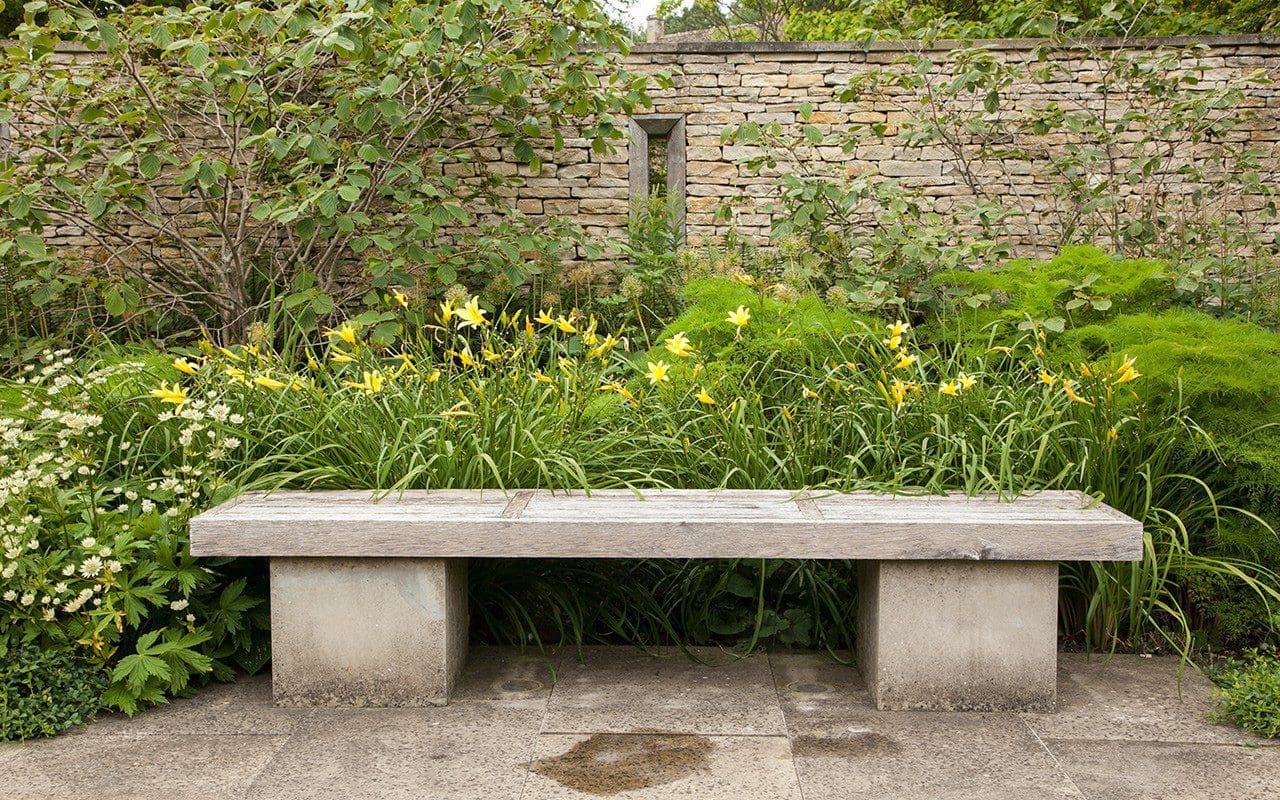
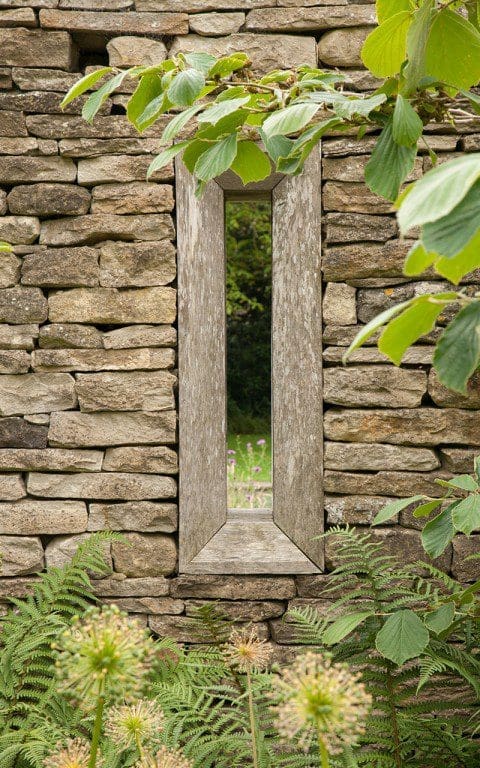
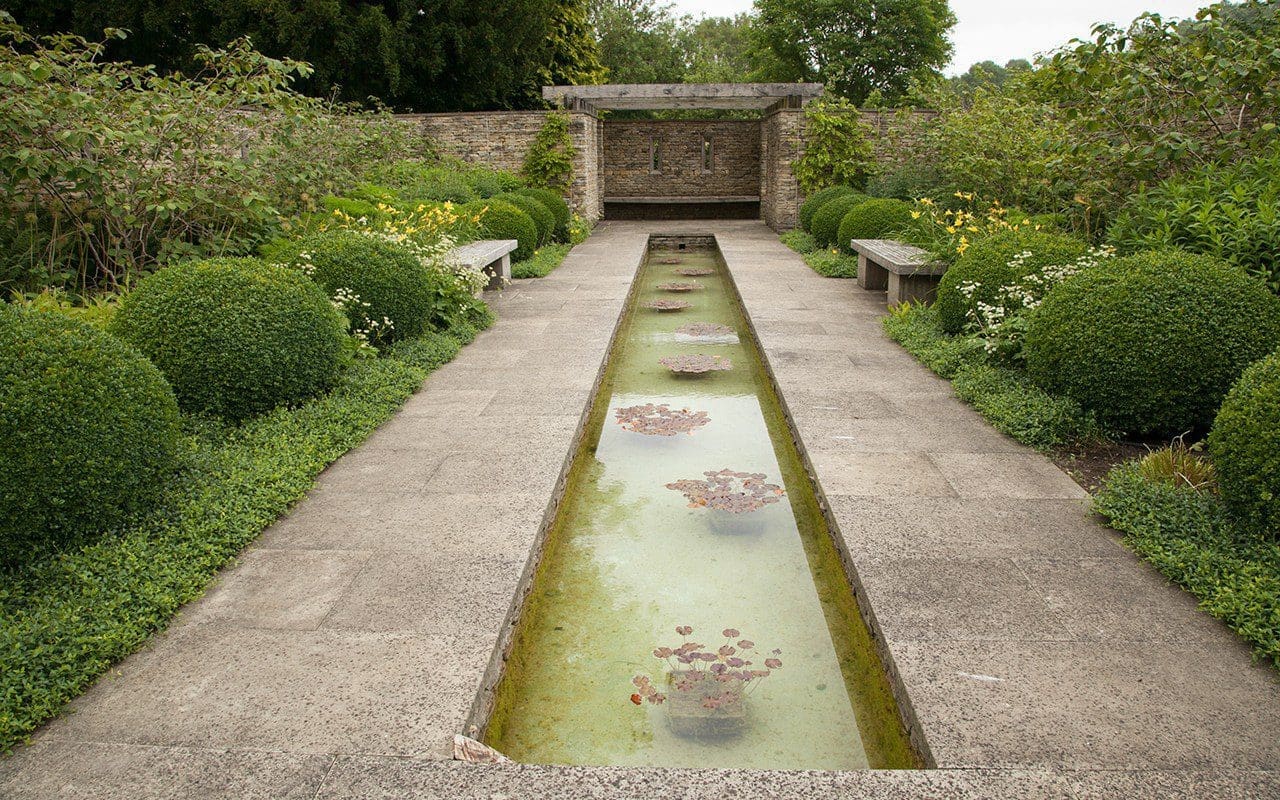
From here you have a choice to explore the far end of the Canal Garden in front of the house, or continue on the boundary circuit which passes through a small nuttery where slabs set into the grass lead you to the top of the swimming pool. Here a stilted, clipped hornbeam hedge shades a wide stone seat with a background planting of white-flowered and scented Choisya ternata and Clematis ‘Marie Boisselot’.
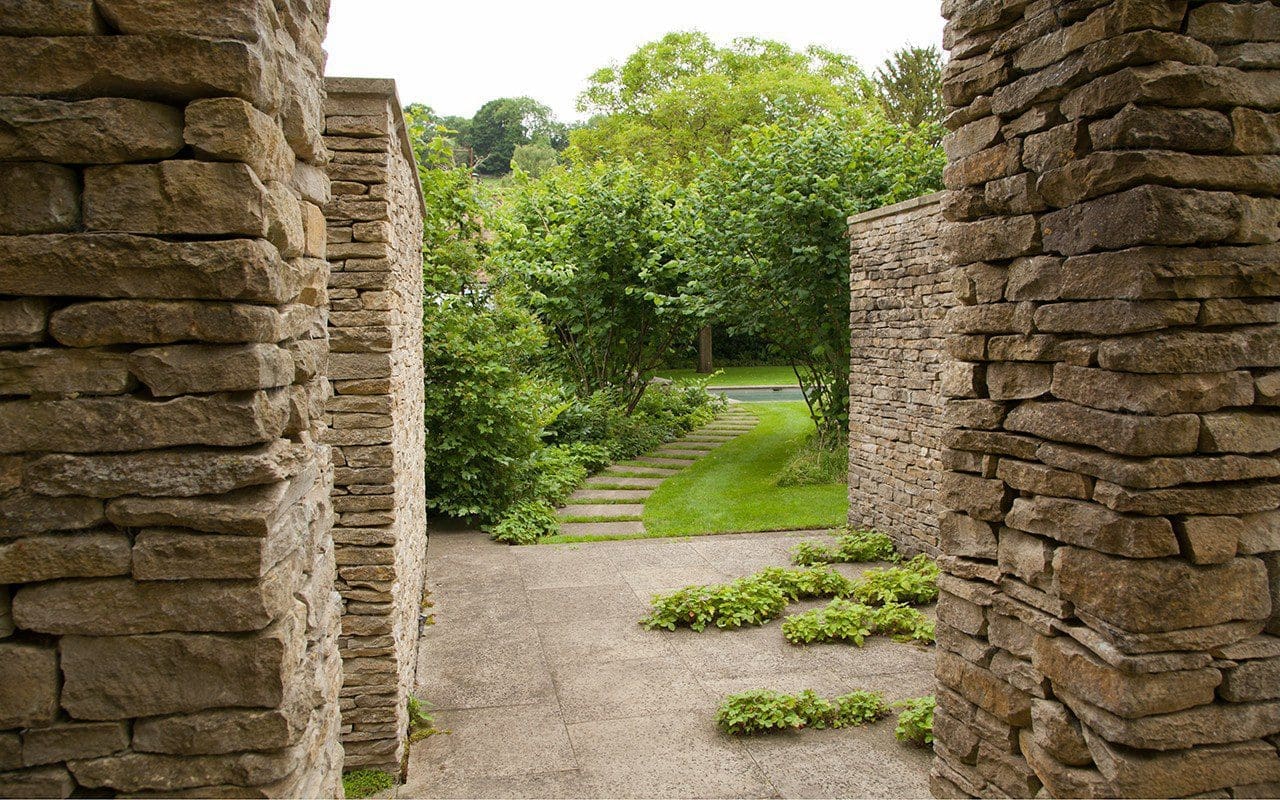

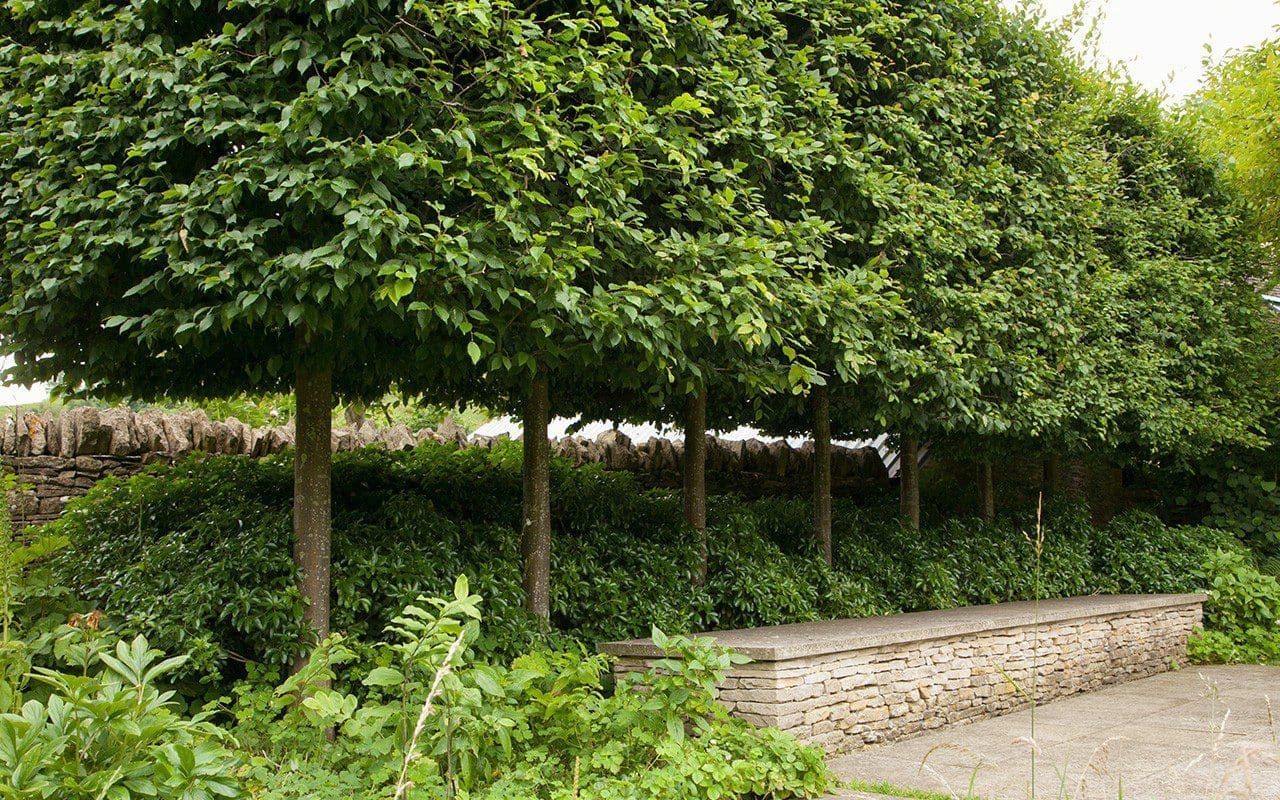
The swimming pool is set in an immaculate lawn with panels of wildflowers into which a number of apple cultivars have been planted. The lawn that was originally in this location is purported to be the one on which Lewis Carroll based the Croquet Lawn in Alice’s Adventures in Wonderland, as he was a friend of the rector and a frequent visitor.
The pool is lined with ceramic tiles the same colour as the stone-tiled roof of the house, giving the water a more recessive sea-green hue than the usual turquoise, which always looks harsh in a British garden. Beyond the pool the Yew Walk takes its name from the line of ancient yews planted against the boundary wall. The trunks were originally cleared of any lower growth to show them to their best advantage. The decidedly tricky area of dry shade beneath them is planted with tough evergreens such as Hedera helix ‘Poetica arborea’, Luzula sylvatica ‘Marginata’ and Dryopteris filix-mas.
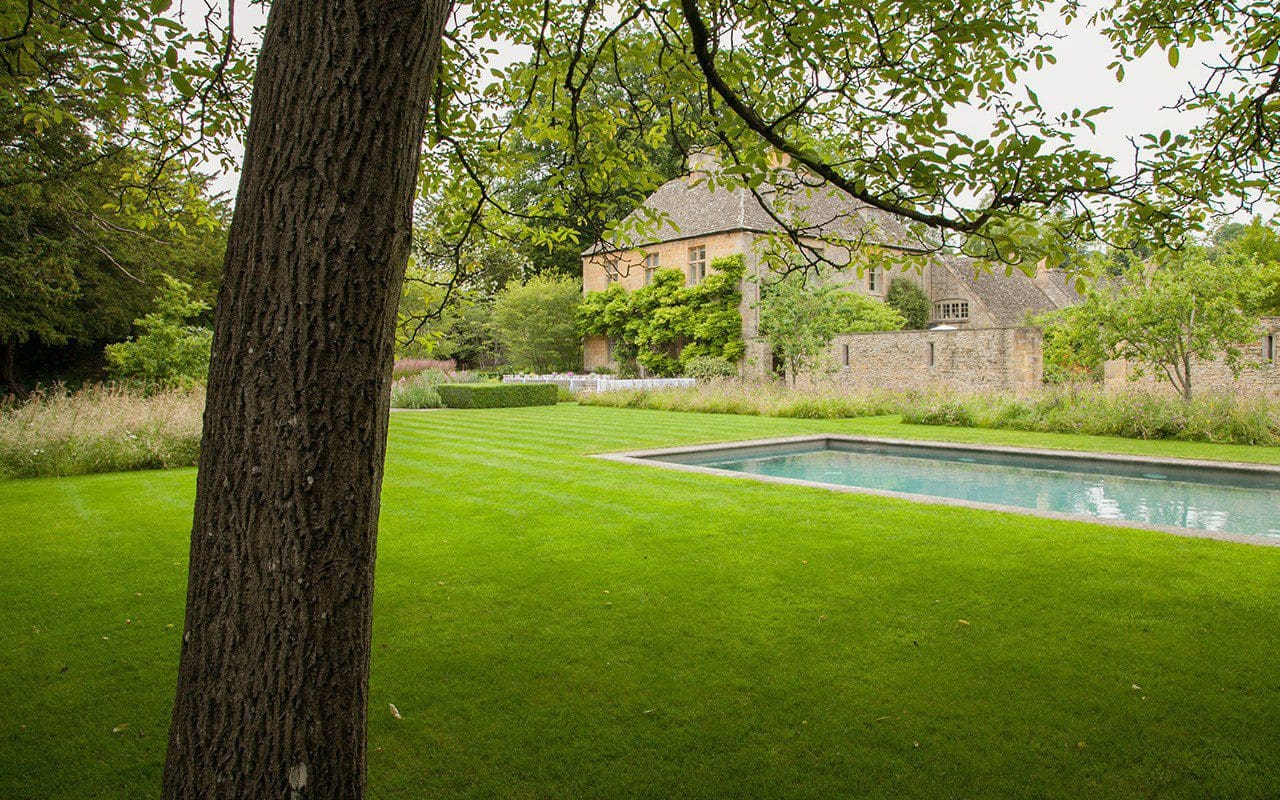
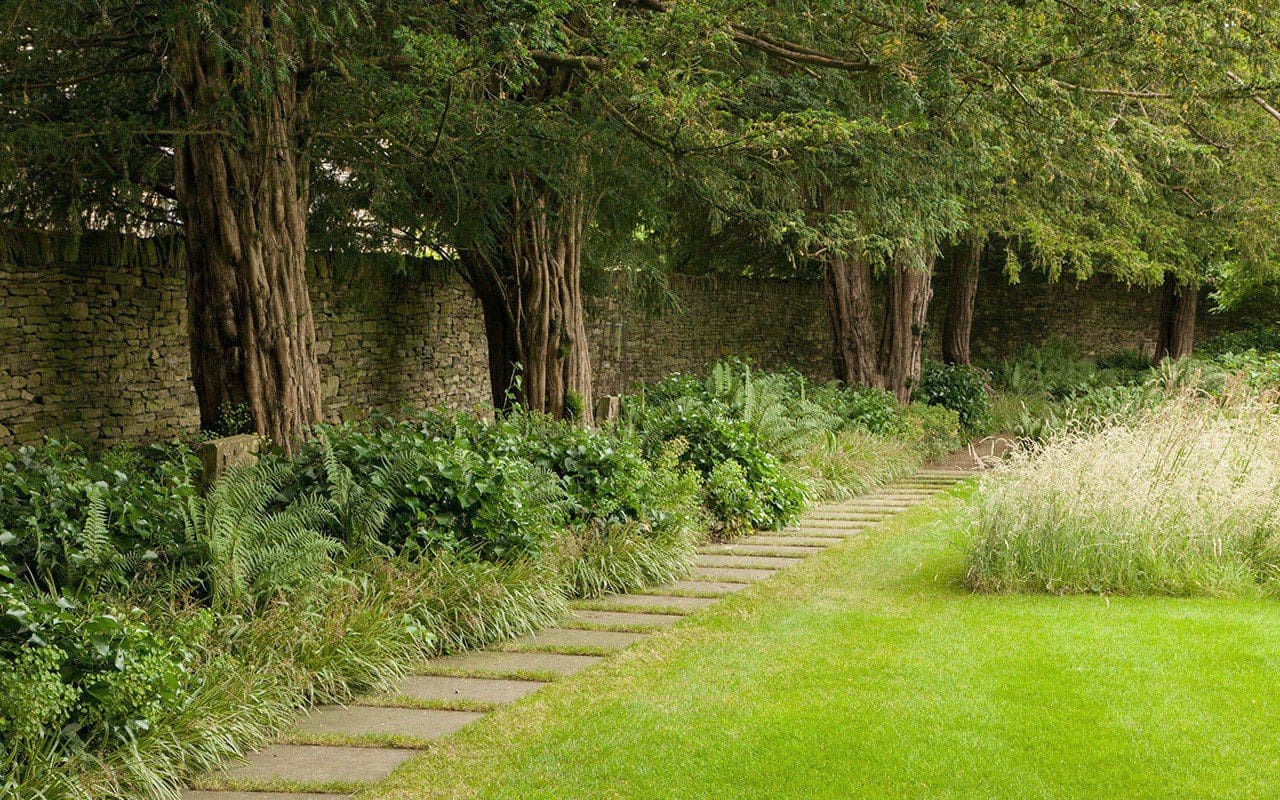
At the end of the Yew Walk the Southern Terrace is punctuated with a number of low plinths of clipped box, which provide a counterpoint to rhythmic plantings of Calamagrostis x acutiflora ‘Karl Foerster’ of exactly the same dimensions. This rectilinear structure, one vertical and static, the other horizontal and mobile, is overlaid with a light and delicate planting in shades of mauve, blue and pink. In the open this consists of of dry-climate plants including Dierama pulcherrimum, Echinops ritro ‘Veitch’s Blue’, Verbena bonariensis, Dianthus carthusianorum and Salvia verticillata ‘Purple Rain’. The shadier side includes Rosa glauca, Veronicastrum virginicum ‘Lavendelturm’, Geranium ‘Patricia’, Thalictrum rochebrunianum, Aconitum ‘Spark’s Variety’ and, for later in the season, Anemone hupehensis var. japonica ‘Splendens’. Towards the front of the house three of the box plinths have multi-stemmed Amelanchier lamarckii growing from their centres. As well as holding the corner of the house these volumes provide both a backdrop and a screen for the seating terrace.


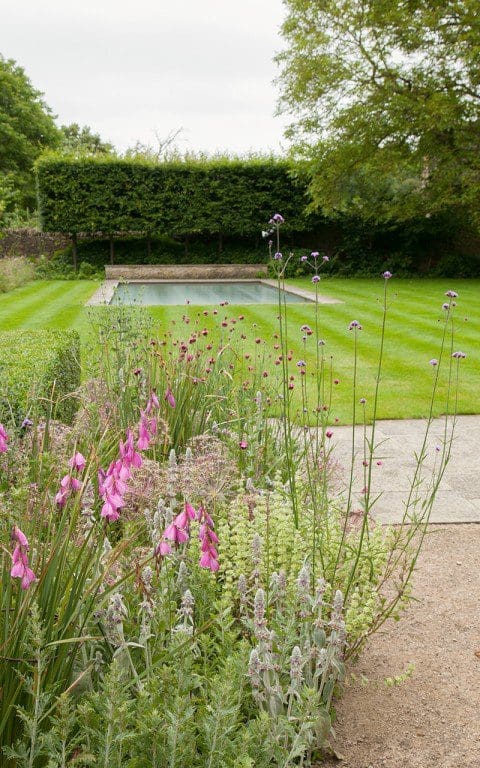
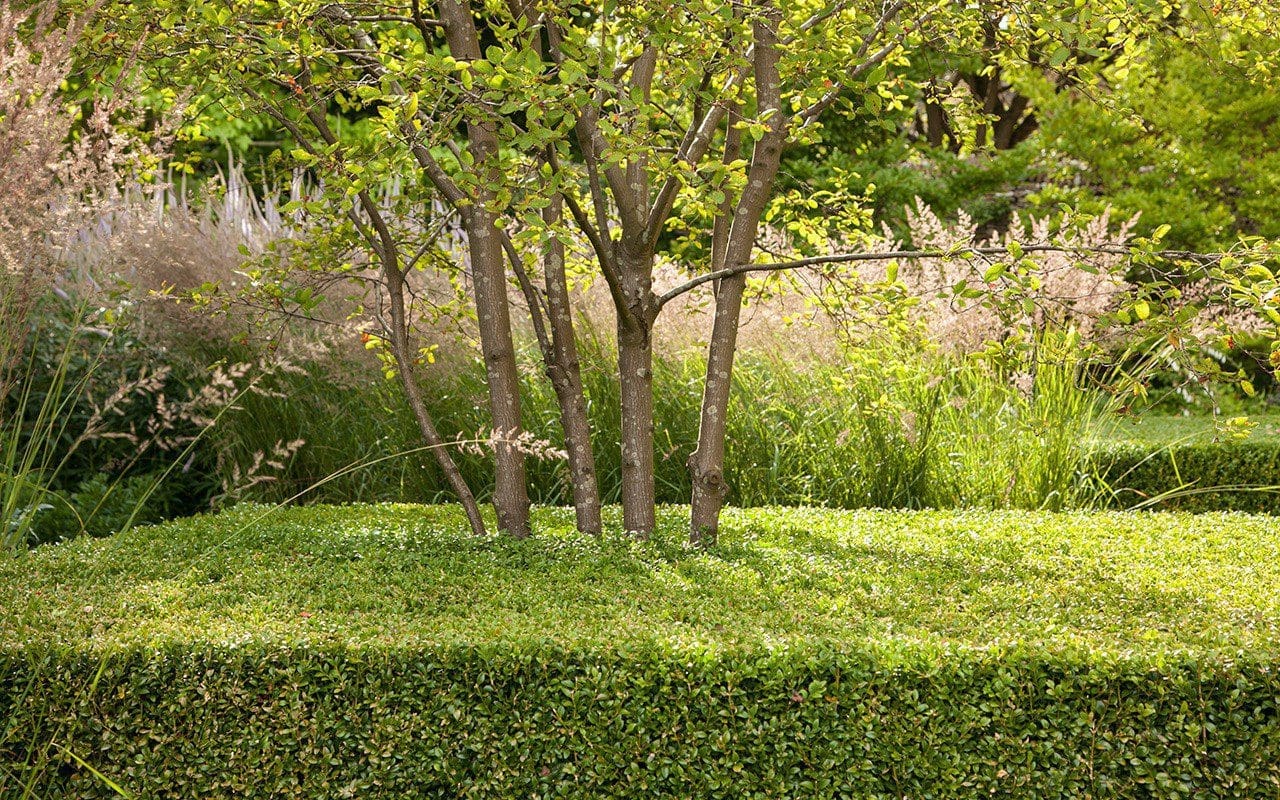
Returning to the back of the house via the wildflower meadow and then through a slot in the dry stone wall you pass beneath the spreading limbs of a Cercis siliquastrum ‘White Swan’ and arrive in the lower half of the Canal Garden. The richly coloured planting scheme here was inspired by Angela’s request to have some Fuchsia magellanica somewhere, a reminder of the summer lanes of her native Ireland. These are wall-trained and underplanted with Astrantia ‘Hadpsen Blood’ and Geranium ‘Patricia’. The beds to either side contain a succession of flowering perennials, shrubs and climbers in shades of scarlet, orange, yellow and bright pink including Persicaria amplexicaule ‘Taurus’, Clematis tangutica ‘Bill Mackenzie’, Sanguisorba officinalis ‘Tanna’, Hemerocallis ‘Stafford’, Knautia macedonica, Crocosmia ‘Lucifer’ and Potentilla fruticosa ‘Gibson’s Scarlet’.
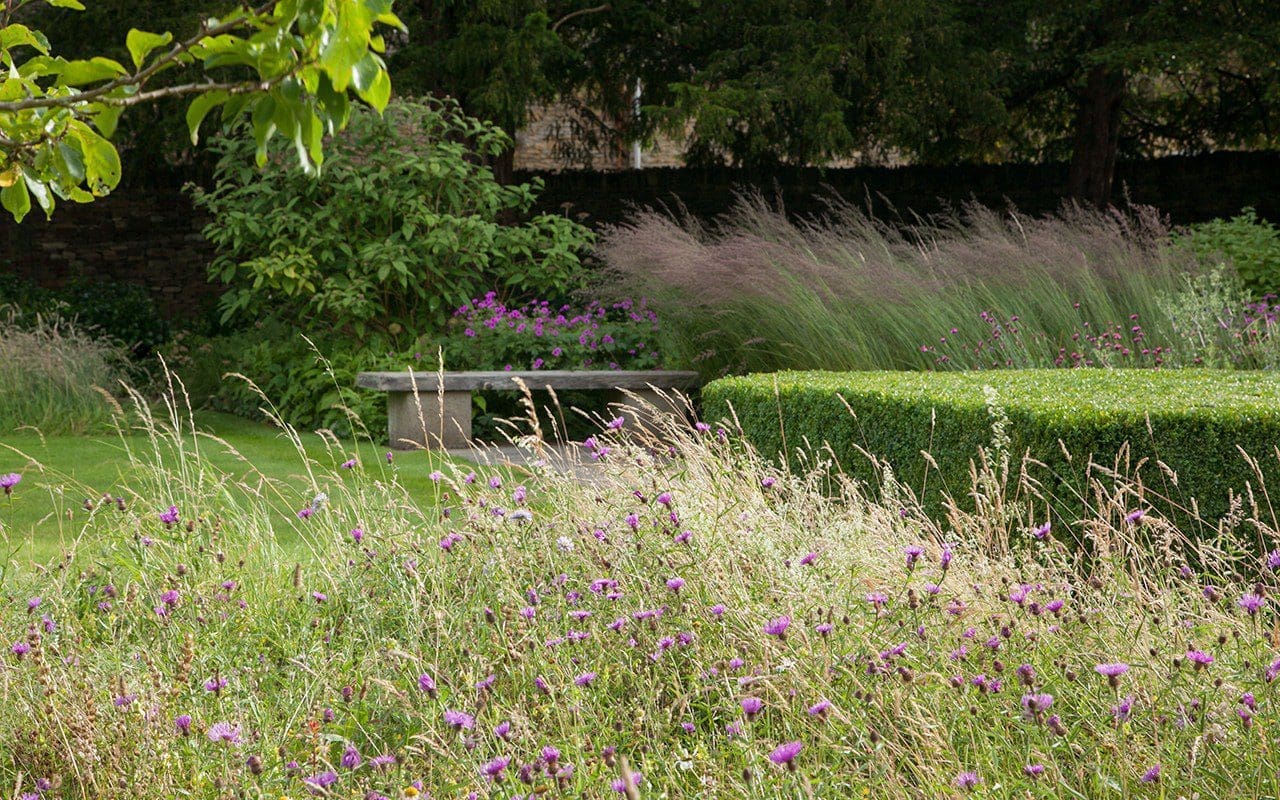
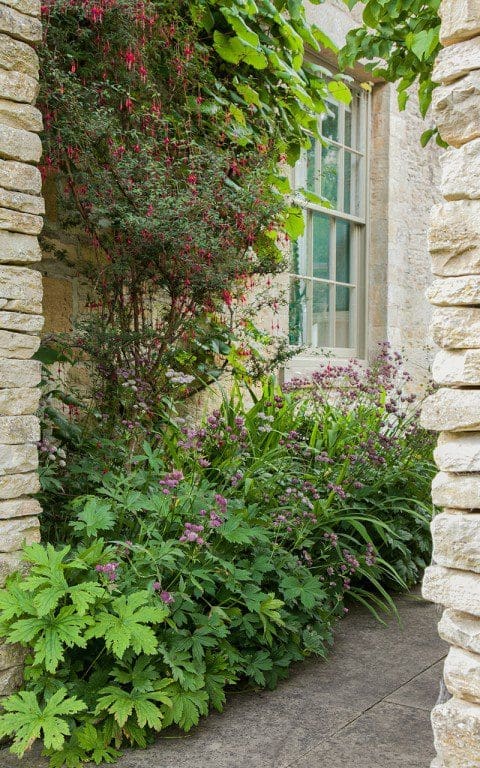
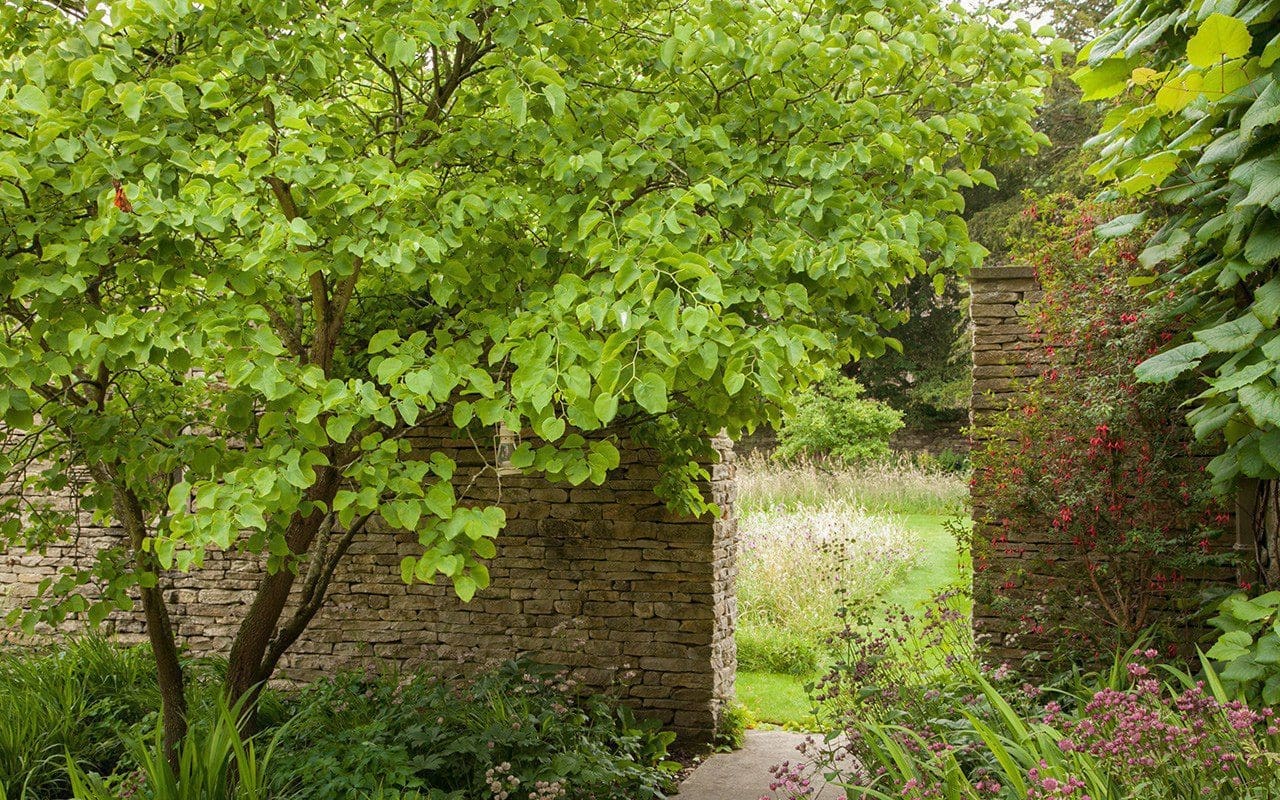


Michael and Angela have been some of our most generous and thoughtful clients and have been completely committed to the collaborative process and the importance of working with people who have the skills to make and maintain a garden like this. Jacky Mills was recommended to me by Fergus Garrett at Great Dixter, due to her keen eye for detail and strong work ethic. She and her partner, Ian, started working with me before the garden was complete and helped to plant it, which has given them a huge sense of investment and a deep understanding of the desired effect. Without them the garden would not be possible. They maintain the garden impeccably on two days a week and bring a lot to the table with their breadth of experience working, as they have, for other designers like Arne Maynard and Sarah Price. They are now helping me with the garden at Hillside.
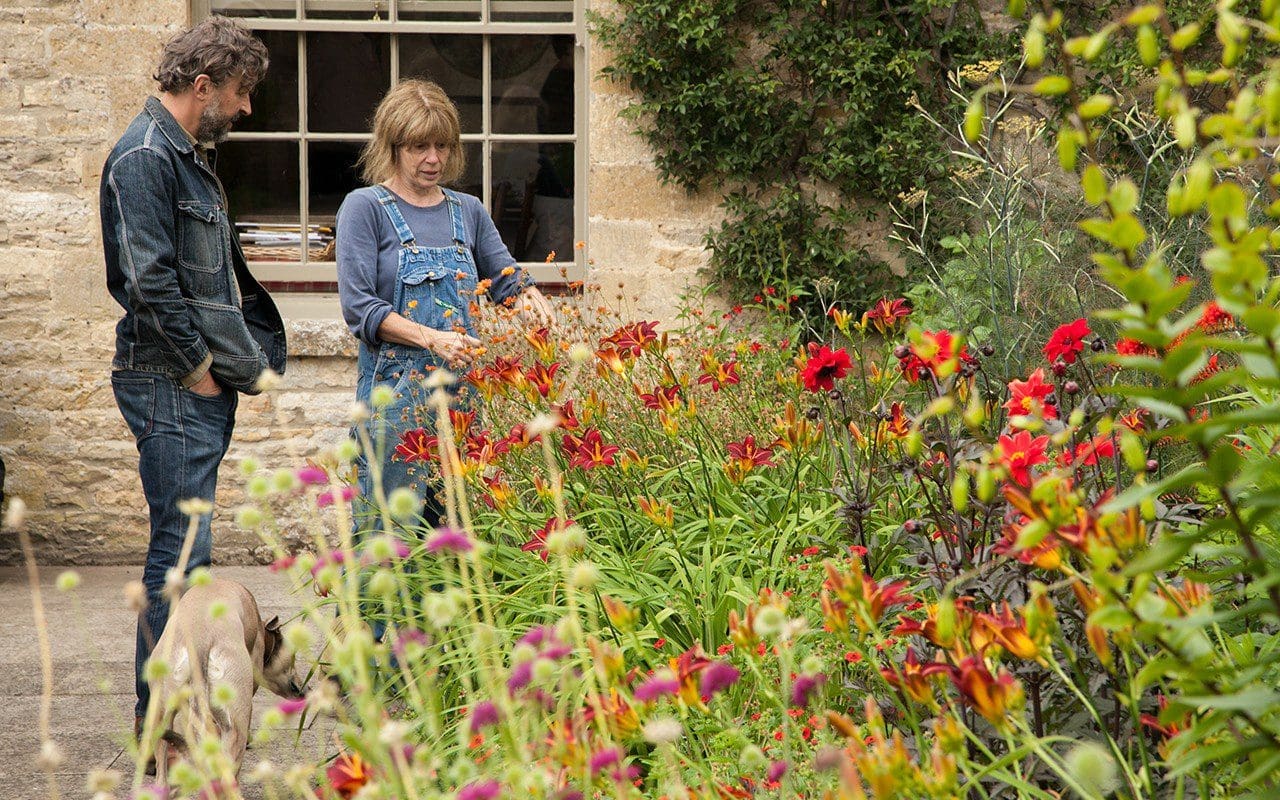
Michael and Angela had the idea to hold a garden party for Jacky and Ian and their friends and colleagues including other designers and gardeners from local and notable west country gardens and so, last week, we spent a magical afternoon chatting, wandering and eating in the garden, in a way that allowed everyone to relax and really feel part of the space.
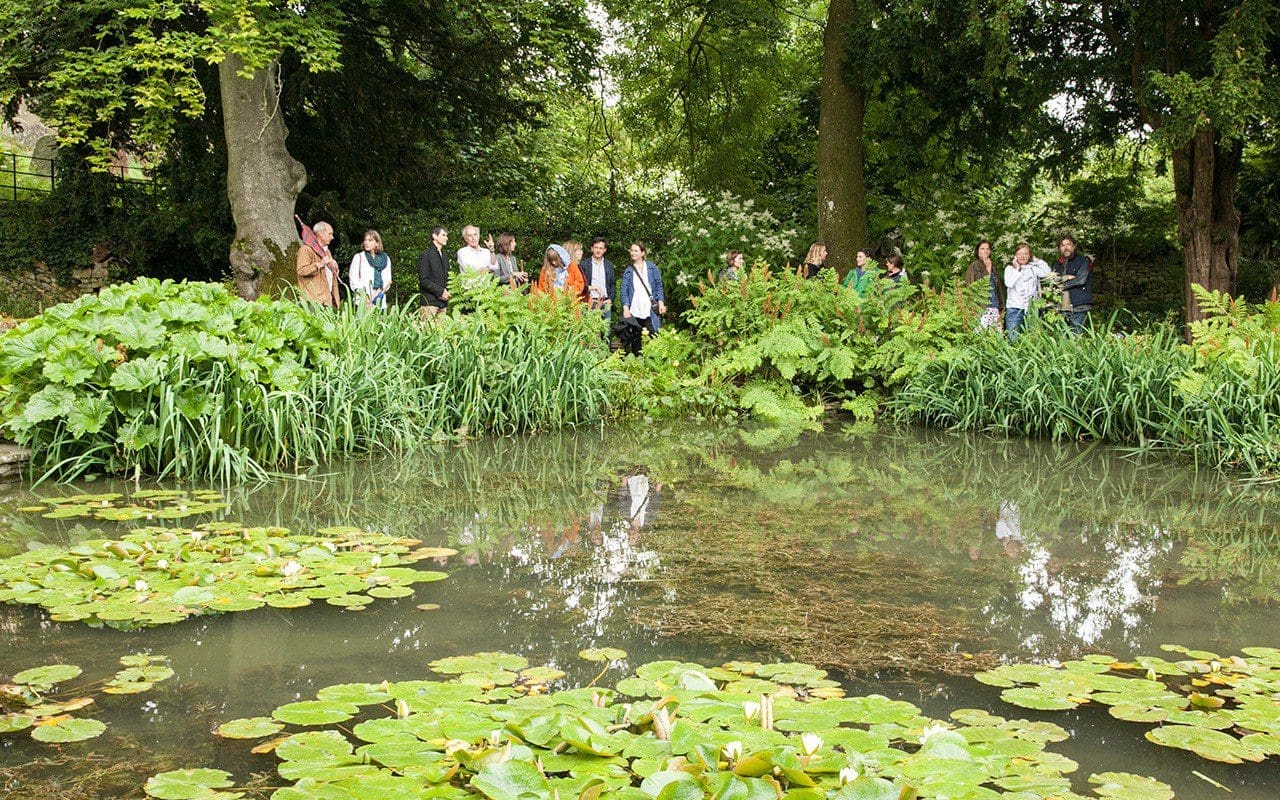
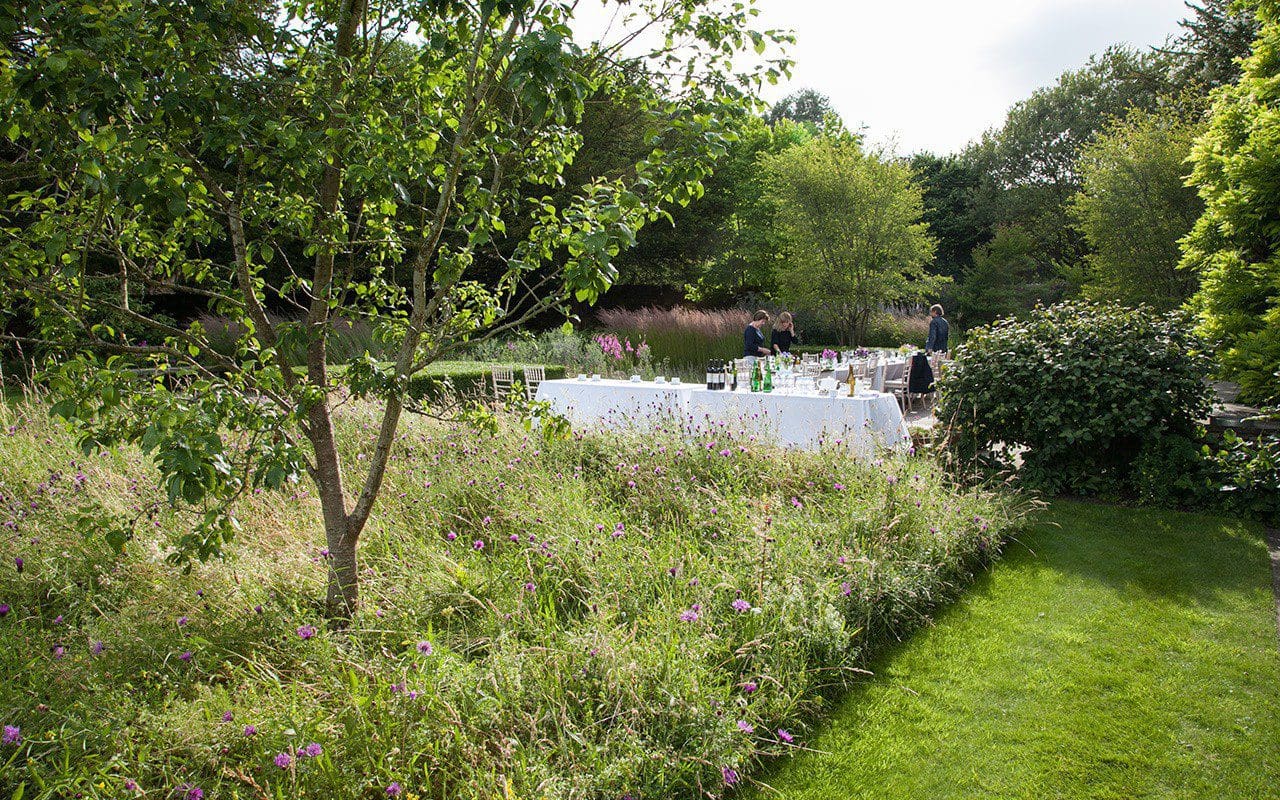
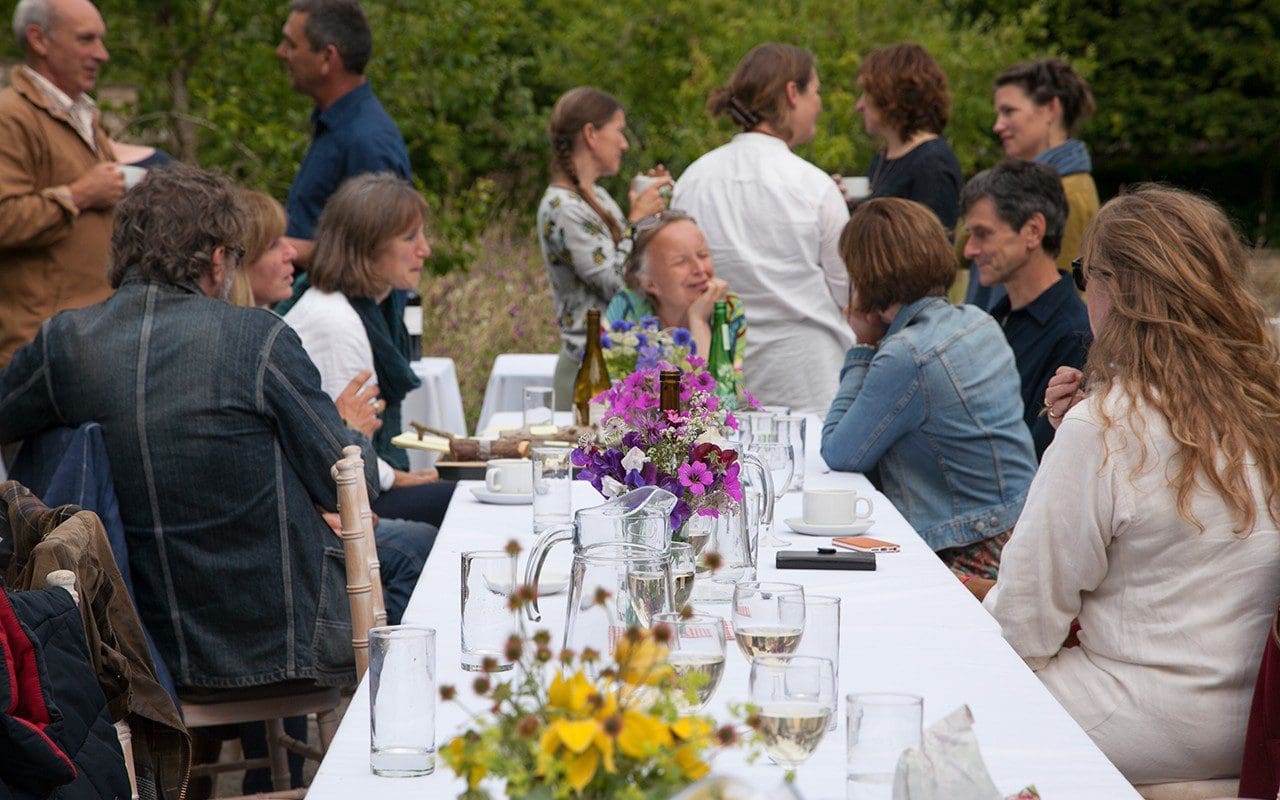 Words: Dan Pearson / Photographs: Huw Morgan
Words: Dan Pearson / Photographs: Huw Morgan